Introduction
In the realm of data analysis, the ability to generate dynamic sequences of numbers can be a game-changer for organizations striving for operational excellence. The GENERATESERIES function in DAX emerges as a powerful ally, enabling users to create single-column tables filled with sequential numeric values, tailored to their specific needs. This function not only simplifies complex calculations but also enhances data modeling within Power BI, setting the stage for insightful analytics that drive strategic decisions.
As organizations navigate the intricacies of data management, mastering GENERATESERIES can unlock new levels of efficiency, empowering teams to transform raw data into actionable insights and fostering a culture of informed decision-making that propels business growth.
Understanding the GENERATESERIES Function in DAX
The dax generateseries feature in DAX is a powerful tool designed to create a single-column table filled with sequential numeric values. Its syntax is straightforward: <Start>, <And>, <Increment>. Here, <Start> indicates the initial value, <And> represents the final value, and <Increment> specifies the step size between values.
This procedure plays a vital role in producing dynamic sequences of numbers, which are necessary for various computations, visualizations, and modeling tasks within Power BI. Significantly, users should recognize that a maximum of 99,999 rows can be returned per query, highlighting the necessity for effective information modeling practices that improve operational efficiency.
By mastering dax generateseries, users can unlock the full potential of DAX, leading to the creation of robust models that enable insightful analytics. For example, in practical applications, it enables users to create timelines, dax generateseries for forecasting, or establish ranges for visualizations—key elements in driving data-driven insights that propel business growth. The capability to handle these calculations effectively is additionally illustrated by recent improvements in DAX operations, which boost overall performance and enable users to address issues related to time-consuming report creation and information inconsistencies.
This is especially pertinent in the context of the ‘Query Tabs’ feature, which supports multiple queries, enabling users to manage and utilize the series generation tool more effectively, thereby enhancing productivity and operational insight. Furthermore, integrating RPA solutions like EMMA RPA and Power Automate can automate repetitive tasks related to manipulation, thereby improving efficiency. As mentioned by Data Science enthusiast Douglas Rocha, ‘Last but certainly not least is the Mode,’ which highlights the significance of choosing the appropriate operations for effective utilization of information, especially when dax generateseries is utilized.
Ultimately, comprehending and utilizing dax generateseries capability can greatly enhance modeling efficiency, allowing Directors of Operations Efficiency to leverage actionable insights for informed decision-making and innovation.
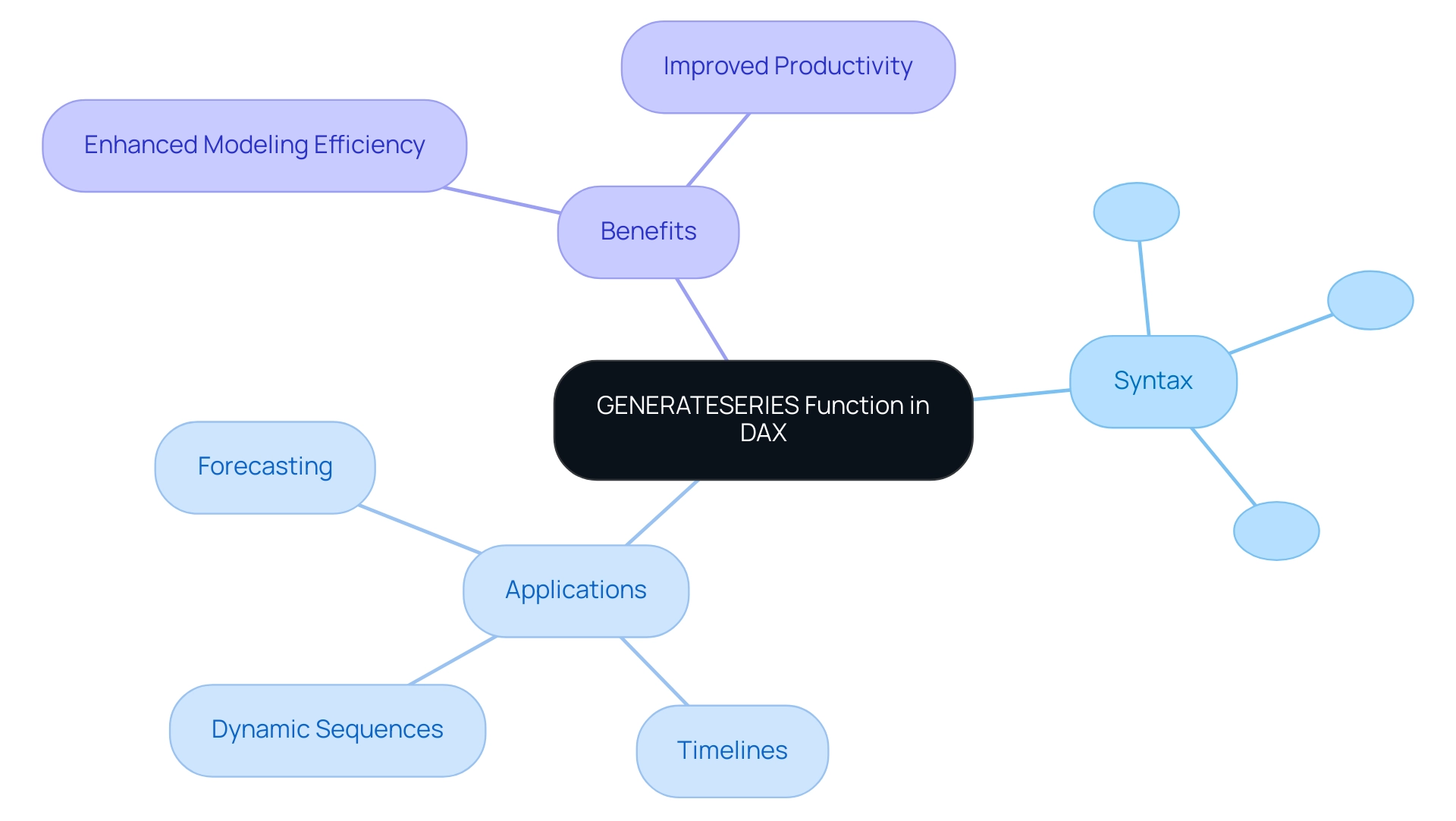
Practical Applications and Examples of GENERATESERIES in Power BI
The GENERATESERIES function in Power BI offers versatile applications that can significantly enhance your data analysis capabilities, especially in the context of driving operational efficiency and extracting actionable insights:
-
Dynamic Date Ranges: The dax generateseries function is essential for facilitating the generation of a continuous series of dates, which is crucial for time intelligence calculations. For instance, using
DATE(1, 1, 1)toDATE(1, 1, 1)with an interval of 1 enables the creation of a comprehensive calendar table for the year, providing a robust framework for time-based analysis that can inform strategic decisions. -
Custom Bins: Another powerful application of the dax generateseries function is in the creation of custom bins for numerical datasets. For example, to classify sales data into defined ranges, the method can be utilized as follows:
0, 1000, 100. This effectively segments sales into bins such as 0-100, 101-200, and so on, allowing for clearer insights into sales performance and trends, thus addressing common challenges in reporting. -
Parameter Tables: Additionally, you can utilize the dax generateseries function for crafting parameter tables that support what-if analysis. By dynamically adjusting values such as discount percentages or interest rates, you enhance the interactivity and responsiveness of your reports, enabling more informed decision-making. This approach not only enriches your analytics but also empowers your team to explore various scenarios effectively, contributing to a culture of data-driven insights.
Furthermore, the popularity of this feature is underscored by the fact that the related message received 4,485 views, indicating significant interest in its applications. However, users should be cautious of the ‘sampling monster,’ as noted by Power BI expert lbendlin: “You have fallen victim to the sampling monster. Nothing you can do about it – except for using (much) smaller ranges or larger interval steps.”
This caution is especially pertinent considering a case study where a user faced a problem with the function, leading to unexpected outputs when larger values were inputted. The problem was attributed to the ‘sampling monster,’ highlighting the importance of using smaller ranges or larger interval steps to achieve accurate results.
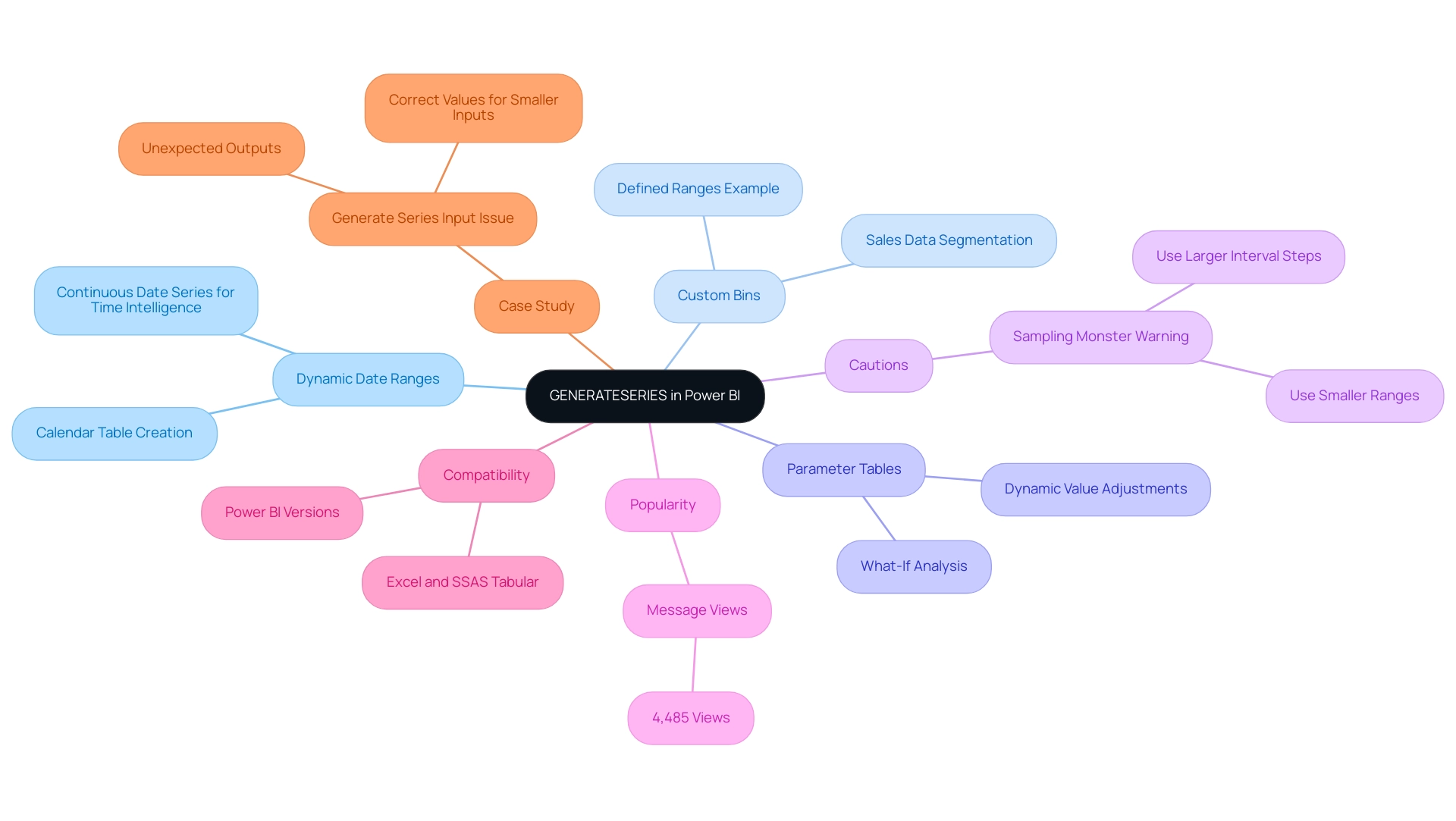
Advanced Techniques: Leveraging GENERATESERIES for Complex Data Models
To effectively utilize the potential of the series generator in advanced information scenarios while leveraging Robotic Process Automation (RPA) for improved operational efficiency, consider the following strategies:
-
By utilizing
dax generateseriesin conjunction withCALCULATE, you can craft dynamic measures tailored to user-selected parameters. This combination allows for more nuanced insights, adapting to the variables and filters applied by users, ultimately enhancing the decision-making process. RPA can automate information collection and processing, ensuring that the details feeding into these measures are timely and accurate. As experts suggest, it is vital to test extensively to validate formulas in different contexts for accuracy, ensuring that your insights are reliable. Moreover, automating these processes usingdax generateseriesreduces the likelihood of human error, freeing up your team to focus on more strategic tasks. -
Combining with FILTER: Utilize
dax generateseriesto establish complex filtering conditions based on external criteria. For example, the expressionFILTER(Sales, Sales[Amount] > SERIES(0, 1000, 100))offers a robust method to extract insights from sales information that surpass specific thresholds, allowing focused analysis of performance metrics. By automating this process through RPA, you can ensure consistent information analysis without manual intervention, which drives operational efficiency and mitigates the risks associated with repetitive manual tasks, especially whendax generateseriesis utilized for data management. -
Dynamic Chart Axis: Utilizing a
dax generateseriesfunction allows for the creation of dynamic axes within visual representations. This functionality not only improves presentation but also provides users the flexibility to interactively adjust ranges, resulting in a more engaging user experience. A pertinent case study is the Time Series Analysis, where DAX functions likeTOTALYTDandSAMEPERIODLASTYEARcan be utilized alongsidedax generateseriesto analyze trends over time, identifying patterns and seasonality within sequential information points.
As Yash Sinha emphasizes,
Master analytics and tech with top-notch resources in Power BI, SQL, Machine Learning, and AI. Enhance your abilities and remain ahead in the information game!
These techniques exemplify how advanced DAX capabilities, combined with RPA, can transform your insights, enabling more informed decision-making and driving business growth while addressing the challenges posed by manual workflows.
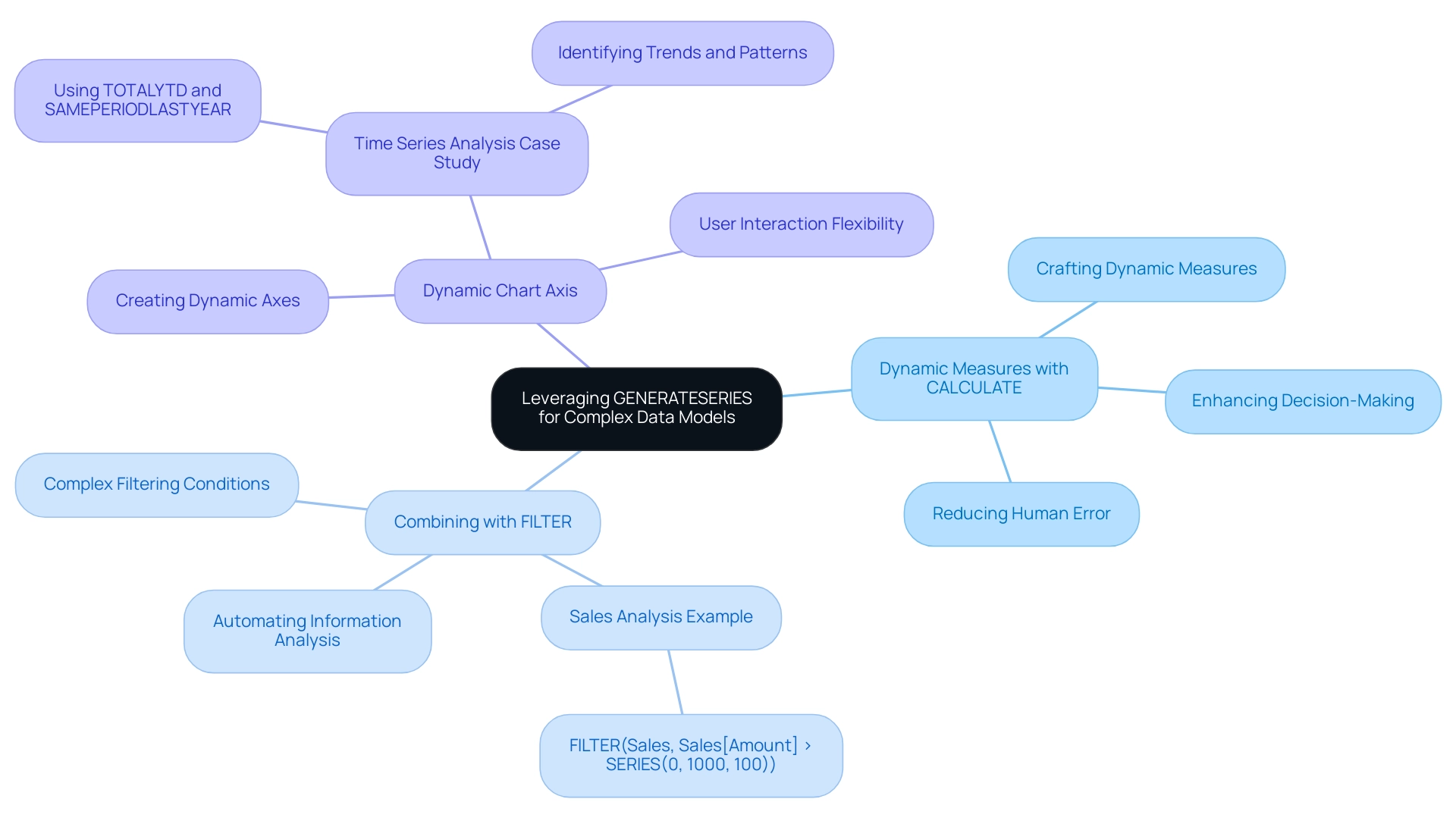
Troubleshooting Common Issues with GENERATESERIES
When employing the dax generateseries feature in DAX, several common issues may arise that can hinder performance and accuracy. Here are the key challenges and their solutions:
-
Incorrect Syntax: It’s crucial to verify that the start, end, and increment values are accurately defined and compatible in terms of type. Misconfigurations in syntax can lead to errors or yield unexpected outcomes. Ensuring precision in these definitions is essential for generating reliable results.
-
Performance Issues: Generating large series can adversely impact performance. To enhance efficiency and overcome technology implementation challenges, it is advisable to limit the numerical range being generated or to utilize calculated columns as an alternative approach. This strategy not only optimizes performance but also simplifies the overall calculation process within Power BI. In fact, creating calculated columns or flags in the backend can significantly improve performance, as demonstrated in the case study titled “Work Upstream for Complex Calculations.” Moreover, Robotic Process Automation (RPA) can be employed to automate repetitive tasks associated with DAX implementations, reducing the likelihood of manual errors and further streamlining the process.
-
Data Type Mismatches: Alignment of types across DAX operations is essential. For instance, using an integer in place of a decimal can result in calculation errors. Ensuring that data types are consistent is a fundamental practice that can prevent complications during analysis.
Additionally, for virtual relationships, it is suggested to use TREATAS instead of INTERSECT or FILTER to maintain filter context effectively, which is essential for optimizing DAX operations.
Mazhar Shakeel aptly notes, > Remember, Power BI is a tool that rewards careful planning and thoughtful design. < By addressing these common issues with foresight and strategic adjustments, you can significantly enhance the effectiveness of your DAX implementations and use dax generateseries to optimize performance in your reports. Embracing tailored AI solutions and leveraging Business Intelligence tools can further empower informed decision-making, ensuring your operations are both efficient and competitive.
Business Intelligence can convert insights obtained from DAX calculations into actionable strategies that promote growth. It is also important to note that the LINEST and LINESTX calculations require at least the Jan/Feb 2023 version of Power BI Desktop, which underscores the importance of using the latest tools for optimal performance.
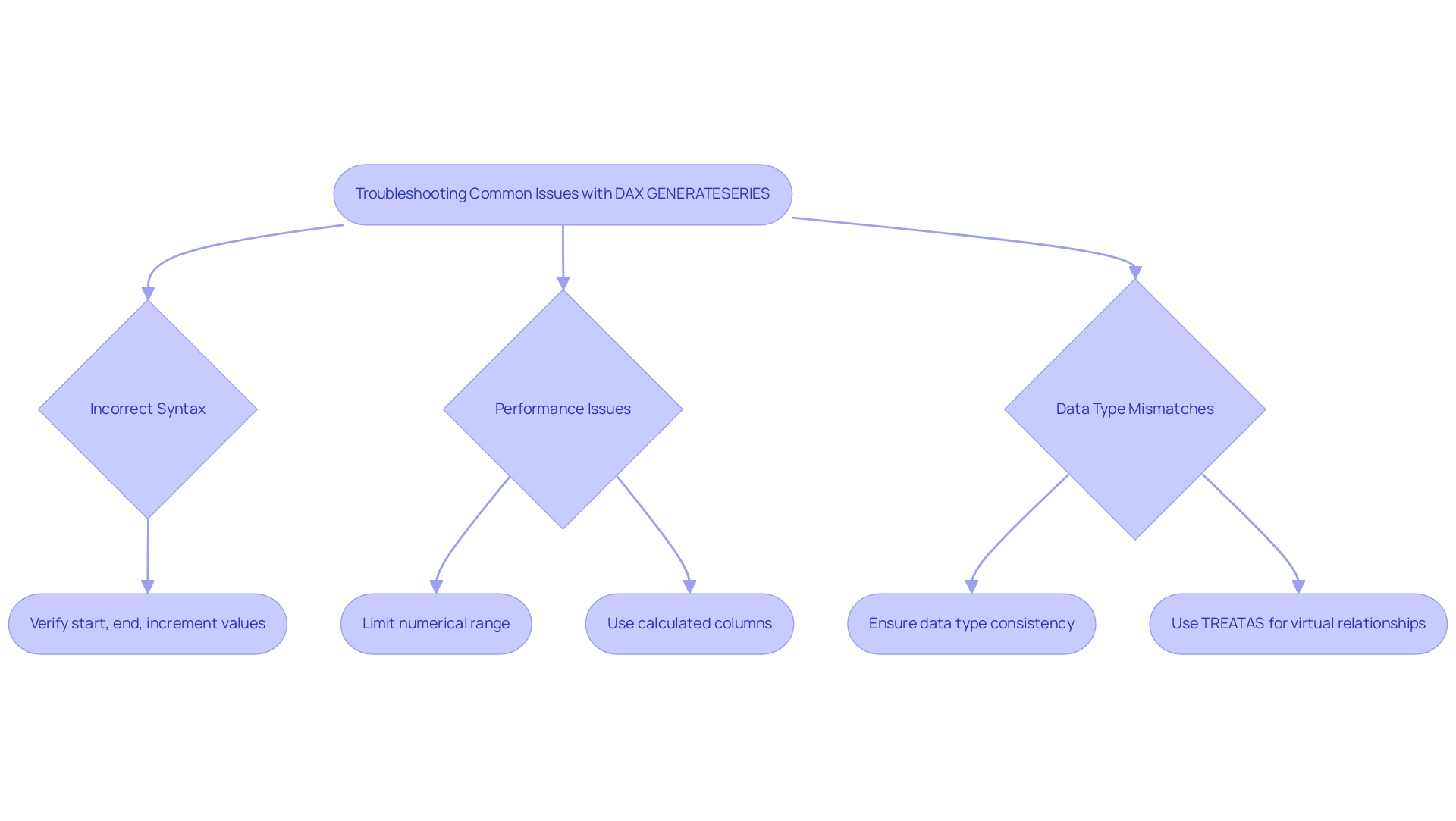
Future Trends: The Evolution of DAX and GENERATESERIES
The evolution of DAX, particularly the GENERATESERIES feature, is poised to be influenced by several significant trends:
-
Increased Integration with AI: As artificial intelligence continues to advance, we can anticipate a deeper integration within DAX functions. This evolution will facilitate smarter information manipulation and enhance predictive analytics capabilities, aligning with the expectations of 70% of individuals who foresee AI accelerating content generation processes. However, it’s crucial to acknowledge that only 39% of U.S. adults believe that current AI technologies are safe and secure, highlighting a common reluctance rooted in perceptions of complexity and cost. Addressing these concerns, including the impact of poor master information quality on AI effectiveness, will be essential for successful AI adoption.
-
Enhanced User Interfaces: The future of DAX also points toward improved user interfaces, making DAX formulas more accessible for non-technical users. This development is crucial, especially as 88% of consumers now expect brands to provide self-service portals for quicker solutions. Simplifying DAX tools, such as how dax generateseries, will empower more users to harness their capabilities effectively, reducing the resistance linked to technology implementation.
-
Greater Performance Enhancement: With the ever-increasing volume of information, future updates to DAX will likely focus on performance optimization. Improvements focused on providing quicker calculations and more effective information management will be crucial for sustaining operational efficiency and addressing the increasing demands of users. Leveraging innovative tools, such as Robotic Process Automation (RPA), can significantly enhance workflow efficiency, freeing up resources for more strategic initiatives and addressing issues related to data quality that can hinder AI implementation.
-
Ethical Considerations in AI Integration: As DAX evolves with AI, it is imperative to consider ethical practices, user trust, and regulatory frameworks in AI development. Addressing these challenges will be essential for fostering a positive perception of AI technologies and ensuring that they are implemented responsibly, thus overcoming the barriers to their acceptance.
By staying ahead of these trends, operations leaders can not only improve their analytics capabilities but also build a data-driven culture that leverages Business Intelligence for informed decision-making. This approach will help mitigate the common perceptions that AI projects are time-intensive and costly, positioning their organizations to thrive in an increasingly competitive landscape.

Conclusion
The effective use of the GENERATESERIES function in DAX is essential for organizations aiming to enhance their data analysis capabilities. By mastering this function, teams can create dynamic series of numbers that facilitate a range of applications, from generating custom bins for data segmentation to developing comprehensive date ranges for time-based analysis. Such versatility not only streamlines complex calculations but also supports the creation of robust data models in Power BI, ultimately driving actionable insights that support strategic decisions.
Moreover, integrating GENERATESERIES with advanced techniques like CALCULATE and FILTER allows for more nuanced data analysis, enabling teams to extract meaningful insights tailored to specific criteria. As organizations increasingly adopt robotic process automation (RPA) solutions, they can automate repetitive tasks linked to data manipulation, further enhancing operational efficiency and accuracy. Addressing common challenges such as incorrect syntax and performance issues through careful planning and strategic adjustments ensures that the potential of DAX is fully realized.
Looking ahead, the evolution of DAX, particularly with trends like AI integration and user-friendly interfaces, presents exciting opportunities for operational leaders. By embracing these advancements, organizations can foster a culture of data-driven decision-making, empowering teams to leverage insights for innovation and growth. As the landscape of data analysis continues to evolve, staying informed and adaptable will be key to maintaining a competitive edge.
Introduction
In the world of data analysis, the ability to harness time intelligence functions like DATESMTD in DAX can transform how organizations approach financial metrics and operational efficiency. This powerful function not only facilitates the aggregation of month-to-date data but also empowers Directors of Operations Efficiency to make informed decisions based on real-time insights.
As businesses navigate the complexities of data, understanding how to effectively leverage DAX functions becomes essential for driving actionable insights and enhancing performance tracking. By exploring practical applications, comparing DATESMTD with other time intelligence functions, and addressing common challenges, this article aims to equip professionals with the knowledge needed to optimize their analytical capabilities and streamline operations in an increasingly data-driven landscape.
Understanding the DATESMTD Function in DAX
The DAX (Data Analysis Expressions) includes the datesmtd DAX, which serves as an essential time intelligence tool, creating a table that details dates from the beginning of the month to the present date based on a designated date column. This functionality is particularly advantageous for financial analysis, enabling the calculation of essential metrics like revenue and expenses up to the present day. In a rapidly evolving AI landscape, where identifying the right solutions can be overwhelming, mastering such tools is vital for Directors of Operations Efficiency seeking to harness Business Intelligence to drive actionable insights and streamline operations.
Additionally, understanding the YIELDMAT formula, which returns the annual yield of a security that pays interest at maturity, provides further context for effectively leveraging DAX operations in financial scenarios. By simplifying the aggregation of month-to-date data, the datesmtd DAX enhances the efficiency of performance metrics tracking, allowing organizations to respond promptly to financial trends and make informed decisions. Consider its ability to nest up to 64 layers of operations in calculated columns, significantly expanding your analytical capabilities.
Moreover, the disadvantages of manual workflows, such as inefficiency and susceptibility to errors, can be effectively tackled through Robotic Process Automation (RPA), which enhances the application of DAX in optimizing financial analysis. Staying informed about recent updates and best practices in DAX capabilities further empowers you in optimizing financial analysis, while also aligning with tailored AI solutions that can help navigate the complexities of the AI landscape.
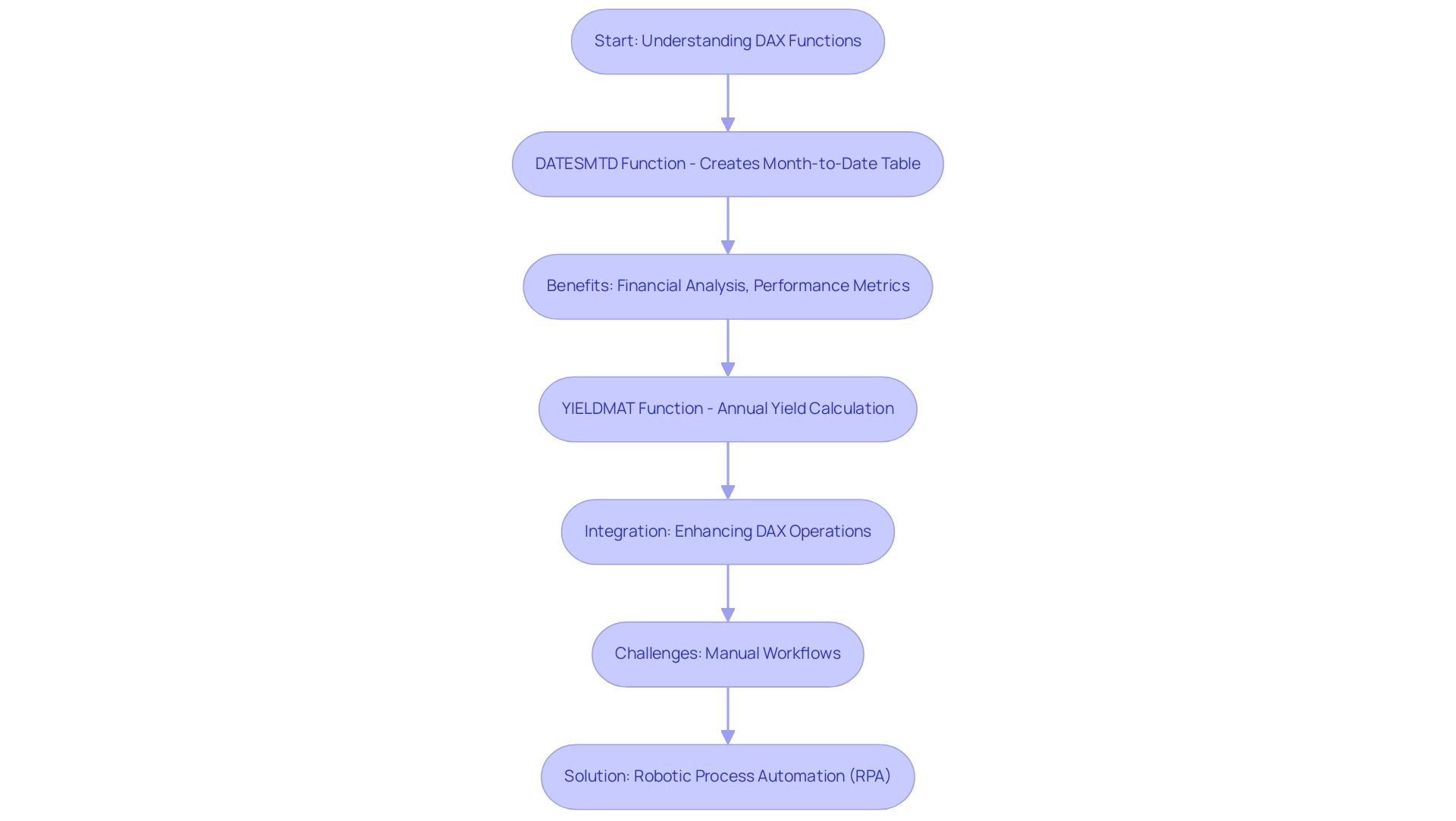
Practical Examples of Using DATESMTD in DAX
Explore these practical applications of the function in DAX to enhance your sales analysis capabilities:
-
Basic Usage: To calculate total sales for the current month, the following formula can be employed:
DAX
total sales MTD = CALCULATE(SUM(Sales[Sales Amount]), DATESMTD(Sales[OrderDate]))
This straightforward formula aggregates the sales amount for all orders placed from the start of the month up to the current date, providing a clear snapshot of monthly performance. For instance, total sales on 2023-06-25 amounted to $1,800, illustrating the effectiveness of this calculation. -
Using DATESMTD with Filters: By combining DATESMTD with additional filters, you can calculate month-to-date sales for a specific product:
DAX
ProductSalesMTD = CALCULATE(SUM(Sales[SalesAmount]), DATESMTD(Sales[OrderDate]), Sales[ProductID] = 1)
In this case, the formula computes the sales for Product ID 1 during the current month, allowing for targeted insights into product performance. -
Incorporating Other Measures: DATESMTD can also be utilized alongside other measures, such as when calculating the average sales per day in the current month:
DAX
avg sales per day MTD = DIVIDE(SUM(Sales[SalesAmount]), COUNTROWS(DATESMTD(Sales[OrderDate])))
This formula provides a more nuanced view of performance trends throughout the month, equipping you with the data needed to make informed operational decisions. Furthermore, the calculation of Total Units Sold MTD can be expressed as:
DAX
TotalUnitsSoldMTD = CALCULATE(SUM(Sales[UnitsSold]), DATESMTD(Sales[SalesDate]))
This reinforces the practical application of DATESMTD in analyzing sales performance.
Additionally, consider the broader context of time intelligence in DAX, as illustrated by the case study on Quarter-to-Date Sales Calculation using the DATESQTD() function. This illustrates the adaptability of DAX expressions in examining sales insights across various timeframes.
As Andrew Hubbard, a data analyst using Microsoft Power BI, wisely observes, “Enhance your analytical skills by diving into the realm of time intelligence through DAX.” Embracing these techniques not only enhances your analytical capabilities but also empowers your strategic decision-making.
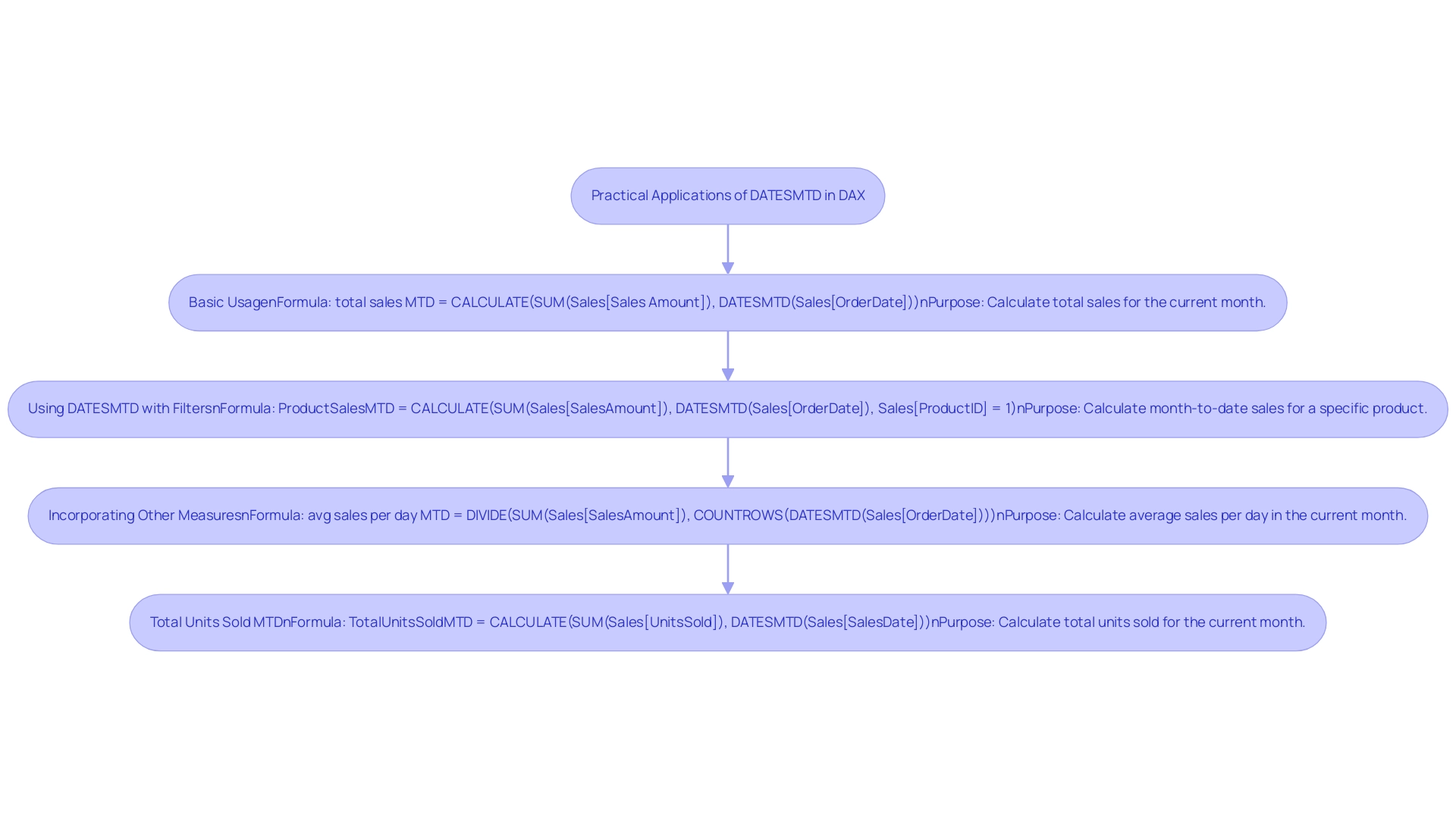
Comparing DATESMTD with TOTALMTD and Other Time Intelligence Functions
Grasping the subtleties between DAX time intelligence tools and others is essential for effective data analysis over time. In a landscape where the significance of Business Intelligence (BI) and Robotic Process Automation (RPA) cannot be overstated, utilizing these DAX capabilities can significantly drive data-driven insights and enhance operational efficiency for business growth. Here’s a closer look at these features:
-
DATESMTD: This utility returns a table of dates from the current month up to the current date. It is particularly useful for month-to-date calculations, allowing analysts to assess performance trends as they unfold, which is critical in today’s data-rich environment where extracting meaningful insights can be challenging.
-
TOTALMTD: In contrast, TOTALMTD calculates the total for the month to date based on a specified expression. This feature is invaluable for aggregating metrics over the month, providing a cumulative view of sales or other key performance indicators. For example, to calculate the month running total for Internet sales, you can use the following formula:
MTD Sales = TOTALMTD(SUM(sales[amount]), 'calendar'[date])
-
PREVIOUSMONTH: This function retrieves dates for the previous month, facilitating month-over-month comparisons. It allows operational leaders to evaluate current performance against the prior month’s results, offering insights into trends and areas for improvement.
-
SAMEPERIODLASTYEAR: Essential for year-over-year analysis, this feature enables comparisons between the current period and the same period from the previous year. It helps in understanding growth patterns and seasonal effects, which are vital for informed decision-making.
Choosing the appropriate function hinges on the specific analysis objectives. For instance, if your goal is to monitor performance trends within the current month, DATESMTD proves to be the ideal choice. On the other hand, for a cumulative total that reflects overall performance, TOTALMTD is the more suitable option. As Dale from the Community Support Team aptly suggested, utilizing both TOTALMTD and SAMEPERIODLASTYEAR can significantly enhance your calculations:
MTD Sales = TOTALMTD(SUM(sales[amount]), 'calendar'[date])
SalesMTDLastYear = CALCULATE([MTD Sales], SAMEPERIODLASTYEAR('calendar'[date]))
This approach not only streamlines your analysis but also enriches your insights, ensuring that you’re well-equipped to drive operational efficiency. Significantly, the interest in this subject is highlighted by a user request for foundational information that garnered 21,085 views, demonstrating the significance and necessity of comprehending these DAX procedures in addressing the difficulties of report generation and information inconsistencies. Furthermore, integrating RPA solutions can automate repetitive tasks, alleviating issues like task repetition fatigue and staffing shortages, ultimately enhancing the effectiveness of your BI efforts and ensuring that raw data is transformed into actionable insights for better decision-making.
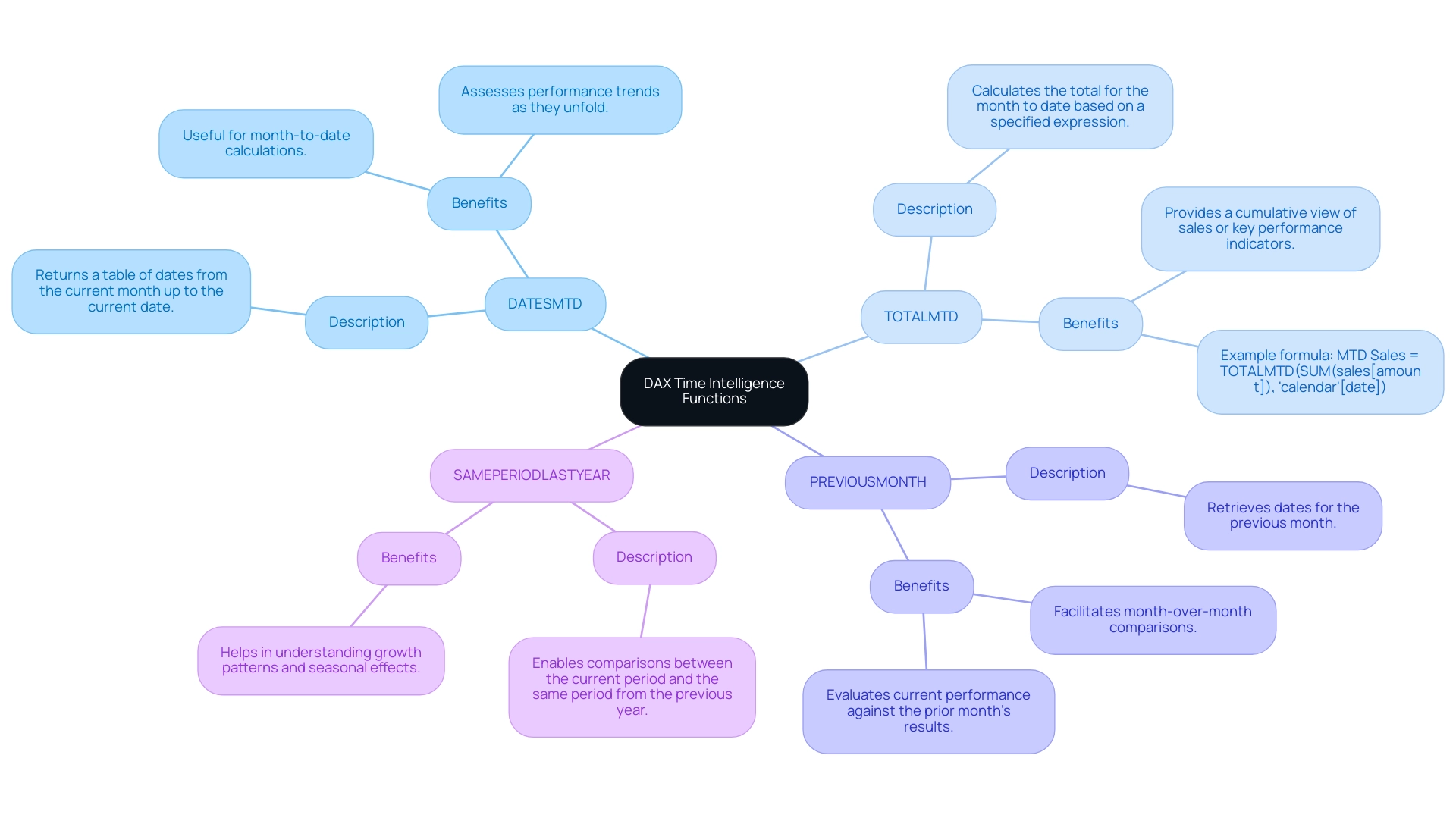
Challenges and Considerations When Using DATESMTD
While the DATESMTD function is undoubtedly a powerful tool, users frequently encounter several challenges that can hinder its effectiveness:
-
Context and Filters: One of the primary hurdles is the function’s dependence on the context in which it is applied. It is vital to ensure that filters are accurately set to avoid unexpected results, as incorrect contexts can lead to significant discrepancies in your analysis. According to recent statistics, approximately 30% of DAX implementations face issues related to context and filter settings, highlighting the importance of datesmtd dax in this consideration. Leveraging Robotic Process Automation (RPA) can help streamline the setup of these filters by automating repetitive tasks, thereby enhancing operational efficiency and reducing the risk of human error.
-
Information Model Considerations: Problems often arise when the underlying information model is inadequately structured. For optimal performance, ensure that date columns are properly formatted and that relationships between tables are correctly established, which is foundational for accurate calculations in datesmtd dax. A case study titled “Using IF and HASONEVALUE Functions” illustrates how structuring models can help users effectively calculate cumulative sales based on selected months, demonstrating the importance of a well-organized model. Tailored AI solutions can assist in analyzing your model’s effectiveness, providing insights on how to optimize it further for DAX calculations.
-
Performance Issues: In scenarios involving large datasets, the DATESMTD DAX function can lead to performance lags. To counter this, it’s advisable to optimize your queries related to datesmtd dax and consider aggregating information when feasible to enhance processing speed. Performance optimization is crucial, especially in enterprises where data volume can significantly impact analysis time. Utilizing Business Intelligence tools can aid in quickly identifying bottlenecks in performance, allowing for timely adjustments that enhance analysis efficiency.
-
Understanding Time Intelligence: A robust understanding of time intelligence concepts is essential. For those new to DAX, investing time to understand how time operations interact will pay off, especially when tackling more complex formulas. As Pieter aptly noted, “Understanding the nuances of DAX expressions is key to unlocking their full potential.” By embracing these insights and overcoming implementation challenges, users can maximize the impact of the tool in their analyses. Additionally, automating the learning process through RPA can help teams stay updated on best practices, further enhancing their analytical capabilities.

The Role of Context and Filters in DATESMTD Calculations
In DAX, the role of context is crucial for the precision and efficiency of calculations, particularly when employing a specific time-related function. Understanding the following components is essential:
- Row Context: This refers to the specific row being evaluated in your data model. It affects how the date retrieval mechanism acquires its date table, making it essential to understand how row context interacts with your datasets.
- Filter Context: The filters applied to your data model significantly affect the results generated by the date month-to-date function. Effectively managing these filters is vital for ensuring precise outcomes. For instance, when utilizing the VALUES feature within CALCULATE, you can preserve the current filter context while incorporating additional conditions, such as excluding specific regions from total sales calculations.
- Changing Context: Functions like CALCULATE empower users to modify the filter context, facilitating more intricate calculations. By using CALCULATE in conjunction with month-to-date functions, you can create dynamic measures that adjust according to user selections within reports.
It is important to note that valid dates in DAX, specifically for functions like datesmtd dax, are all dates after March 1, 1900, which is a crucial detail for understanding date-related functions. Mastering the nuances of row and filter context allows users to construct robust DAX formulas that enhance analysis capabilities. For instance, the case study titled “Designing Efficient Formulas with Proper Context Understanding” demonstrates how mastering these contexts can lead to enhanced analysis and reporting outcomes.
As Andy Brown from Wise Owl Training emphasizes, this understanding is foundational for creating efficient DAX formulas that can lead to improved reporting outcomes. By leveraging context and filters, you can unlock richer insights from your data.
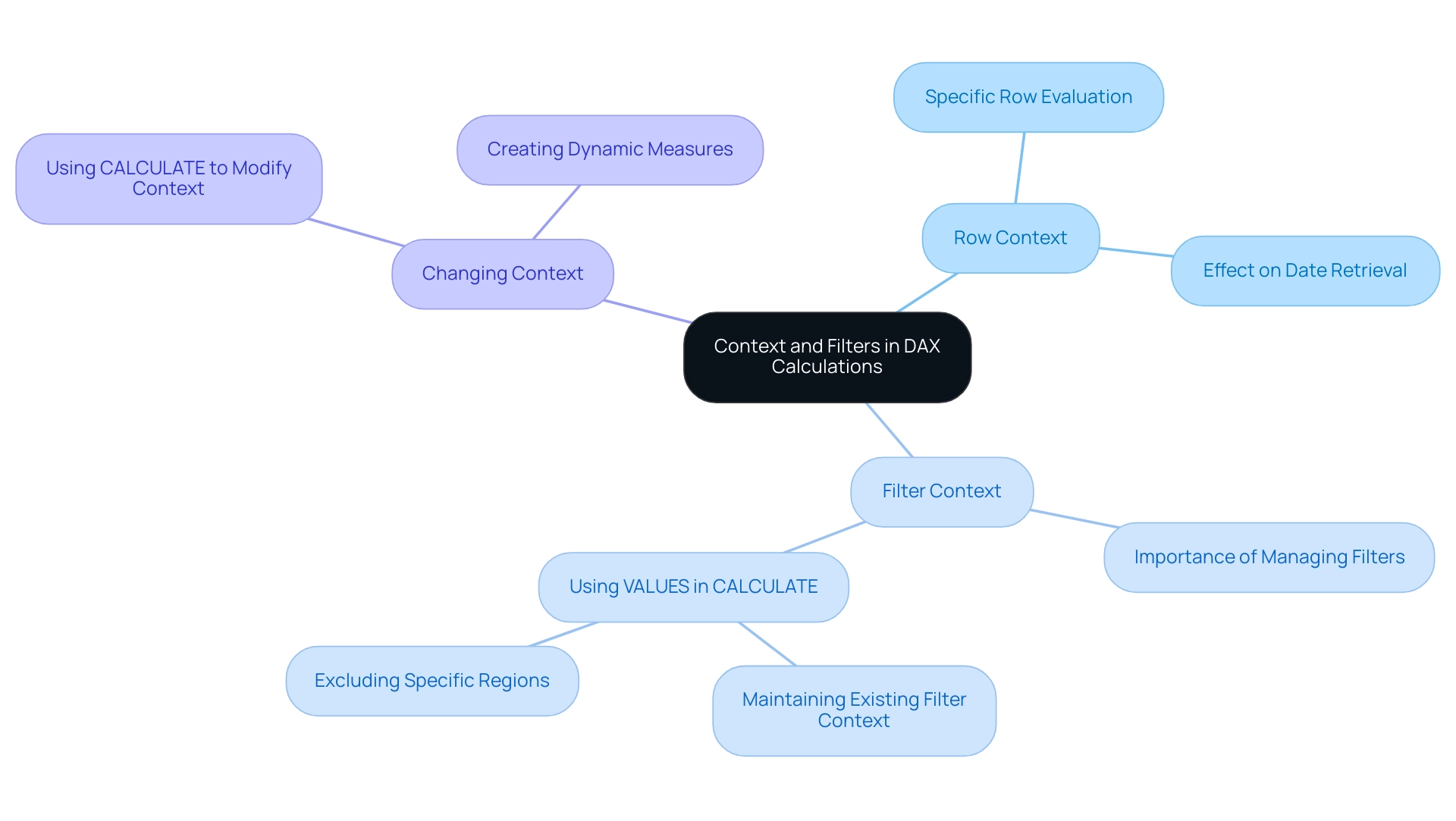
Conclusion
Harnessing the power of the DATESMTD function in DAX is a game-changer for organizations seeking to enhance their financial analysis and operational efficiency. This function not only simplifies month-to-date calculations but also enables Directors of Operations Efficiency to derive actionable insights that drive informed decision-making. By understanding how to effectively apply DATESMTD alongside other time intelligence functions, professionals can refine their analytical capabilities and better respond to evolving business needs.
Practical applications of DATESMTD, such as calculating total sales or product-specific performance, demonstrate its versatility and significance in real-time analysis. Coupled with an awareness of context and filters, users can navigate common challenges, ensuring accurate and efficient calculations. The comparison with other DAX functions like TOTALMTD further emphasizes the necessity of selecting the right tools for specific analytical objectives, thereby optimizing performance tracking.
In a data-driven world where timely insights are paramount, mastering DAX functions like DATESMTD not only enhances analytical prowess but also positions organizations to remain agile and competitive. As businesses continue to leverage these powerful tools, the potential for unlocking deeper insights and driving operational success expands significantly. Embracing these strategies is essential for any organization committed to achieving excellence in data analysis and operational efficiency.
Introduction
In the realm of data analysis, harnessing the full power of DAX (Data Analysis Expressions) can transform how organizations interpret and utilize their data. Among the myriad of functions available, COUNTROWS and DISTINCTCOUNT stand out as essential tools for any data analyst aiming to derive meaningful insights from complex datasets. Understanding these functions is not just about counting; it’s about unlocking the potential for strategic decision-making and operational efficiency. As businesses increasingly integrate DAX with Robotic Process Automation (RPA), the ability to automate data tasks and streamline workflows becomes crucial. This article delves into the intricacies of COUNTROWS and DISTINCTCOUNT, offering practical examples and strategies that empower analysts to enhance their data capabilities and drive growth in their organizations.
Understanding DAX Functions: COUNTROWS and DISTINCTCOUNT
DAX (Data Analysis Expressions) serves as a powerful formula language integral to Power BI, Excel, and other Microsoft applications, playing a crucial role in Business Intelligence and driving operational efficiency. Among its primary roles, COUNTROWS and the dax distinctcount with filter function are vital instruments for any analyst aiming to unlock the potential of their datasets.
- COUNTROWS counts the total number of rows within a table or table expression, making it invaluable for assessing the volume of entries present in a dataset.
This method is especially beneficial for rapidly assessing the volume of your information pool, directing later analysis and facilitating more efficient reporting. For example, in a recent case study, the SUM operation aggregates values in a column while SUMX assesses an expression for each row before summing results, illustrating how COUNTROWS complements these calculations by providing a clear count of total entries.
- Conversely, the function known as dax distinctcount with filter emphasizes counting unique values within a specified column, which is essential for comprehending variety, such as recognizing unique customer segments or product types. As emphasized by recent statistics, the utilization of DAX capabilities has surged in 2024, reflecting their increasing significance in successful information analysis practices.
Understanding these capabilities is essential for utilizing DAX effectively, especially when applying dax distinctcount with filter to extract specific insights. By integrating DAX with RPA solutions, organizations can automate repetitive data tasks, thus reducing the time-consuming nature of report creation and minimizing data inconsistencies. Mastering tools such as COUNTROWS and unique counts will empower you to make informed decisions, enhance your analytical capabilities, and ultimately drive growth and innovation in your organization.
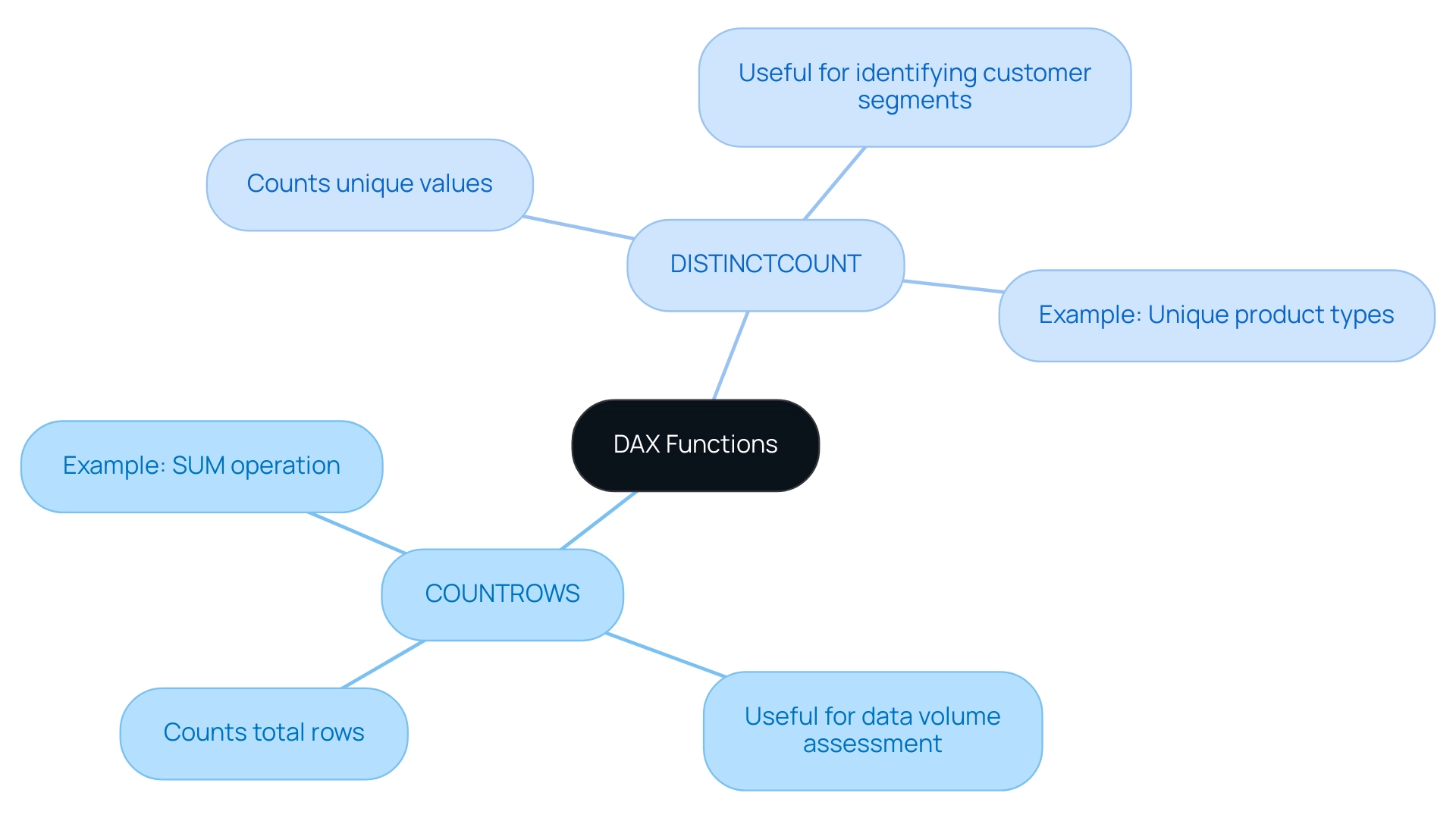
Syntax Breakdown of DISTINCTCOUNT in DAX
The DAX DISTINCTCOUNT with filter formula is a powerful tool for counting unique values within a specified column, which is essential for enhancing Business Intelligence capabilities and driving operational efficiency through RPA. The syntax for this function is straightforward:
DISTINCTCOUNT(columnName)
- columnName: This refers to the specific column from which distinct values will be counted. It is essential that this column is incorporated into a well-organized information model, ensuring precise calculations.
For instance, consider a table labeled ‘Sales’ where you aim to determine the number of distinct customers. Your DAX formula would be:
DISTINCTCOUNT(Sales[CustomerID])
Understanding this syntax is crucial as it lays the groundwork for implementing filters and developing more complex DAX expressions. Mastery of COUNT UNIQUE not only enhances your analytical capabilities but also streamlines information processes, reducing repetitive tasks and addressing outdated systems, positioning you as a key player in your organization, refining strategies based on diverse consumer interactions.
As pointed out by expert Glenn Seibert, with 209 shops in North America, the capability to precisely tally unique values can greatly affect business choices across different locations. Furthermore, utilizing dax distinctcount with filter assists in overcoming typical obstacles encountered when deriving insights from Power BI dashboards, such as inconsistencies in information and the lengthy process of report generation. Engaging in courses such as the ‘Power BI Advanced Topics Course’ can provide professionals with the skills needed to use techniques effectively, resulting in valuable outcomes and enhanced operational efficiency.
It is also crucial to be aware that some DAX operations can be volatile, returning different results with the same arguments, highlighting the importance of understanding DAX nuances in practical applications.
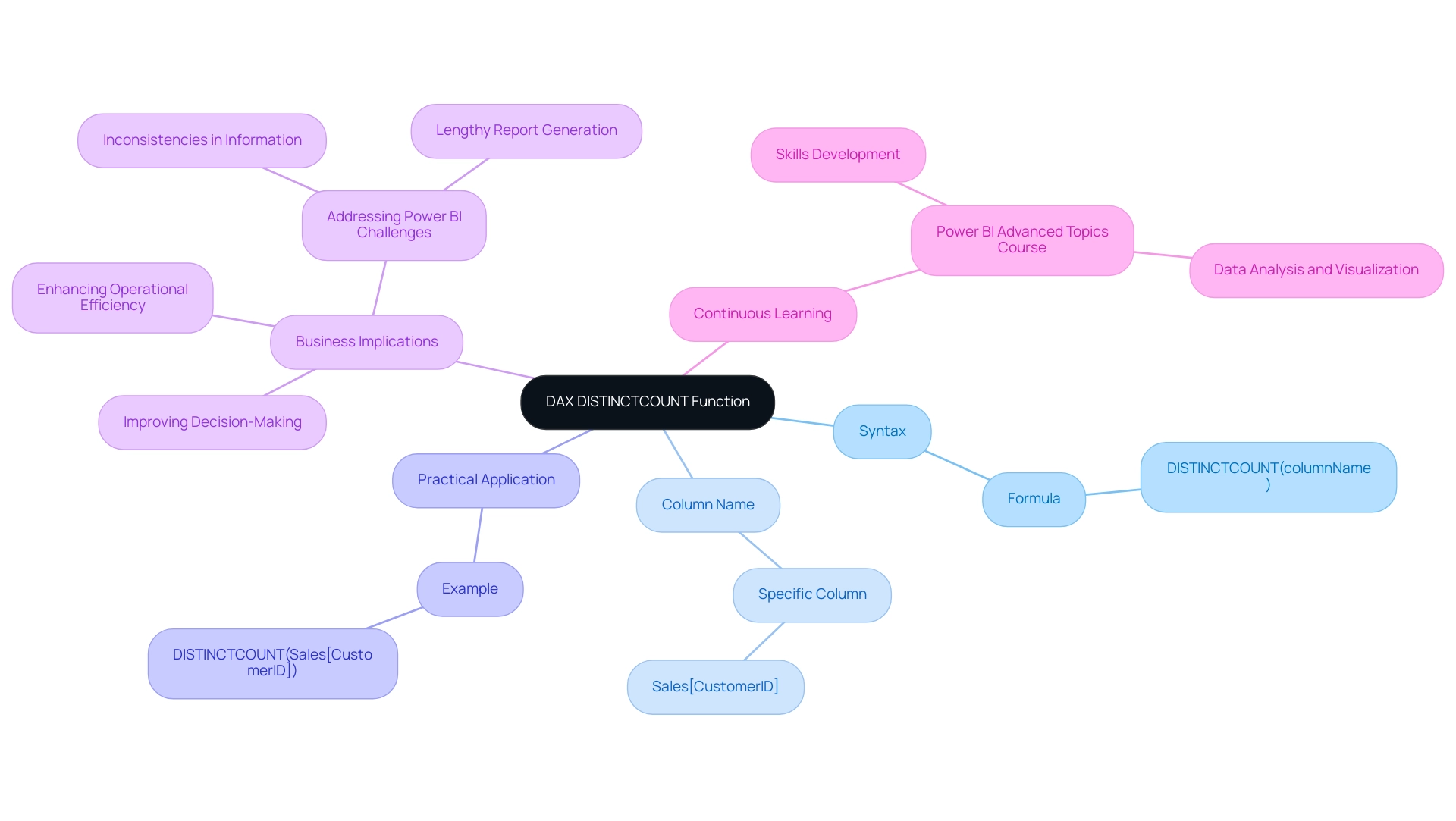
Practical Examples of DISTINCTCOUNT Usage
Applying the DAX distinctcount with filter feature can greatly enhance your analysis capabilities, especially as the market for information quality tools is expanding at 16% each year. This process is an essential component in overcoming technology implementation challenges, particularly in enhancing operational efficiency through accurate data management. Furthermore, when combined with Robotic Process Automation (RPA), the use of DAX functions can streamline workflows, reduce manual tasks, and free up your team for more strategic, value-adding work.
Here are several practical examples to illustrate its effectiveness:
-
Counting Unique Products Sold: To determine the number of unique products sold during a specific period, utilize the following DAX formula:
DAX
DISTINCTCOUNT(Sales[ProductID])
This calculation is crucial as the retail market for unique product sales is projected to grow significantly, emphasizing the importance of accurate inventory analysis in 2024. Furthermore, utilizing unique count helps avoid duplicate entries in your summary index, ensuring the integrity of your data and freeing up resources for more strategic efforts. -
Finding Unique Customers: To assess how many distinct customers made purchases, the following formula is effective:
DAX
DISTINCTCOUNT(Sales[CustomerID])
Understanding your customer base is vital for retention strategies, as highlighted by Databel’s upcoming analysis of customer usage patterns and competitor comparisons. This method also aids in preventing duplicate entries, which can skew your understanding of customer dynamics, thus enhancing your overall operational efficiency. Integrating tailored AI solutions can further refine this analysis, providing deeper insights into customer behaviors. -
Evaluating Unique Transactions: To count the number of distinct transactions, you can apply:
DAX
DISTINCTCOUNT(Sales[TransactionID])
This metric is essential for evaluating sales performance and identifying trends over time. As noted by industry expert Anna Dunay, effective information management strategies, including the reuse of components and avoiding duplicates, can lead to improved product quality without compromising overall outcomes. By utilizing RPA together with DAX functions, companies can streamline the information gathering process, ensuring that these metrics remain consistently current and precise.
These illustrations clearly showcase the usefulness of COUNT across different contexts, providing you with practical tools to enhance the effectiveness and precision of your datasets. Leveraging such Business Intelligence tools, along with RPA and AI solutions, can transform raw data into actionable insights, enabling informed decision-making that drives growth and innovation.
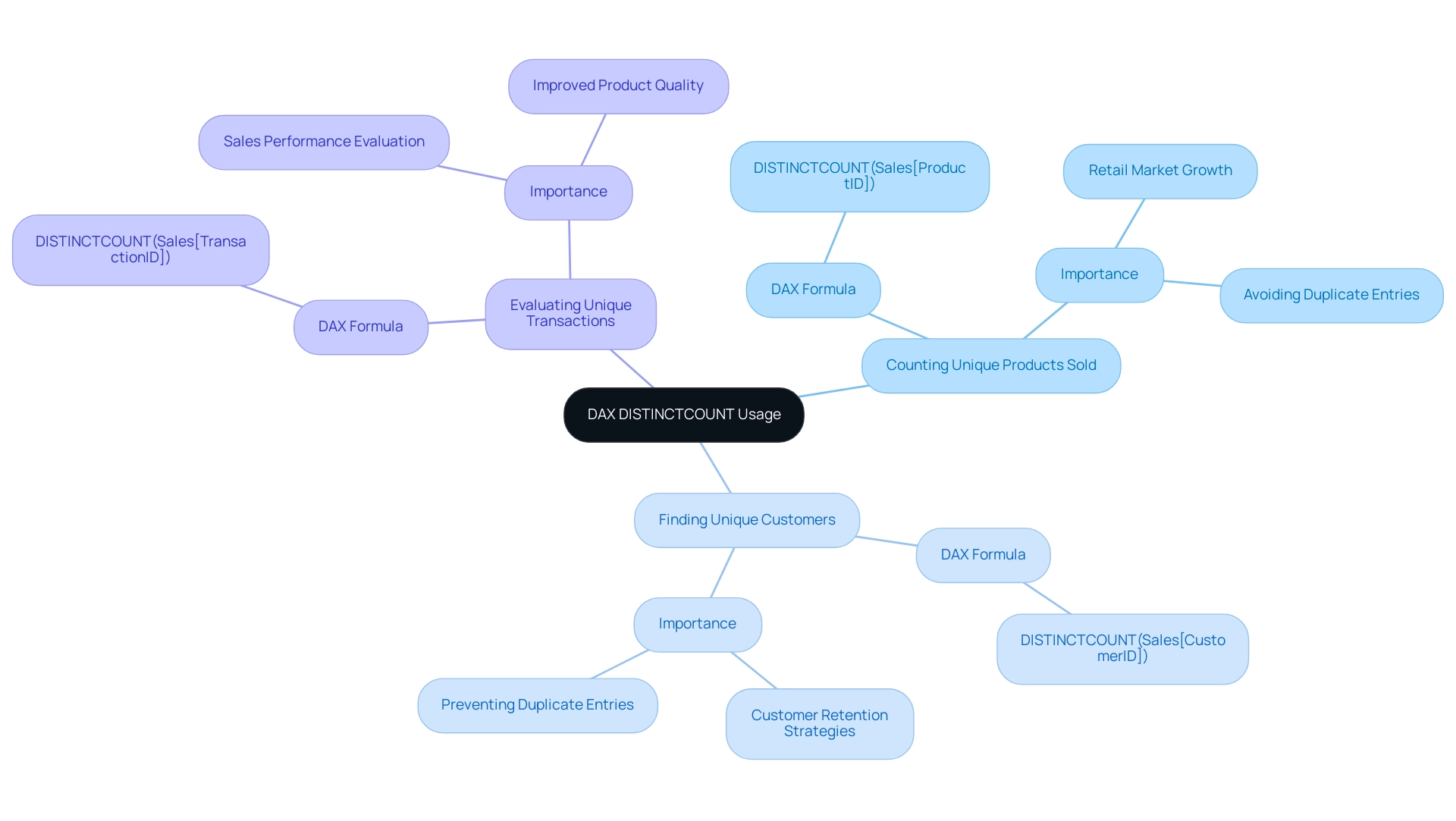
Applying Filters with DISTINCTCOUNT: A Step-by-Step Approach
To effectively apply filters with DISTINCTCOUNT in DAX while leveraging Robotic Process Automation (RPA) to enhance operational efficiency, follow these actionable steps:
- Define Your Filter: Begin by establishing the criteria for your filter. For instance, if your goal is to count unique customers who made purchases in a specific year, your filter criteria will focus on that specific year. You can utilize the
ENDOFYEAR(<dates>)method to dynamically reference the end of the year, ensuring your analysis remains relevant.
To analyze the data effectively, we can use DAX DISTINCTCOUNT with FILTER. Write the DAX expression that utilizes DAX DISTINCTCOUNT with FILTER to combine the unique count function with the FILTER function. Here’s a practical example:
DISTINCTCOUNT(FILTER(Sales, Sales[Year] = <specific_year>), Sales[CustomerID])
-
Automate Tasks: Consider automating manual activities related to your DAX processes, such as entry, report generation, or cleaning, using RPA. This can significantly reduce errors and save time, allowing your team to focus on strategic insights.
-
Test Your Formula: Once your DAX expression is written, test it within your model to verify that it yields the expected results. Make adjustments to your filter criteria as needed to refine your analysis. By automating this process with RPA, you can further enhance accuracy and efficiency.
-
Analyze Results: Leverage the output to extract meaningful insights from your information. For example, understanding customer behavior in a specific year can significantly enhance your marketing strategies. RPA can assist by automating the collection and reporting processes, facilitating quicker access to actionable insights.
This systematic method not only enables you to incorporate filters with UNIQUECOUNT effectively but also improves your overall analysis capabilities. As Joleen Bothma states, “Discover how to make your Power BI reports more insightful, informative, and interactive with this advanced analytical features tutorial.” For further insights, consider exploring her advanced tutorial on analytical features in Power BI, which can elevate your reporting to new levels of interactivity and insight.
Additionally, the case study titled ‘Advanced Analytical Features in Power BI Tutorial’ illustrates how users have successfully enhanced their reports with advanced features, increasing interactivity and insight.
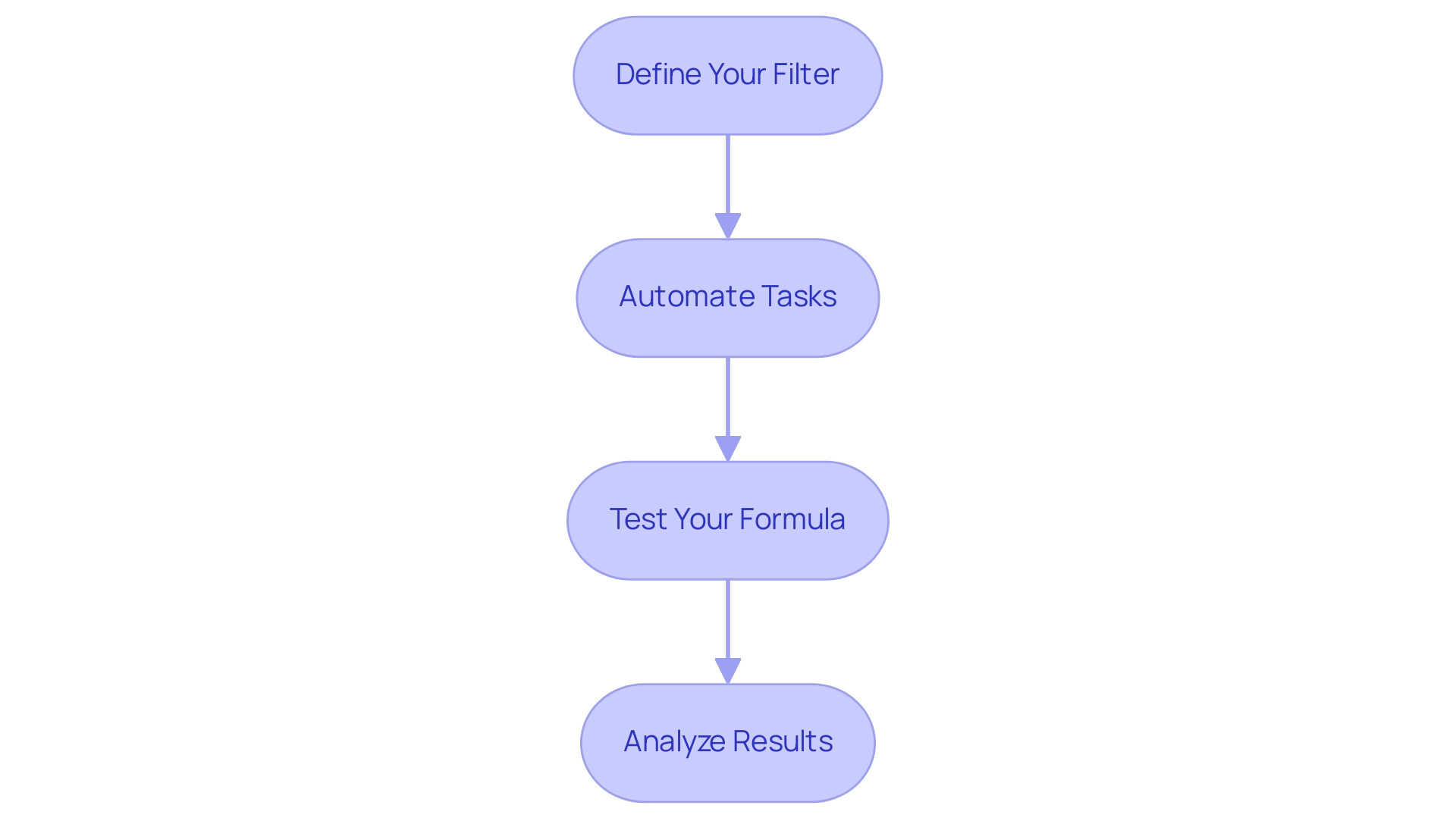
Performance Considerations for DISTINCTCOUNT in DAX
To enhance the performance of your DAX calculations when utilizing DISTINCTCOUNT, consider the following key strategies that align with Robotic Process Automation (RPA) principles, which can automate and streamline these processes:
-
Avoid Complex Filters: Implementing intricate filtering can significantly impede performance. Strive to simplify your filters wherever feasible to boost speed, mirroring the efficiency RPA brings to workflow automation. By automating the filtering process, RPA can ensure that only essential information is processed, enhancing overall performance.
-
Optimize Information Models: A well-structured information model is crucial. Proper optimization can lead to substantial improvements in DAX calculation performance, facilitating smoother operations. For instance, DAX Studio offers functionality to export and import VertiPaq model metadata using .vpax files, aiding in model optimization discussions and collaborations. RPA can automate the modeling process, ensuring consistent updates and optimizations without manual intervention.
-
Limit Size: When handling extensive datasets, employing dax distinctcount with filter to aggregate information can help minimize the number of rows processed, thereby enhancing efficiency—an approach that complements RPA’s capability to streamline workflows. RPA can automate the aggregation process, ensuring that only relevant data is analyzed, thus improving calculation speed.
-
Monitor Performance: Leverage tools like DAX Studio, which captures and formats Analysis Services traces, providing a user-friendly alternative to SQL Server Profiler. This tool enables you to analyze the performance of your DAX queries effectively and identify any bottlenecks. As Miguel Felix, a Super User, noted, “Can you share a sample file? I made a test file and it worked properly.” This highlights the importance of practical testing in optimizing performance, akin to testing RPA implementations for maximum effectiveness.
By implementing these performance optimization strategies in conjunction with RPA, users can not only unlock the full potential of their DAX calculations but also free up valuable team resources for more strategic, value-adding work. This dual approach leads to faster insights and more informed operational decision-making, helping navigate the complexities of the evolving AI landscape.
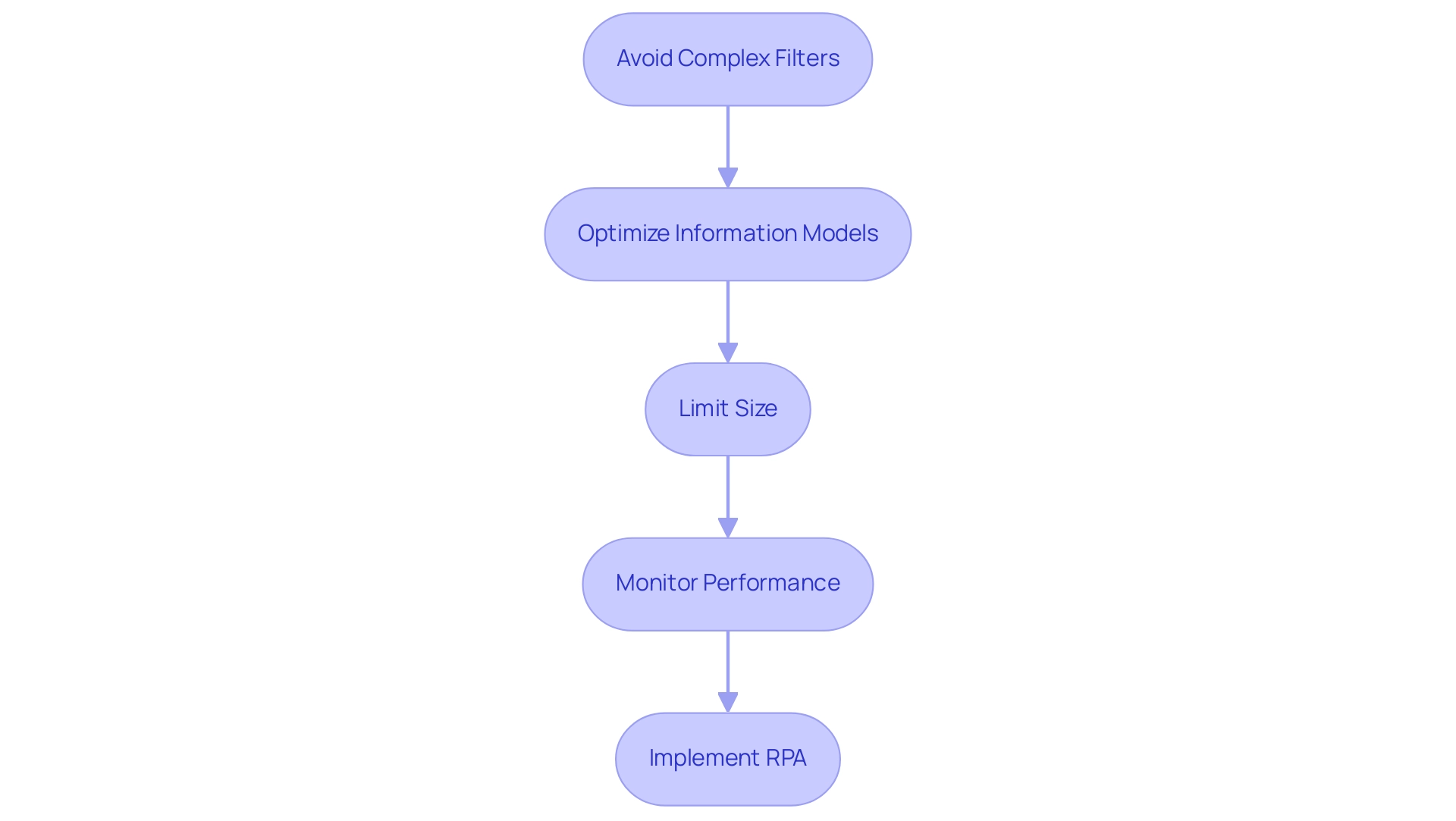
Conclusion
Harnessing the power of DAX functions like COUNTROWS and DISTINCTCOUNT is essential for any data analyst seeking to enhance operational efficiency and drive informed decision-making within their organization. These functions serve as critical tools in understanding dataset composition, whether through counting total entries or identifying unique values. By mastering these techniques, analysts can streamline their reporting processes and ensure data integrity, ultimately leading to more strategic insights.
The practical applications of DISTINCTCOUNT in various scenarios, such as assessing unique products sold or distinct customer interactions, illustrate its importance in contemporary data analysis. Coupled with Robotic Process Automation (RPA), these DAX functions can significantly reduce manual workloads and enhance data accuracy, allowing teams to focus on higher-value tasks. The integration of automation not only expedites data tasks but also ensures that insights remain timely and relevant.
As organizations continue to embrace data-driven strategies, the ability to effectively utilize DAX functions will be paramount. By implementing the discussed strategies and performance considerations, analysts can optimize their workflows and leverage insights that drive growth and innovation. The journey toward operational excellence begins with a solid understanding of these powerful tools, paving the way for data analysts to become key contributors to their organizations’ success.
Introduction
In the dynamic world of data analysis, the DAX FIRSTVALUE function emerges as a pivotal tool for professionals seeking to extract meaningful insights from complex datasets. By enabling users to pinpoint the first occurrence of a value within a specified context, FIRSTVALUE empowers analysts to uncover trends and make informed decisions that drive operational efficiency.
As organizations navigate the challenges of data management, mastering this function becomes essential for enhancing reporting capabilities and fostering a culture of data-driven decision-making. With the integration of advanced technologies like Robotic Process Automation (RPA), the potential for streamlining workflows and improving accuracy is greater than ever.
This article delves into the intricacies of the FIRSTVALUE function, exploring its syntax, practical applications, and best practices to ensure users can harness its full potential in their analytical endeavors.
Introduction to the DAX FIRSTVALUE Function
The DAX initial value capability stands out as a crucial tool in analysis, enabling users to obtain the first value in a column based on a specified filter context. This capability is invaluable for analysts aiming to track trends over time or extract initial values from complex datasets, ultimately driving data-driven insights that enhance operational efficiency. By effectively utilizing this tool, analysts can enhance their reports and dashboards, thus fostering a foundation for more informed decision-making processes.
As Suhaib Arshad, a Sales Executive turned Data Scientist, emphasizes,
With over 3 years of experience addressing challenges in Ecommerce, Finance, and Recruitment Domains, the capacity to utilize such DAX capabilities can greatly enhance one’s modeling skills in Power BI or Excel. Moreover, the incorporation of Analysis Services improves Power BI’s capabilities, offering advanced modeling features, compression, and query optimization, which additionally supports the effective utilization of DAX tools. Grasping and employing the initial value not only improves analytical skills but also provides users with crucial tools required to maneuver through the swiftly changing environment of analysis.
Significantly, valid dates in DAX are all dates following March 1, 1900, highlighting the necessity of utilizing precise date operations in information models. As we transition into 2024, mastering DAX expressions such as dax first value is essential, as they signify the foundation of efficient modeling and insightful analysis. Furthermore, utilizing Robotic Process Automation (RPA), like EMMA RPA and Power Automate, can enhance manual workflows and address issues such as time-consuming report generation and inconsistencies, ultimately promoting operational efficiency and enabling teams to concentrate on strategic initiatives.
The case study on comprehending information models and Analysis Services demonstrates how these connections facilitate cross-table analysis and deeper insights, emphasizing the practical applications and results of using DAX operations in real-world situations. Furthermore, tackling the difficulty of deriving valuable insights from data is essential, and mastering DAX capabilities is a crucial step in overcoming this challenge.

Understanding the Syntax of FIRSTVALUE
The syntax for retrieving the DAX first value of an item is organized as follows: FIRSTVALUE(<column>, [<filter>]). In this context, <column> signifies the particular column from which the first value is to be retrieved, while the optional [<filter>] enables you to specify any necessary conditions that must be met for the operation to return a result. For instance, to obtain the earliest order date from a sales table, you can use the formula: MIN(Sales[OrderDate]).
Mastering this syntax is essential for effectively utilizing the DAX first value method in your analysis, particularly in a data-rich environment where actionable insights drive growth and innovation.
Common errors often arise from misapplying the filter, leading to unexpected results. By understanding these nuances, you can avoid pitfalls and enhance your data modeling skills, ultimately improving operational efficiency through effective use of BI tools.
Additionally, it’s crucial to note that the START AT syntax follows the ORDER BY clause in the EVALUATE statement, which plays a vital role in defining the order of query results. For users working with DAX formulas, being aware of SSDT compatibility, which ranges from v14.0.1.432 to v16.0.70.21, adds credibility to your implementations.
To illustrate practical applications, consider the SUBSTITUTE tool, which replaces specified text in a string with new text. For instance, SUBSTITUTE([Product], 'Hairgel', 'Hairmask') substitutes ‘Hairgel’ with ‘Hairmask’ in the Product string, illustrating how DAX operations can be utilized effectively in real-world scenarios. As highlighted by expert Choy Chan Mun, ‘Excited to enhance your Power BI skills with this comprehensive guide!
‘💡’ This feature serves as a powerful tool in your DAX arsenal, enabling clearer insights and more precise interpretations while addressing the challenges of report creation and inconsistencies.
Moreover, to enhance operational efficiency, consider integrating RPA solutions like EMMA RPA and Power Automate to automate repetitive tasks, thereby freeing up resources for more strategic initiatives. Explore how these tools can transform your processes and drive growth in your organization. Book a free consultation today!
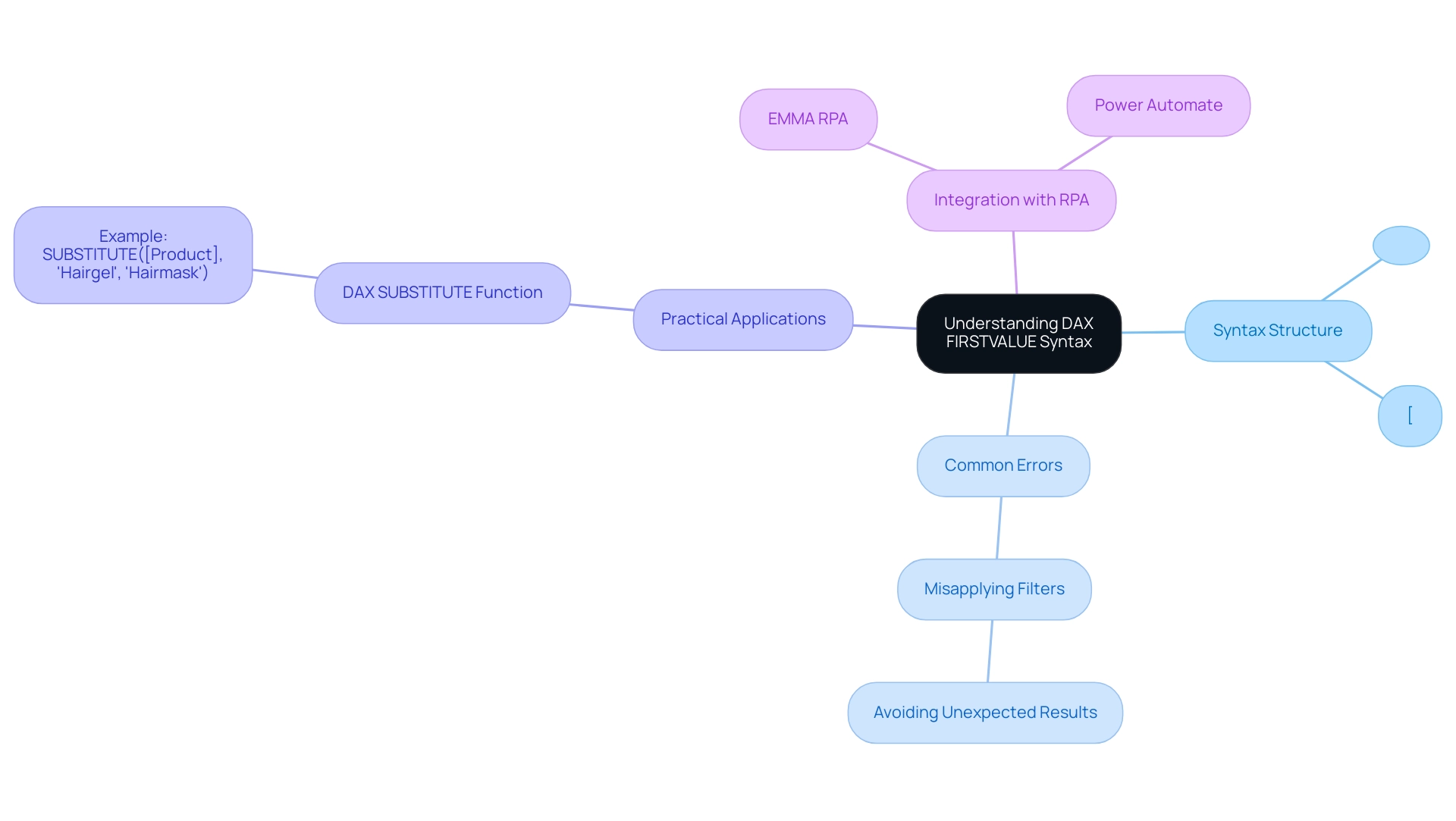
Practical Applications of the FIRSTVALUE Function
The DAX function serves as a powerful tool in various analytical contexts, enabling users to extract critical insights from their data. For instance, in customer analysis reports, the system can identify the dax first value of each customer’s purchase date, which is instrumental in refining targeted marketing strategies. By understanding the dax first value of when a customer first engaged with the brand, organizations can tailor their outreach efforts to enhance customer retention and loyalty.
Furthermore, this method can be applied to evaluate performance metrics over time, establishing a baseline for future comparisons and enabling clear assessments of growth or decline. This capability is further enhanced when integrated with Robotic Process Automation (RPA), which can automate the collection and processing of information, ensuring that the insights derived are timely and relevant. RPA not only reduces errors but also frees up team members to focus on more strategic, value-adding tasks, thereby enhancing overall operational efficiency.
Alongside the dax first value, the CONCATENATEX method can be employed to merge values from different columns or tables, producing detailed reports that incorporate textual insights with numerical information. This blend of capabilities simplifies information analysis and enables decision-makers to utilize past insights for strategic planning. By automating the workflow with RPA, Directors of Operations Efficiency can significantly reduce the time spent on repetitive processing tasks, allowing them to focus on interpreting insights that drive business growth.
As emphasized by Prasanth Pandey, “In Power BI, implicit measures are automatically created for basic aggregations when fields are included in visuals,” signifying the significance of effectively utilizing DAX expressions to improve analytical capabilities. Furthermore, for extensive datasets, the refined median metric can execute in under half a second, demonstrating the effectiveness of DAX operations in managing significant information. This efficiency is crucial for Directors of Operations Efficiency who rely on timely insights for informed decision-making, further bolstered by the integration of RPA into their analytical processes.
The rapidly evolving AI landscape necessitates the adoption of technologies like RPA to overcome the challenges posed by manual, repetitive tasks, ensuring organizations remain competitive and agile.
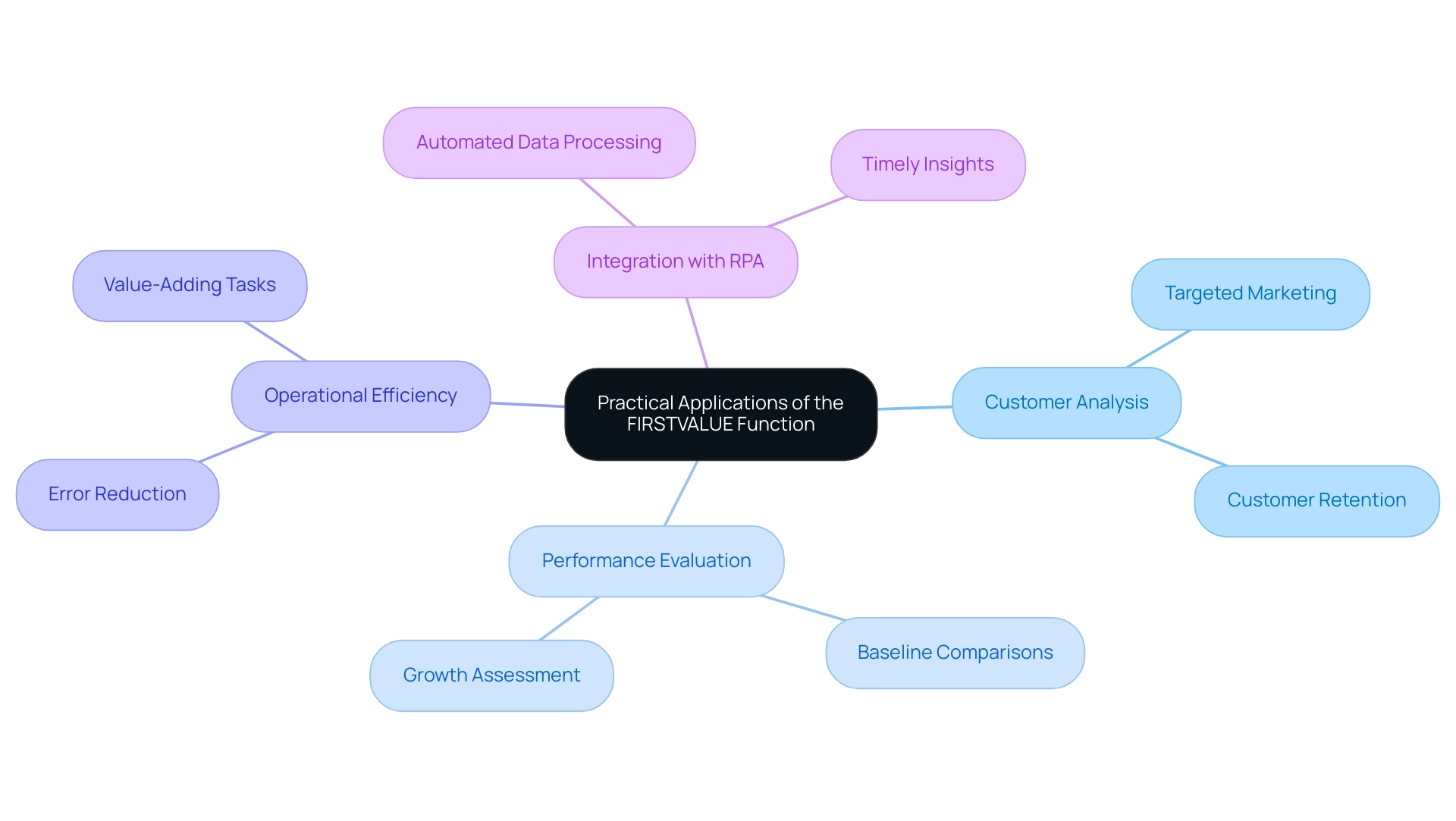
Best Practices and Common Pitfalls in Using FIRSTVALUE
Utilizing the initial value function effectively requires careful consideration of the column’s order, as ensuring the specified column is sorted correctly is crucial to obtaining reliable results. Failing to do so can lead to insights that diverge from expectations, a common challenge in leveraging Power BI dashboards due to time-consuming report creation and data inconsistencies. Moreover, it’s essential to avoid using this function in scenarios where multiple values may be returned without an explicit filter, which can introduce ambiguity into your analysis.
A best practice is to consistently pair the appropriate filtering with the DAX first value to enhance accuracy in your results. For instance, using it together with the CALCULATE method provides a clearer context: CALCULATE(InitialValue(Sales[OrderDate]), Sales[Region] = 'North'). This formula guarantees that you extract the first order date specifically for the North region, thus providing clarity and precision in your data analysis.
In practical scenarios, such as in Time-Series Analysis, the DAX first value capability can be crucial in recognizing trends and patterns over time. As Henry Chukwunwike Morgan-Dibie states, ‘Simplifying complex topics to empower understanding and decision-making,’ this principle applies to the use of DAX operations. By integrating Business Intelligence best practices and automating manual workflows with RPA solutions like EMMA RPA and Power Automate, organizations can streamline operations and make informed decisions that drive growth and innovation.
Moreover, calculated columns in Power BI enable users to generate new information through user-defined expressions, further demonstrating how this concept integrates within the wider context of DAX capabilities and their uses. The visual representation of automation, depicted in the stylized illustration of a human figure with robotic counterparts, underscores the transformative role of technology in enhancing operational efficiency.
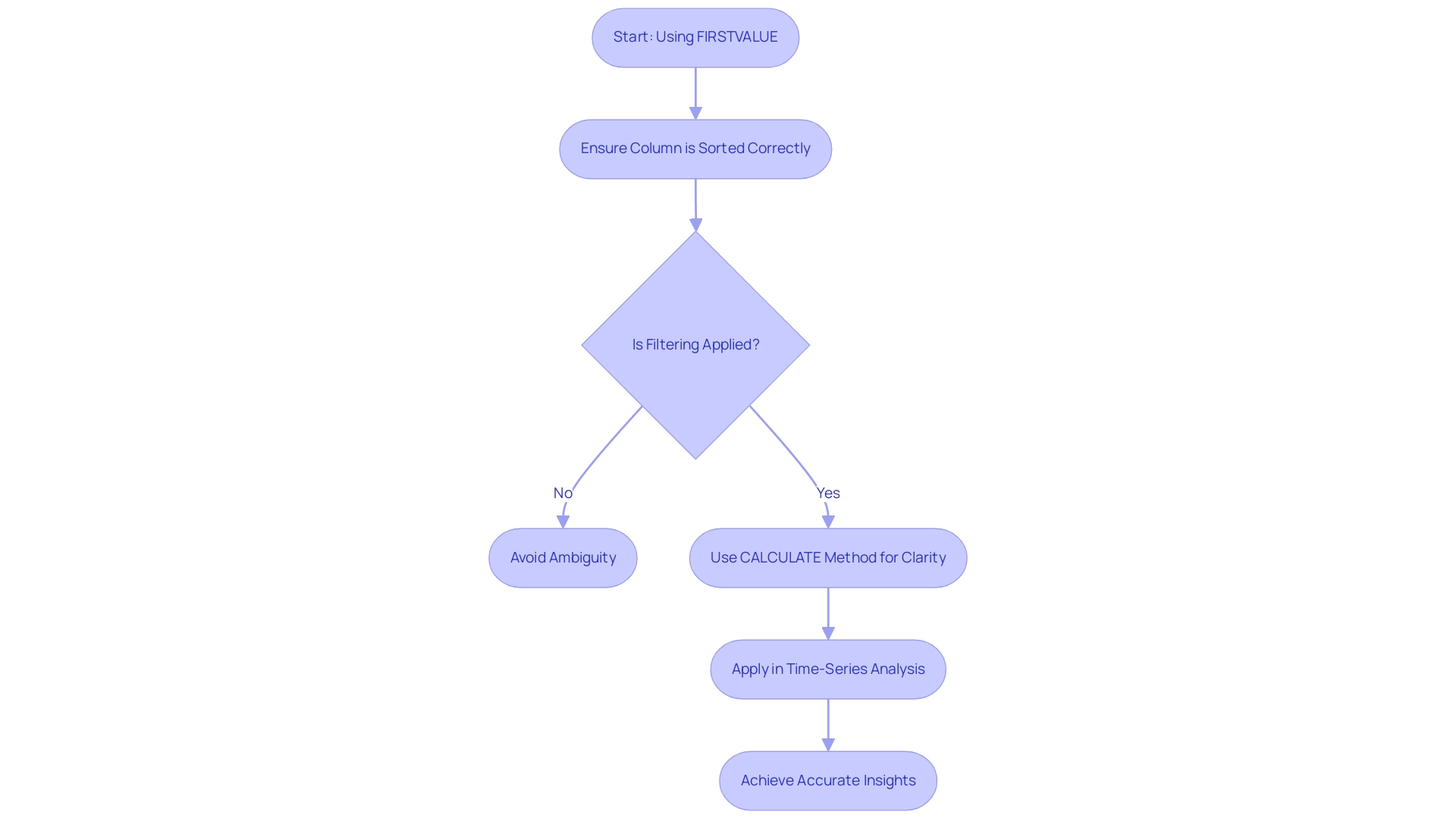
Examples and Case Studies of FIRSTVALUE in Action
In the realm of retail analysis, the dax first value tool can profoundly influence the understanding of customer purchasing behavior. For example, examine a case study named ‘Impact of Restocking Fees and EU Legislation,’ which explores how a leading retail firm employed the function to assess their sales information. By pinpointing the first purchase date for each customer, the retailer was able to effectively segment their clientele based on distinct buying patterns.
This segmentation not only improved targeted marketing efforts but also optimized inventory management strategies by aligning stock levels with customer preferences.
Moreover, the integration of Robotic Process Automation (RPA) within this analytical framework can further streamline operations by automating tasks such as entry, report generation, and collection processes. This automation frees up valuable resources for more strategic initiatives, enhancing operational efficiency in a rapidly evolving AI landscape. RPA solutions are designed to adapt to new technologies, allowing businesses to remain agile and responsive to changes in the market.
In addition, this case study highlights how customer perceptions play a critical role in implementing restocking fees, especially in light of new EU legislation regarding free returns.
As Rita Maria DiFrancesco from Politecnico di Milano states, ‘Retailers charging a restocking fee should put more effort into increasing consumer perceived value, as customers will accept a restocking fee if they view the online purchase as having higher quality than a brick-and-mortar purchase.’ This insight highlights the necessity for retailers to enhance perceived value to successfully implement such fees, aligning with the findings from the case study.
Similarly, in the financial sector, analysts can utilize the power of dax first value to track the initial investment dates of their clients. This capability enables financial advisors to offer tailored advice that reflects each client’s unique investment journey, ultimately fostering stronger relationships and driving client satisfaction. Furthermore, utilizing RPA to automate regular analytical tasks, such as transaction processing and data reconciliation, can improve the precision and quickness of insights obtained from such data.
Practical applications of this concept illustrate how data can be converted into actionable strategies, leading to enhanced operational efficiency and profitability. Furthermore, using the stats command in a multivalue BY field can deduplicate values and return the average of another field, further enhancing the analytical capabilities when working with the dax first value function.
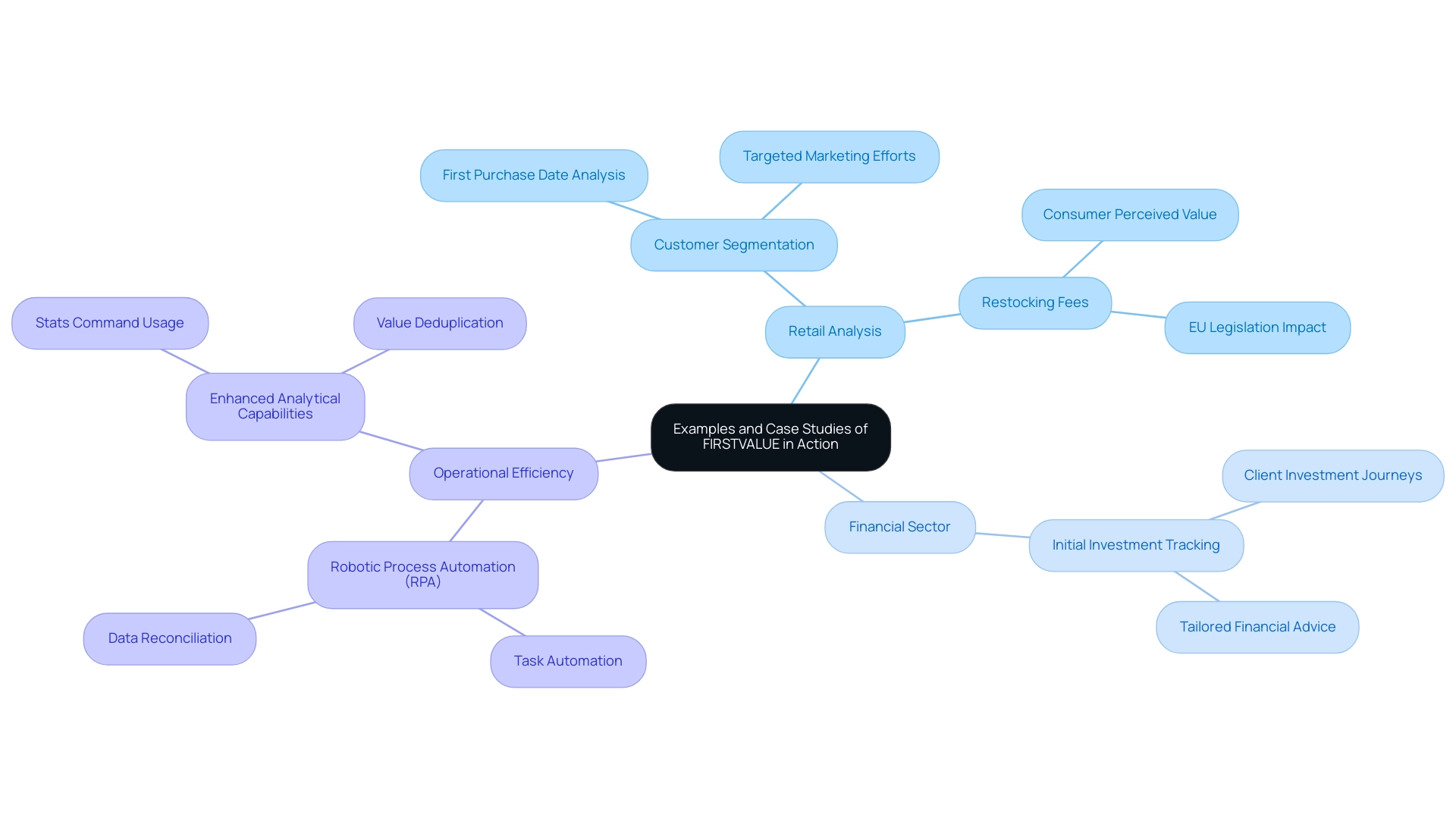
Conclusion
The DAX FIRSTVALUE function is a transformative tool that allows analysts to extract crucial insights from complex datasets, making it indispensable for any data-driven organization. By mastering the syntax and practical applications of FIRSTVALUE, users can not only track initial values but also uncover trends that inform strategic decision-making. This capability is further enhanced by the integration of Robotic Process Automation (RPA), which streamlines workflows and promotes operational efficiency.
Best practices for using FIRSTVALUE emphasize the importance of accurate filtering and sorting, ensuring that the insights derived are both reliable and actionable. By combining FIRSTVALUE with other DAX functions, such as CALCULATE, analysts can refine their results and gain deeper insights into their data. Real-world case studies illustrate the function’s effectiveness in diverse sectors, from retail to finance, demonstrating how it can drive targeted marketing and optimize resource management.
As organizations continue to navigate the complexities of data analysis, the ability to leverage tools like FIRSTVALUE will be central to achieving operational excellence. Embracing these advanced analytical techniques, alongside automation solutions, empowers teams to focus on strategic initiatives that foster growth and innovation. Mastering DAX functions is not just a technical skill but a vital step towards cultivating a culture of informed decision-making in an increasingly competitive landscape.
Introduction
In the age of information, the ability to transform raw data into actionable insights is paramount for organizations striving to thrive in a competitive landscape. Data transformation in Power BI emerges as a pivotal process, enabling businesses to clean, shape, and integrate diverse data sources with precision.
As companies grapple with challenges such as economic uncertainty and the complexities of digital transformation, understanding the nuances of data management becomes essential for operational success. By leveraging advanced tools like Power Query and M Language, along with innovative strategies such as Robotic Process Automation (RPA), organizations can streamline workflows, enhance data quality, and empower teams to focus on strategic initiatives.
This article delves into the critical techniques and best practices for effective data transformation, illuminating the path toward maximizing analytics capabilities and driving informed decision-making in an ever-evolving digital landscape.
Understanding Data Transformation in Power BI
The process of data transformation in Power BI is essential, involving the conversion of raw information into a structured format suitable for analysis and reporting. This intricate process includes:
- Cleaning
- Shaping
- Integrating information from diverse sources
Ensuring both accuracy and consistency. As organizations traverse a progressively intricate digital environment, understanding data transformation in Power BI is essential for enhancing analytics abilities.
Moreover, addressing prevalent views regarding AI, especially the difficulties of implementation, such as inadequate master information quality and organizational reluctance to adopt AI, is crucial for operational success. A recent report indicates that 22% of IT leaders view economic uncertainty as a significant challenge to implementing digital changes, underscoring the need for reliable data practices amidst fluctuating market conditions.
Effective data transformation in Power BI not only enhances data quality but also empowers businesses to make informed decisions swiftly, improving their ability to adapt to market dynamics. Incorporating Robotic Process Automation (RPA) can further streamline workflows, reduce manual errors, and free up teams for more strategic tasks, ultimately driving data-driven insights and operational efficiency. While some may view AI projects as time-consuming and expensive, companies can alleviate these concerns by adopting structured approaches and utilizing tools that simplify integration.
Companies employing advanced technologies, like those provided by WalkMe’s Digital Adoption Platform, significantly enhance the chances of successful changes. Evidence suggests that organizations adapting digital tools to meet employee needs more than double the chances of achieving desired outcomes, leading to higher employee satisfaction and profitability. Furthermore, since digital changes can generate and remove jobs, it requires the advancement of new digital abilities, demonstrating the wider effects of data transformation in Power BI on today’s evolving workforce.
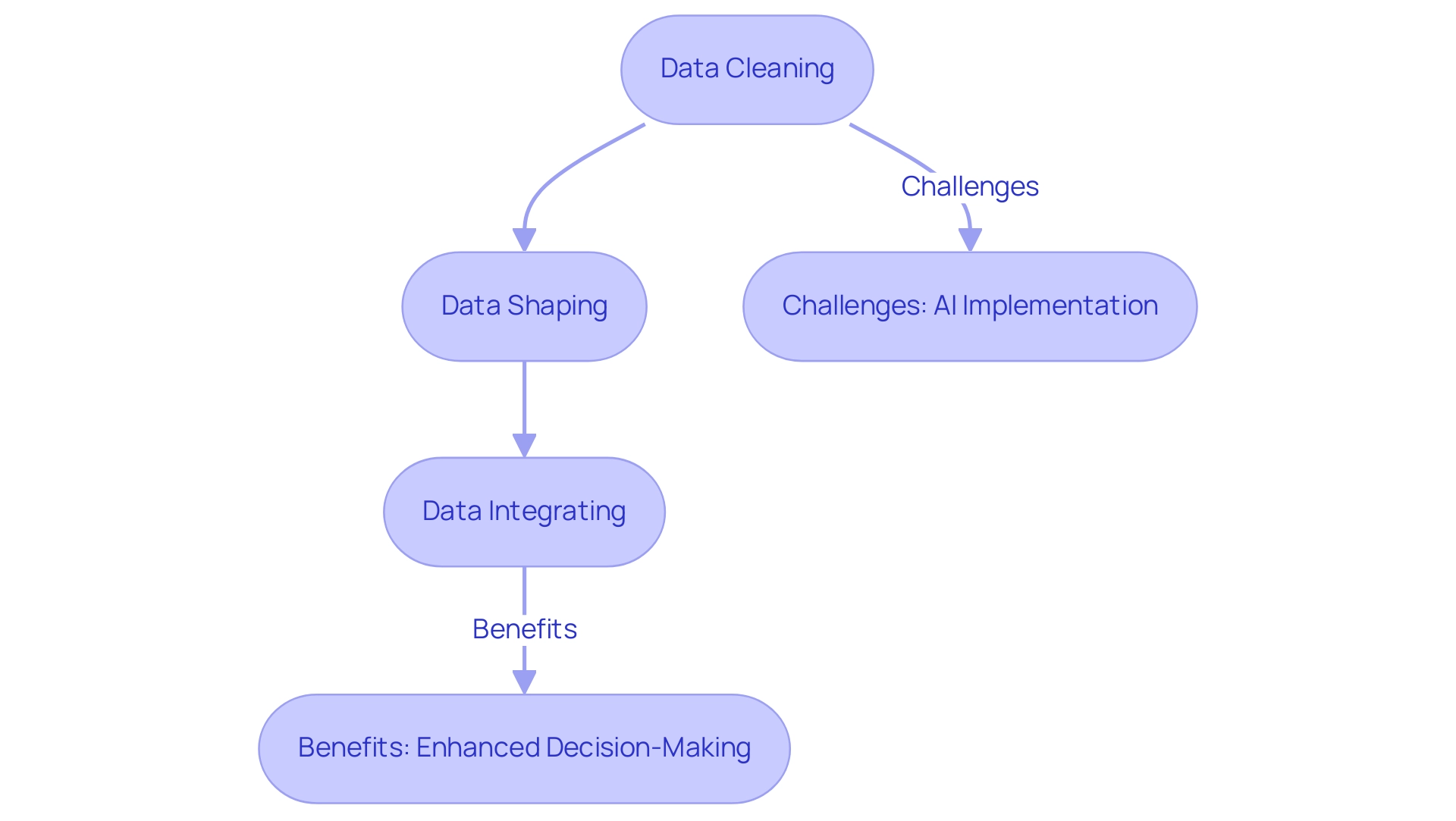
Exploring Tools for Data Transformation: Power Query and M Language
Power Query stands out as a formidable tool within BI, empowering users to seamlessly connect, combine, and refine content from diverse sources. Its user-friendly interface simplifies information transformation tasks, allowing users to execute operations such as filtering, sorting, and merging datasets effortlessly—no extensive coding knowledge required. As emphasized by Sayantoni Das,
Query is a commonly utilized ETL (Extract, Transform, Load) tool,
underscoring its essential role in the analytics landscape.
However, many users still encounter challenges with BI dashboards, such as:
- Time-consuming report creation
- Inconsistencies in information
- A lack of actionable guidance
In this context, incorporating RPA solutions such as EMMA RPA and Automate can significantly improve operational efficiency by automating repetitive tasks and lessening the load on staff, thus enabling users to concentrate on extracting actionable insights from their information. In contrast, M Language acts as a functional programming language that specifies the complexities of information alteration processes within Query.
It caters to advanced users by offering enhanced flexibility and control, enabling them to implement complex transformations that exceed the capabilities of the graphical interface. Significantly, choosing three columns can yield median or sum statistics, illustrating Query’s practical uses in analysis. Moreover, the upcoming Microsoft Analytics Community Conference, scheduled for November 12-14, 2024, presents an excellent opportunity for users to engage with the community and learn more about these tools.
Furthermore, the case study titled ‘Export Connections’ demonstrates how Query allows users to export connection details, streamlining the process of establishing connections and ensuring consistency in analysis projects. Together, Power Query and M Language establish a strong framework for effective data transformation in Power BI, equipping users with the essential tools to enhance their analysis projects while overcoming the typical challenges encountered in maximizing BI capabilities.
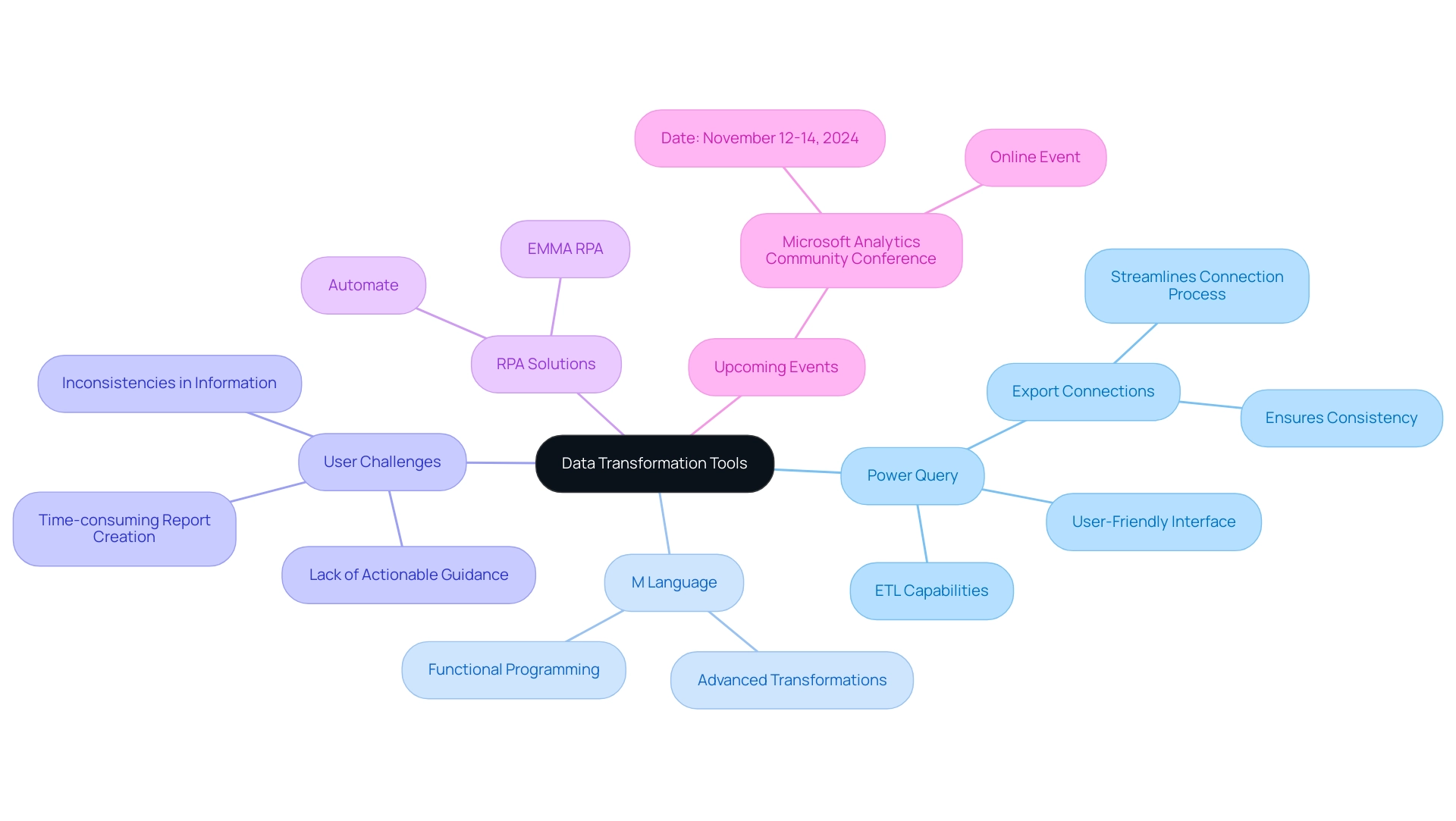
Key Techniques for Effective Data Transformation
Effective data transformation in Power BI is crucial for organizations aiming to leverage analytics for informed decision-making, especially in a rapidly evolving AI landscape. This process of data transformation in Power BI includes several key techniques, such as shaping, cleaning, and integration, which are significantly enhanced through Robotic Process Automation (RPA). Information shaping organizes and structures information to meet specific analytical requirements, ensuring that it is presented in a manner conducive to insight generation.
RPA can automate these manual workflows, boosting efficiency and reducing errors, thereby freeing your team for more strategic, value-adding work. Meanwhile, information cleaning focuses on identifying and rectifying errors or inconsistencies within the dataset, which is essential for maintaining integrity. However, many entities face significant challenges in implementing RPA and BI, including resistance to change and the complexity of integrating new technologies with existing systems.
According to recent studies, companies that adjust their technologies to meet employee needs can achieve up to 23% higher employee satisfaction and 22% greater profitability, emphasizing the significance of precise information in fostering a positive work environment. Yet, it’s important to note that in 2021, only 35% of companies worldwide achieved their digital objectives, illustrating the significant challenges organizations face. Furthermore, resistant company culture is noted as a challenge by 14% of respondents, suggesting that overcoming internal obstacles is crucial for successful information change.
Integration techniques further enhance the data transformation in Power BI by allowing users to consolidate information from various sources, creating a comprehensive view that is invaluable for analysis. For instance, the BFSI segment leads the digital transformation market with the largest revenue share, driven by enhanced consumer experiences and advanced technology adoption, which serves as a successful example of how effective information management can drive growth. With 17% of IT projects failing to a degree that threatens company survival, as noted in a study by the University of Oxford and McKinsey, the implications of effective information management cannot be overstated.
By utilizing these transformative techniques alongside RPA, entities not only ensure that their information is accurate and pertinent but also establish the foundation for obtaining meaningful insights through data transformation in Power BI, which can drive strategic decision-making and enhance operational efficiency. Furthermore, tailoring AI solutions to meet specific business needs is essential, as it allows organizations to address unique challenges and leverage technology effectively.
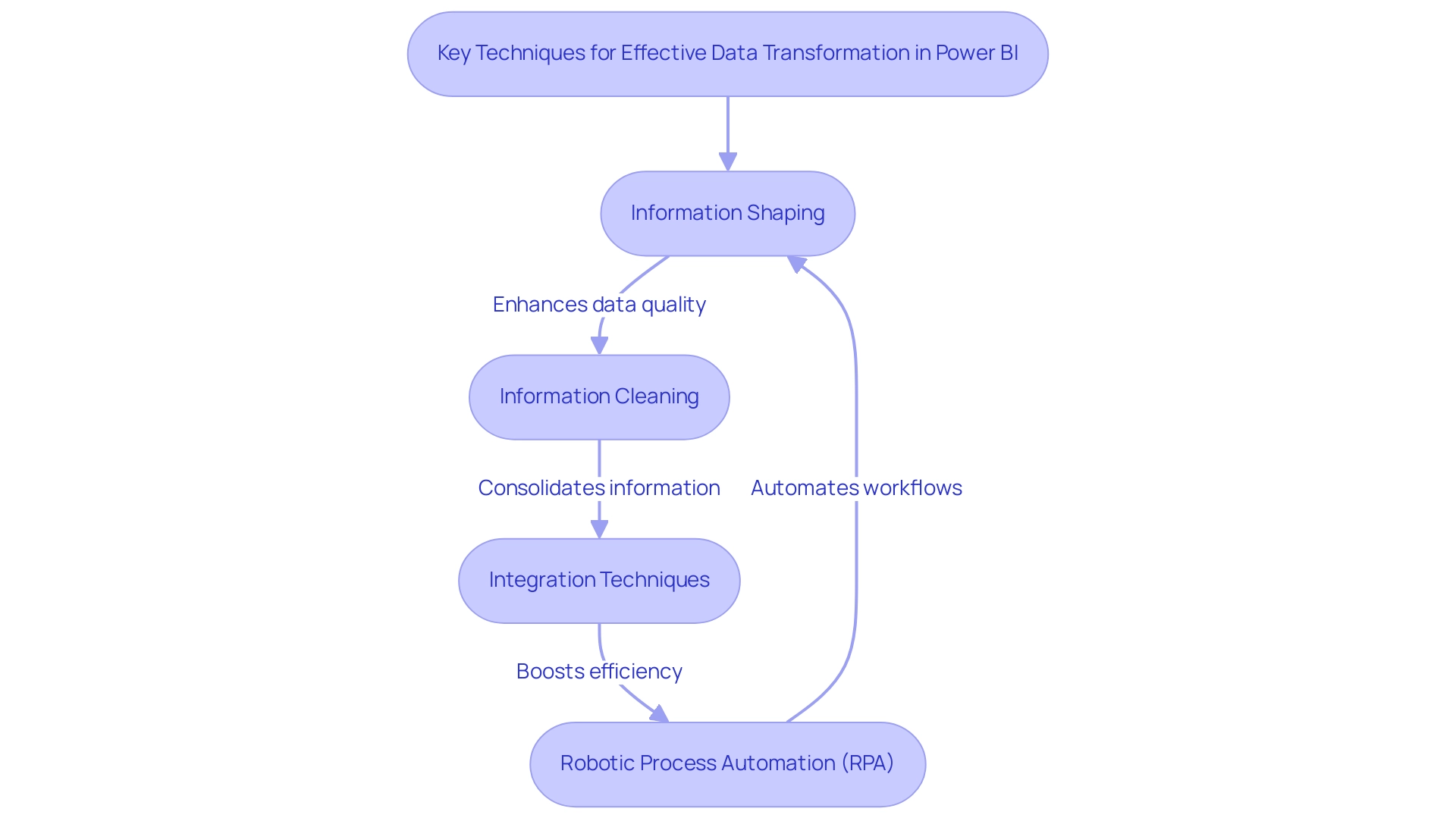
Leveraging Dataflows for Enhanced Data Management
Dataflows in Power BI are crucial for data transformation in Power BI, optimizing information conversion processes at scale and significantly enhancing efficiency across various reports and dashboards. By allowing users to define, manage, and centralize transformation tasks, dataflows minimize redundancy and ensure that all stakeholders access the same up-to-date information—vital for informed decision-making regarding data transformation in Power BI. As Sascha Rudloff, Team leader of IT and Process Management at PALFINGER, observed, ‘The outcomes of the sprint surpassed our expectations and were a significant enhancement for our analysis strategy.’
The recent success of CREATUM’s Power BI Sprint with PALFINGER demonstrates the impact of data transformation in Power BI: it not only led to an immediately usable Power BI report and gateway setup but also expedited PALFINGER’s overall Power BI development, enhancing their analysis strategy. Furthermore, information flows can connect to a variety of sources, establishing a consistent pipeline that enhances quality and accessibility across departments through data transformation in Power BI. As of 2024, the usage of information flows has surged, underscoring their growing importance in the effective management of data transformation in Power BI.
Recent advancements, such as saving information flows as drafts, support data transformation in Power BI, providing entities with enhanced flexibility in managing their strategies and driving operational efficiency. Additionally, leveraging refresh statistics optimizes performance, while case studies such as ‘Mitigating Long Refresh Durations’ provide practical solutions for addressing challenges associated with data transformation in Power BI and complex dataflows. The incorporation of Robotic Process Automation (RPA) further improves this process by automating repetitive tasks, which not only alleviates the burden of time-consuming report creation but also addresses inconsistencies, empowering operations leaders to harness insights that drive business growth and efficiency.
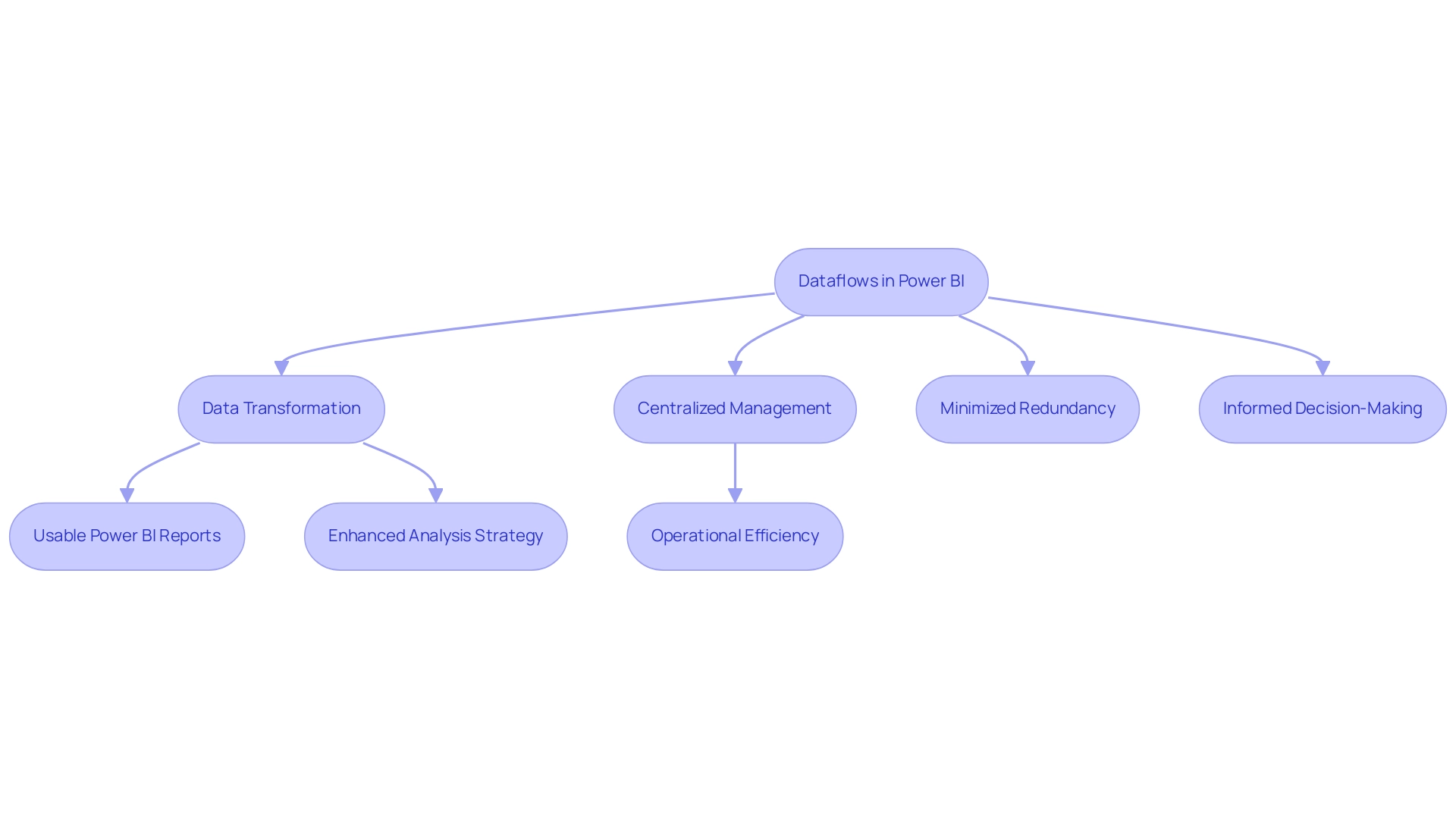
Best Practices for Transforming Data in Power BI
To enhance data transformation in Power BI, organizations must adopt a set of best practices that streamline processes and improve collaboration while leveraging Robotic Process Automation (RPA) to automate manual workflows.
Firstly, maintaining clear documentation of all change steps is crucial; it fosters knowledge sharing and ensures that team members can easily understand and replicate processes. Moreover, applying a filter condition to showcase rows where Total Amount is greater than or equal to $100 acts as a practical illustration of practices that prioritize information quality.
Secondly, prioritizing information quality through systematic validation checks and thorough cleaning routines is essential within the data transformation in Power BI workflow, as it directly impacts the reliability of analytics outcomes. Moreover, harnessing the power of Power Query and M Language allows teams to automate repetitive tasks, minimizing human error and enabling analysts to concentrate on strategic initiatives, thus enhancing operational efficiency and freeing up resources for more value-adding work. Merging queries to combine information based on a common column is another key practice that enhances integration and analysis.
As entities navigate the rapidly evolving AI landscape, routinely assessing and refreshing transformation practices to address shifting business needs and information sources is essential. This landscape presents challenges that tailored AI solutions can help address, ensuring entities can cut through the noise and implement effective strategies. As emphasized by the quote from Power BI, ‘Learn about the Power BI security best practices to protect your valuable information,’ implementing these strategies ensures high-quality information for reporting and maximizes the value of investments in advanced analytics.
By following these best practices and integrating RPA, organizations can significantly enhance their data transformation in Power BI capabilities, ultimately leading to improved business outcomes.
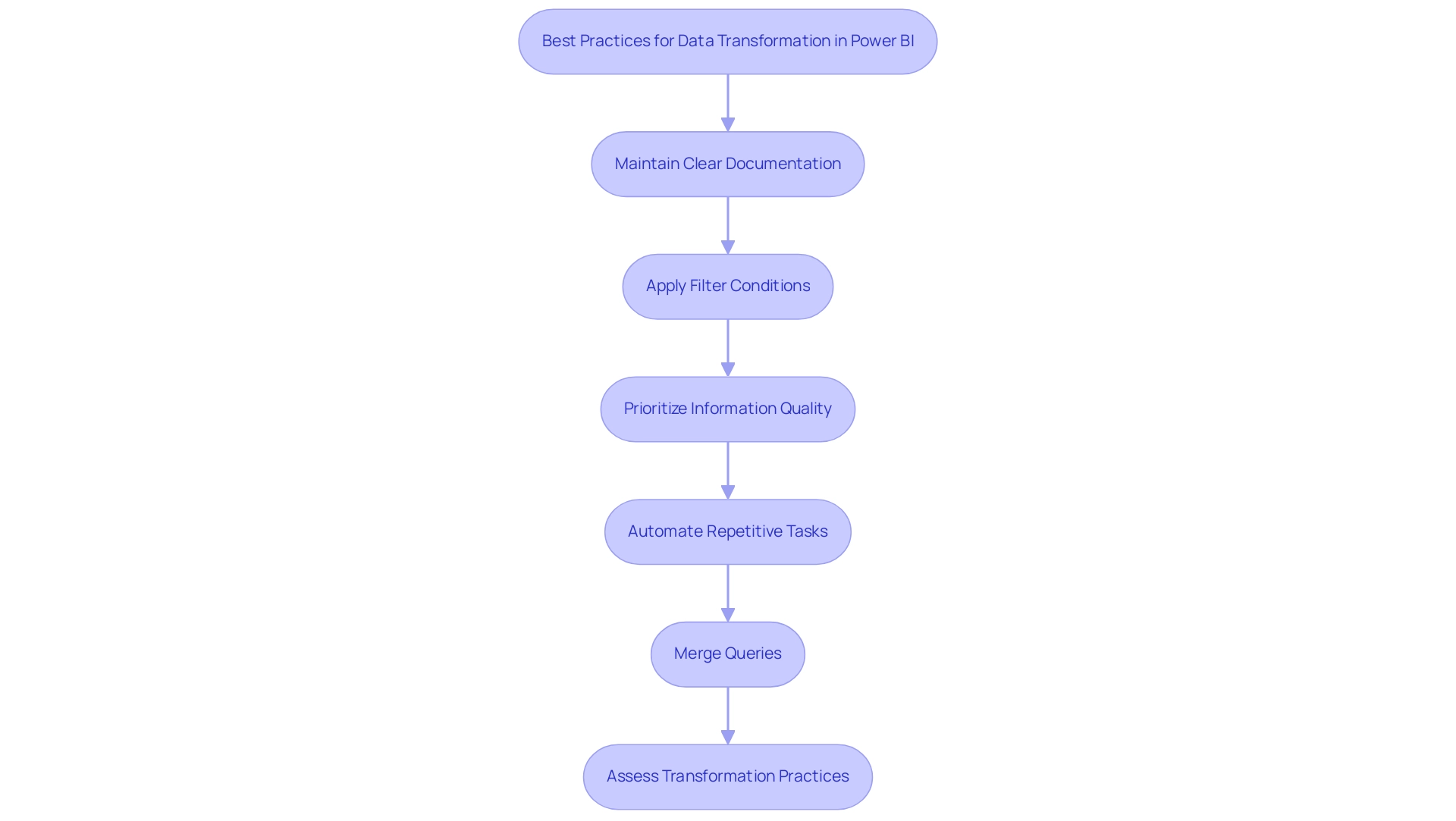
Conclusion
The journey of effective data transformation in Power BI is pivotal for organizations aiming to thrive in a competitive landscape. Through the processes of cleaning, shaping, and integrating diverse data sources, businesses can enhance data quality and make informed decisions swiftly. The integration of advanced tools like Power Query and M Language, alongside Robotic Process Automation (RPA), empowers teams to streamline workflows, reduce manual errors, and focus on strategic initiatives that drive growth.
Implementing key techniques such as:
- Data shaping
- Cleaning
- Integration
not only enhances operational efficiency but also lays the groundwork for deriving meaningful insights. As organizations embrace dataflows, they can centralize and manage transformation tasks, ensuring that all stakeholders have access to the most accurate and up-to-date information. This capability is essential for informed decision-making in today’s rapidly evolving digital landscape.
By adopting best practices that prioritize documentation, data quality, and systematic validation, organizations can significantly improve their data transformation processes. This enables them to navigate the challenges posed by economic uncertainty and digital transformation with confidence. Ultimately, effective data management and transformation strategies are not just about technology; they are about empowering teams to harness the full potential of their data, driving operational efficiency and fostering a culture of data-driven decision-making. Embracing these practices today will pave the way for a more resilient and successful future.
Introduction
In the realm of data visualization, Power BI stands out as a powerful tool that transforms raw data into actionable insights. As organizations strive to enhance their reporting capabilities, understanding the nuances of data labels becomes paramount. These labels not only convey essential metrics but also facilitate a clearer interpretation of trends and patterns, making them indispensable for effective decision-making.
By mastering the art of customizing data labels, professionals can significantly elevate the clarity and impact of their visualizations. This article delves into practical strategies for optimizing data labels, from establishing a robust data model to employing advanced techniques that enhance user engagement.
As businesses navigate the complexities of data management, these insights will empower them to harness the full potential of Power BI, driving efficiency and fostering informed choices.
Understanding Data Labels in Power BI: An Overview
In Power BI, the use of data label power bi serves as essential instruments for efficiently communicating insights within visual representations, allowing viewers to quickly grasp important metrics. These tags show values associated with particular data points, simplifying the analysis of trends and patterns. As Mitchell Pearson, an experienced Data Platform Consultant and Training Manager at Pragmatic Works, points out, ‘A key aspect is creating a DAX calculation named ‘custom identifier’, which allows for the display of desired information.’
Customizing data labels in Power BI can substantially enhance the clarity and effect of your documents, ensuring that your audience receives critical insights at a glance. In addressing common challenges such as time-consuming report creation and inconsistencies, effective data label power bi strategies become essential. The absence of a governance strategy can result in confusion and mistrust in the information presented, making the implementation of clear data label power bi practices even more important.
To create impactful dashboards, consider:
- Showing all important information on a single screen for quick access to essential details.
- Utilizing tools like Microsoft Copilot and predictive analytics to enhance your reporting capabilities.
The column statistics chart shown below the preview section can further enhance understanding.
By concentrating on personalized information tags, as emphasized in numerous case studies, you can greatly enhance the clarity of your visual representations, aiding improved decision-making processes and ultimately fostering growth through insight-driven analysis.
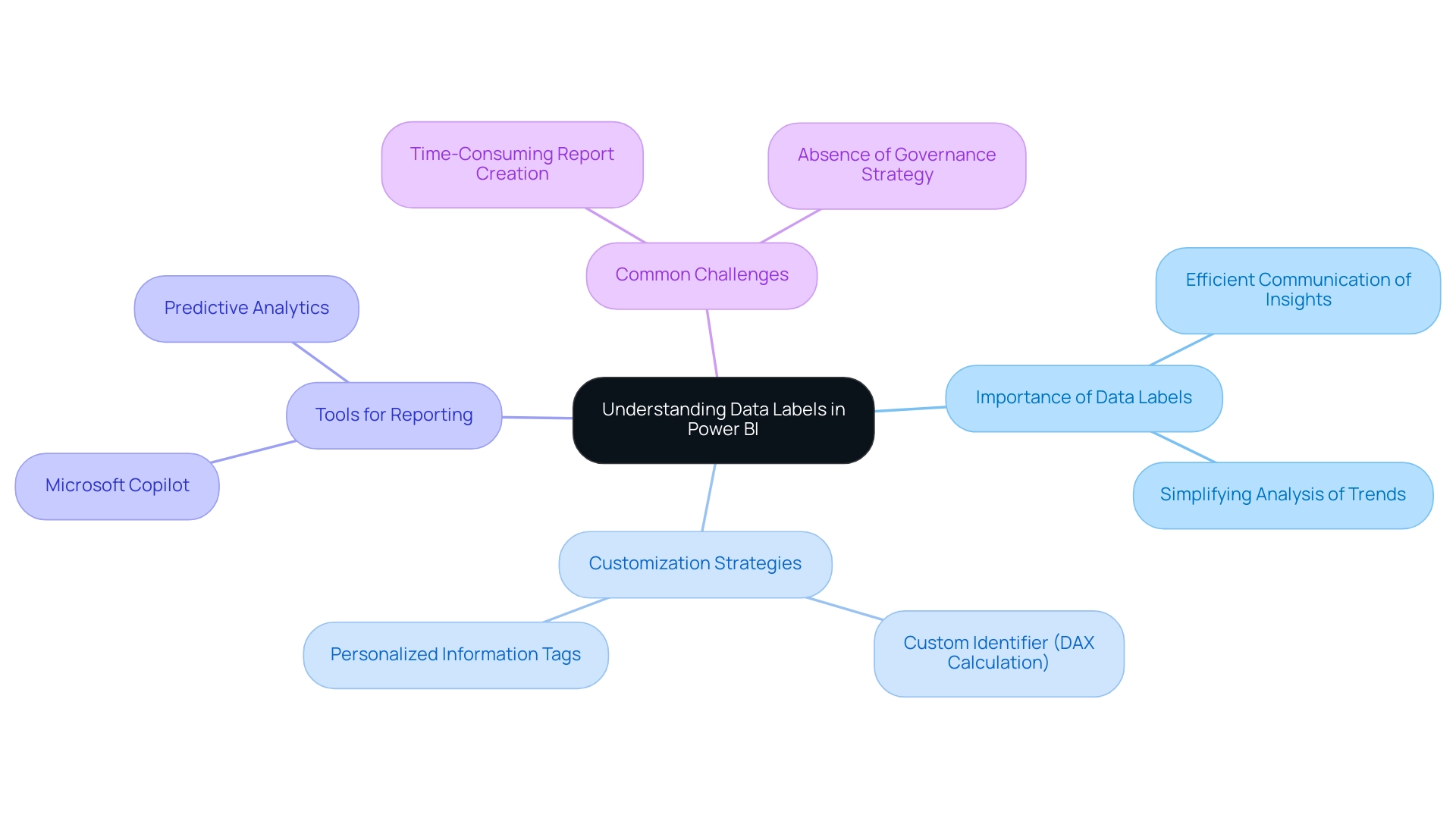
Essential Preparations for Customizing Data Labels
To effectively personalize data label Power BI, it is essential to create a dedicated calendar table within your information model. This essential component serves as the backbone for time-based analysis, facilitating the creation of measures that significantly improve your data label Power BI. Denys Velykozhon highlights the significance of such structures in his discussions on reporting, stressing that a solid foundation is key to effective information interpretation.
Furthermore, leveraging Business Intelligence tools like EMMA RPA and Power Automate can streamline this process, transforming raw information into actionable insights that drive efficiency and growth. Additionally, while Power BI offers the Auto date/time option for simple model requirements and ad hoc information exploration, it does not support a single date table design for multiple tables, making the use of a dedicated calendar table with data label Power BI a better choice for complex models. This choice can alleviate common challenges such as inconsistencies and time-consuming report creation, enabling a more efficient workflow.
Moreover, when a model already has a date table and another is needed for a role-playing dimension, a calculated table can be created to clone the existing date table using DAX. However, it’s essential to note that the cloned table only creates columns without applying model properties like formats or descriptions, and hierarchies are not cloned. Presenting the earliest date in the model as Min Date and the latest date as Max Date further emphasizes the significance of implementing a calendar table for effective information modeling, especially in relation to the data label Power BI.
Getting accustomed to the visualizations you plan to utilize is also essential, as each may provide unique options for showcasing labels. Comprehending the interplay between your information structure and visualization types will empower you to establish an effective groundwork for your customization efforts, ultimately driving insightful analysis and informed decision-making. By utilizing RPA tools, organizations can automate repetitive reporting tasks, enabling teams to concentrate on deriving insights instead of getting bogged down in preparation.

Creating Measures for Enhanced Data Labeling
Developing metrics for improved data label power bi is a simple yet impactful procedure that can greatly enhance your reporting abilities and boost operational efficiency. Begin by navigating to the ‘Modeling’ tab in Power BI Desktop and selecting ‘New Measure.’ Here, you’ll harness the power of DAX (Data Analysis Expressions) to define the metrics you wish to display.
For example, to illustrate total sales for a specific category, your DAX formula would be structured as follows: Total Sales = SUM(Sales[Amount]). Upon creation, these measures effortlessly merge into your labels, enabling dynamic updates that react to user interactions with the document. This method not only improves the clarity of your visuals but also enables stakeholders to extract insights swiftly and efficiently, tackling common issues such as time-consuming document creation and inconsistencies in information.
Furthermore, it is essential to provide actionable guidance within these reports to ensure stakeholders understand the next steps they should take based on the information presented. As mentioned by Super User Amit Chandak at the Microsoft Analytics Community Conference:
Join us as experts from around the world unite to shape the future of information and AI! This event highlights the increasing importance of information management and visualization in the industry.
Furthermore, it’s essential to keep pertinent dashboards, as displays not shown likely haven’t been utilized in over 90 days. The ability to leverage DAX for enhanced data label power bi, especially in visualizations like column charts, highlights the importance of interpreting information effectively. For instance, displaying mean, median, mode, and standard deviation together can highlight outliers, presenting a well-rounded view of your dataset, which aligns with the practical steps outlined in our guide.
Additionally, incorporating RPA solutions can further streamline reporting processes, reducing the time spent on report creation and enhancing overall operational efficiency.
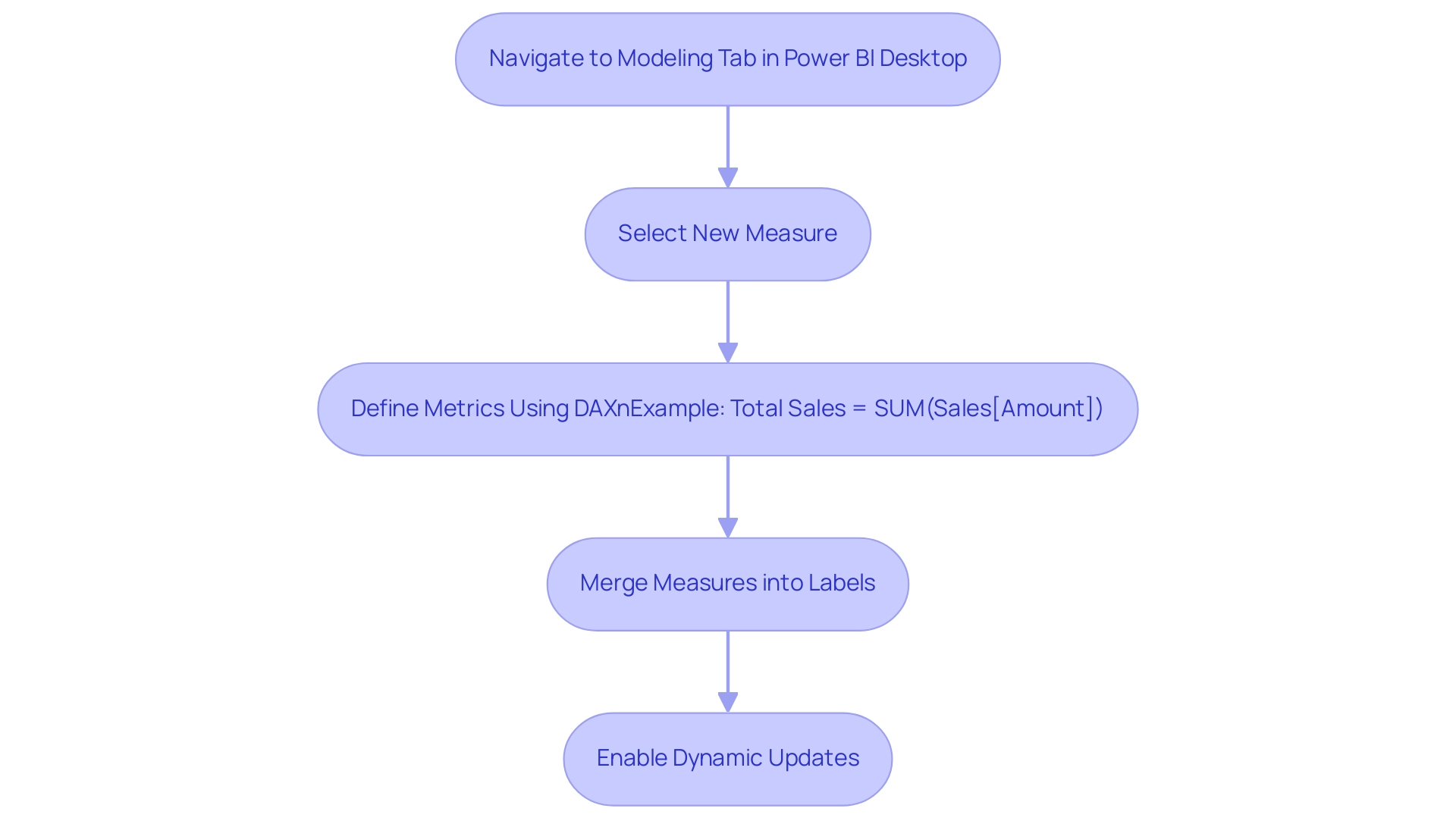
Formatting Visuals for Effective Data Label Presentation
To achieve effective data presentation in Power BI, start by selecting the visual you want to customize and then use the data label Power BI feature in the ‘Format’ pane. Here, you can modify essential settings such as font size, color, and position of the text. Increasing the font size can significantly enhance visibility, while choosing colors that contrast with the background ensures that text stands out.
According to Vinay Koshy, founder of Sproutworth,
Articles containing relevant images get 94% more total views compared to those without visuals, underscoring the importance of visual elements in communication. Additionally, 65% of companies indicate heightened client engagement and comprehension when employing visual representation in their presentations. Notably, infographics and visual content are shared and liked three times more than any other type of content on social media, highlighting their effectiveness in engagement.
Additionally, a case study on video marketing reveals that 85% of businesses consider it an effective tool for enhancing brand recall and increasing purchase intent, further emphasizing the impact of visual tools in communication. By integrating insights from Business Intelligence and leveraging RPA to automate repetitive reporting tasks, you can streamline your workflow, reduce errors, and free up your team for more strategic decisions. Thus, try out these formatting choices to achieve a balance between appearance and clarity; this will guarantee your data label Power BI effectively communicates the intended insights.
By following best practices for enhancing visibility, such as consistent formatting and strategic placement, you can maximize the impact of your presentations while overcoming challenges like inconsistencies and time-consuming report creation. Current trends in visual customization indicate that tailored visuals not only improve comprehension but also foster engagement, as design experts suggest that integrating dynamic elements can significantly enhance the viewer’s experience. Additionally, utilizing RPA can address task repetition fatigue, thereby improving operational efficiency and allowing your team to focus on high-value activities.
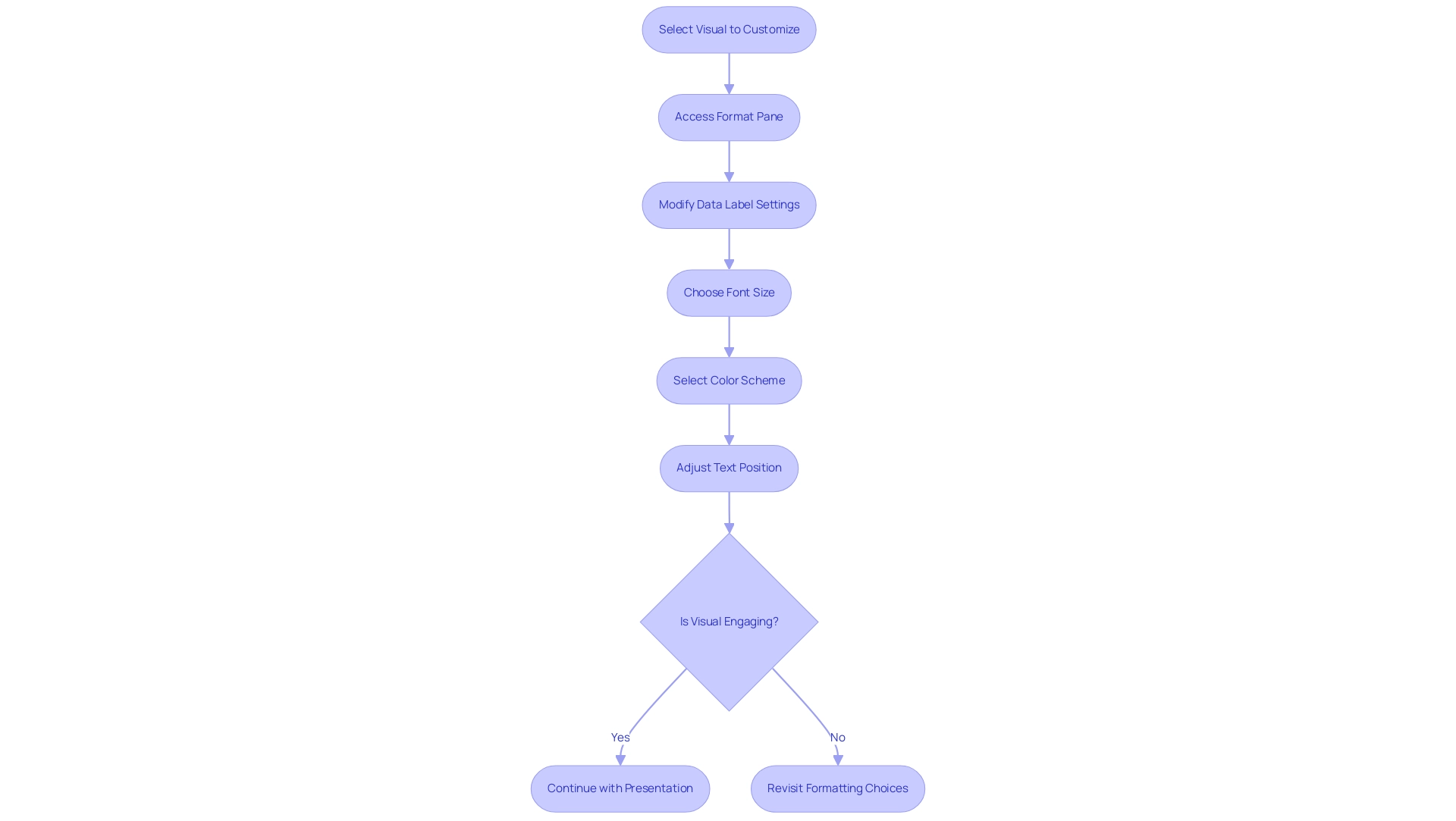
Advanced Techniques for Dynamic Data Label Customization
To leverage advanced techniques for dynamic information customization in Power BI, utilizing DAX expressions is essential for establishing conditional formatting rules. By applying these guidelines, you can modify information tags to alter hues according to particular value limits, greatly enhancing visual indicators and boosting understanding. This transformation is key in a data-rich environment where extracting meaningful insights is crucial for maintaining a competitive advantage, especially in light of the common challenges many organizations face in this area.
Additionally, integrating RPA solutions can streamline processes and enhance operational efficiency, further supporting the goal of utilizing Business Intelligence to drive growth and innovation. Incorporating tooltips can offer additional context, enhancing the story communicated by your information tags. This approach not only elevates the interactivity of your reports but also aligns with the broader goal of utilizing Business Intelligence to drive growth and innovation.
As you refine these techniques, consider how user interactions with data label power bi can elevate the overall effectiveness of your reporting strategy. For those looking to deepen their understanding, weekend training sessions are available on August 13, 14, 18, 19, 20, 21, 22, 25, 26, and 28, 2025. As Amitabh Saxena aptly states, ‘Enroll Now’ to take advantage of these learning opportunities.
Furthermore, the case study titled ‘Understanding Complex Formulas in Power BI’ highlights the challenges users face when dealing with complex formulas, particularly in calculating totals, emphasizing the need for advanced logic essential for high-quality development in Power BI, such as the implementation of data label power bi.
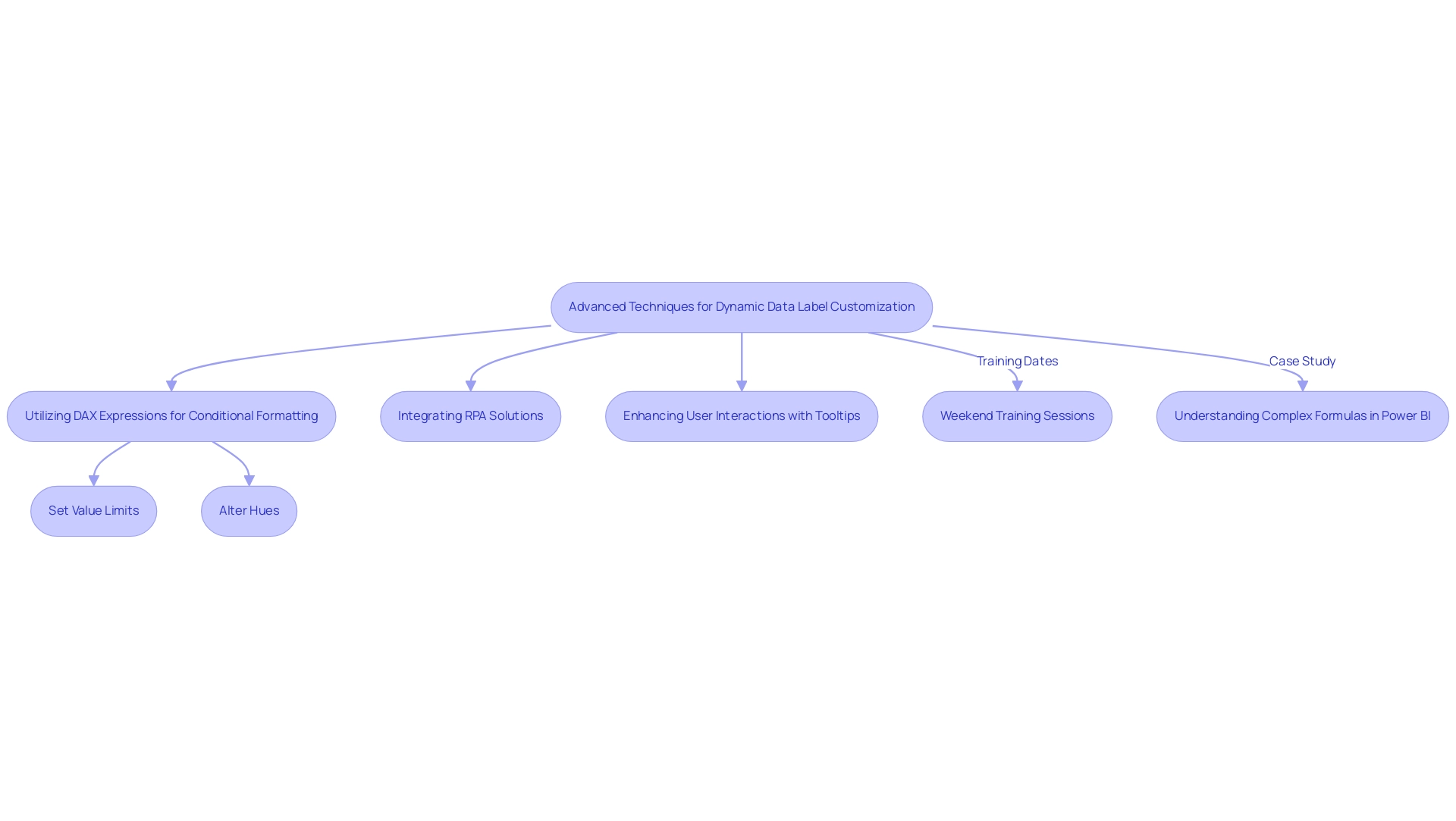
Conclusion
Customizing data labels in Power BI is not just a technical necessity; it is a strategic advantage that can transform how organizations interpret and act on their data. By effectively utilizing data labels, professionals can convey critical insights, making complex datasets accessible and actionable for stakeholders. Establishing a solid data model, particularly through the creation of a dedicated calendar table, serves as a foundation for enhanced data analysis and reporting.
Moreover, the integration of DAX measures allows for dynamic updates that enrich data labels, ensuring clarity and relevance in every report. The importance of formatting visuals cannot be overstated, as thoughtful adjustments can significantly improve readability and engagement. Utilizing advanced techniques, such as conditional formatting and tooltips, further elevates the impact of data labels, making them not only informative but also visually engaging.
In a landscape where data-driven decision-making is paramount, mastering these labeling strategies in Power BI empowers organizations to navigate complexities with confidence. By prioritizing clear and customized data labels, businesses can not only enhance their reporting capabilities but also foster a culture of informed decision-making that drives growth and operational efficiency. Embracing these practices is essential for staying competitive and maximizing the potential of data insights.
Introduction
In the dynamic landscape of data management, harnessing the power of tools like Power BI can transform how organizations derive insights and make decisions. As businesses increasingly rely on data to drive their strategies, understanding how to effectively access, configure, and troubleshoot data sources becomes paramount.
This article delves into essential practices for optimizing Power BI, including:
- Selecting the right datasets
- Setting up scheduled refreshes
- Resolving common connection issues
By implementing these strategies, organizations can:
- Streamline their operations
- Enhance data accessibility
- Foster a culture of data-driven decision-making that propels growth and efficiency.
Getting Started: Accessing Power BI and Selecting Your Dataset
- Start by signing into the Power BI Service with your organizational credentials, ensuring secure access to your information.
- Navigate to the ‘Datasets’ section in the left-hand menu to familiarize yourself with your available options.
- Click on ‘Get Information’ to explore a variety of resources that can improve your analysis.
- Carefully select the dataset that best aligns with your analysis goals, taking into consideration the specific insights you wish to derive.
- If necessary, import information from other reliable sources such as Excel, SQL Server, or various cloud services to enrich your dataset.
- Validate that the dataset has been successfully loaded and is visible within your workspace, confirming that you’re ready to leverage BI’s capabilities.
Remember, 88% of organizations utilizing cloud-based BI report increased flexibility in accessing and analyzing their information, reinforcing the importance of selecting the right datasets. As lbendlin, a Super User, aptly states,
BI is a business decision support tool. What you actually want to measure is its impact on business decision making.
Additionally, the global cloud-based BI market is projected to reach $15.2 billion by 2026, growing at a CAGR of 22.8% from 2021 to 2026, highlighting the increasing relevance of these tools in modern business. Furthermore, with the ever-evolving AI landscape, tailored AI solutions are essential for cutting through the noise and aligning with specific business goals. Integrating RPA into your workflow can significantly enhance efficiency by automating repetitive tasks, such as data entry and report generation, allowing your team to focus on strategic initiatives. By following these steps, you position yourself to maximize the advantages of BI in your operations. For instance, a recent case study demonstrated how a mid-sized retail company improved its sales forecasting accuracy by selecting specific datasets in Power BI, leading to data-driven decision-making and enhanced operational efficiency.
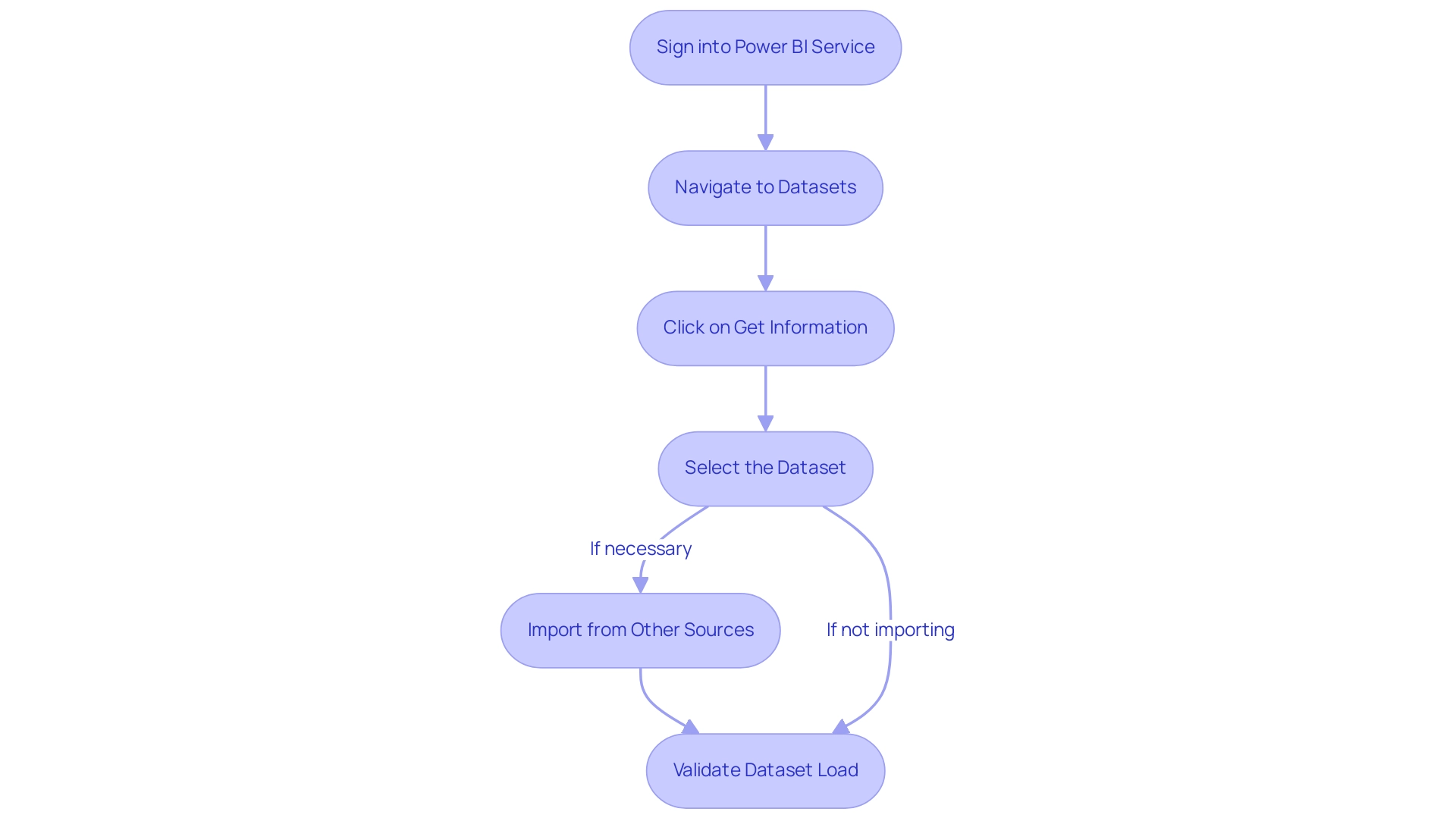
Configuring and Troubleshooting Data Source Credentials in Power BI
- Begin by navigating to the ‘Datasets’ tab within your workspace and locating the specific dataset you wish to configure with the data source credentials power bi.
- Click on the ellipsis (…) adjacent to the dataset and select ‘Settings’ from the dropdown menu.
- In the ‘Data access authentication’ section, select your preferred authentication method, such as Basic or OAuth2, to manage the data source credentials power bi. It is essential to note that for information providers utilizing an ACE OLEDB provider, selecting Anonymous authentication can prevent sign-in errors, as Windows authentication is not supported.
- Input your details and click ‘Sign In’ to establish the connection.
- If you face any problems, verify that your access details are correct and ensure that you have the required permissions to reach the information repository. Aniya Zhang, a Community Support representative, highlights that if you receive an ‘Invalid message’ notification, this often pertains to the cache of the Odata information. To address this, navigate to the ‘Manage gateway and information stream’ page, locate the Odata resource definition, and click ‘Delete.’ Afterward, navigate to the dataset settings interface, click ‘Edit access details,’ and re-enter the information for the Odata connection to ensure proper configuration. This procedure is especially significant given a recent information issue that occurred for a file at https://company_name.sharepoint.com/sites/Projects/Shared%20Documents/file_name.xlsx, which highlights the necessity of keeping precise data source credentials power bi.
- Additionally, verify any firewall or network restrictions that could hinder access. Remaining updated on frequent information access authorization challenges in 2024 can greatly simplify troubleshooting, enabling you to address issues effectively. By unlocking the full potential of Business Intelligence and RPA tools such as EMMA RPA and Automate, you can transform these information management processes, streamline operations, and ultimately drive business growth. Failing to extract meaningful insights can leave your business at a competitive disadvantage. For additional insights, refer to the case study titled ‘Changing Authentication Mode in Power BI Service,’ which illustrates the steps to access dataset settings and adjust source credentials effectively.
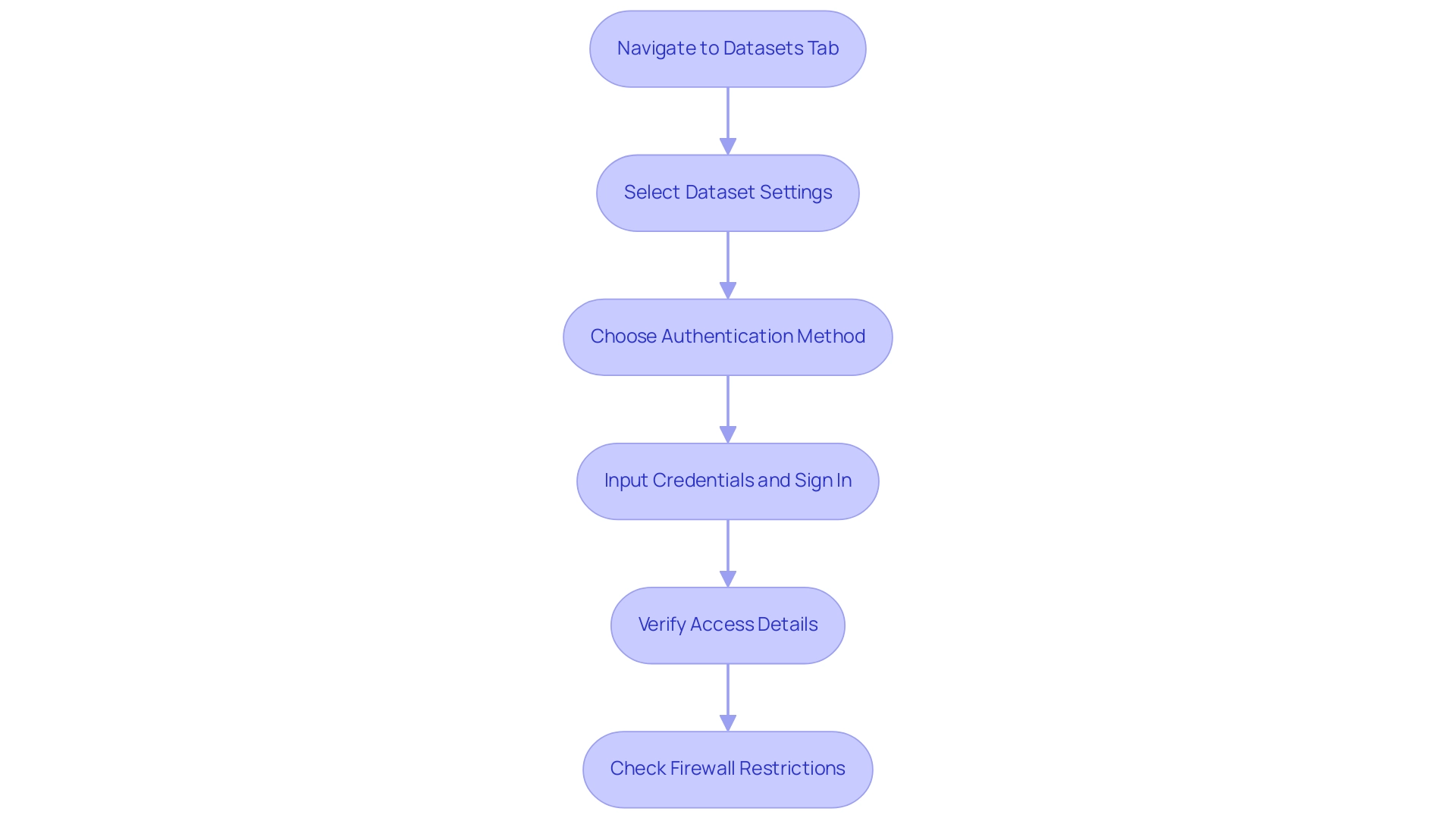
Setting Up Scheduled Refreshes: Best Practices and Prerequisites
- Access the dataset settings and navigate to the ‘Scheduled refresh’ section to begin configuring your information management effectively.
- Activate the ‘Keep information updated’ toggle to ensure continuity in availability.
- Determine the refresh frequency that aligns with your operational requirements—options include daily or weekly refreshes, with a maximum of 48 refreshes per day for Premium licenses at intervals of up to 30 minutes.
- Carefully set the time zone and designate your preferred refresh times to enhance availability for users.
- Validate that your data source credentials in Power BI are current and confirm that the source is accessible during the scheduled refresh periods to avoid interruptions. As BrandonGi noted, issues can arise if the custom connectors folder is empty, which can hinder refresh functionality.
- Regularly review the refresh history to detect any failures, allowing you to make necessary adjustments and maintain efficient operations.
Recent updates in BI emphasize the significance of understanding refresh limitations, particularly for those utilizing Premium licenses. To enhance refresh capabilities and ensure seamless integration of information, consider leveraging tools such as Automate for automated workflow solutions and EMMA RPA for user-friendly digitalization. EMMA RPA stands out with its diverse applications and intuitive interface, making it accessible for all users, while Power Automate allows you to streamline workflows effortlessly. These tools not only enhance operational efficiency but also tackle challenges such as time-consuming report creation and inconsistencies. Engaging with the community, including insights from top kudoed authors like danextian and lbendlin, can provide valuable perspectives on refresh strategies. For a more personalized approach, book a free consultation to explore how these solutions can drive data-driven insights for your organization.

Troubleshooting Common Data Source Connection Issues in Power BI
- Verify Information Accessibility: Begin by confirming that the information repository is online and reachable. Issues often arise from network disruptions or server outages, making it essential to ensure accessibility to avoid competitive disadvantages in today’s data-rich environment. According to recent statistics, the total dashboards or reports in the organization with at least one view in the past 90 days underscores this necessity.
- Check Data Source Credentials Power BI: Ensure that your data source credentials Power BI are valid and have not changed. Invalid data source credentials Power BI are a common cause of connection errors, which can hinder your ability to leverage meaningful insights from your BI dashboards.
- Review Error Messages: Pay close attention to the error messages provided by Power BI. These messages frequently include specific guidance that can direct you to the origin of the issue, facilitating a faster resolution and ensuring that actionable insights are readily accessible to drive growth.
- Assess Firewall Settings: Ensure that your organization’s firewall configurations allow access to the information repository. Firewalls can inadvertently block necessary connections, so it’s crucial to verify these settings to maintain operational efficiency.
- Confirm Gateway Status: If you’re using a gateway to connect to your information source, check that it is online and properly configured. A misconfigured gateway can impede data access, preventing you from transforming raw data into actionable insights.
- Utilize Community Resources: Consult the BI community forums for similar issues and potential solutions. Engaging with other users can provide valuable insights and troubleshooting strategies. As noted by a frequent visitor, Thank you David, this is true. The ADD COLUMN / STATISTICS idea of this is to provide statistics on several columns aggregation (not just two): the sum of all columns, average of all, etc… This community insight can enhance your understanding and approach to resolving connection errors. Additionally, consider the case study titled “Creating a Fresh Usage Metrics Report,” where users were instructed to refresh their browser and create a new usage metrics report in the BI service after deleting the semantic model. This process ensured access to updated and accurate usage metrics, providing a practical example of troubleshooting in action.
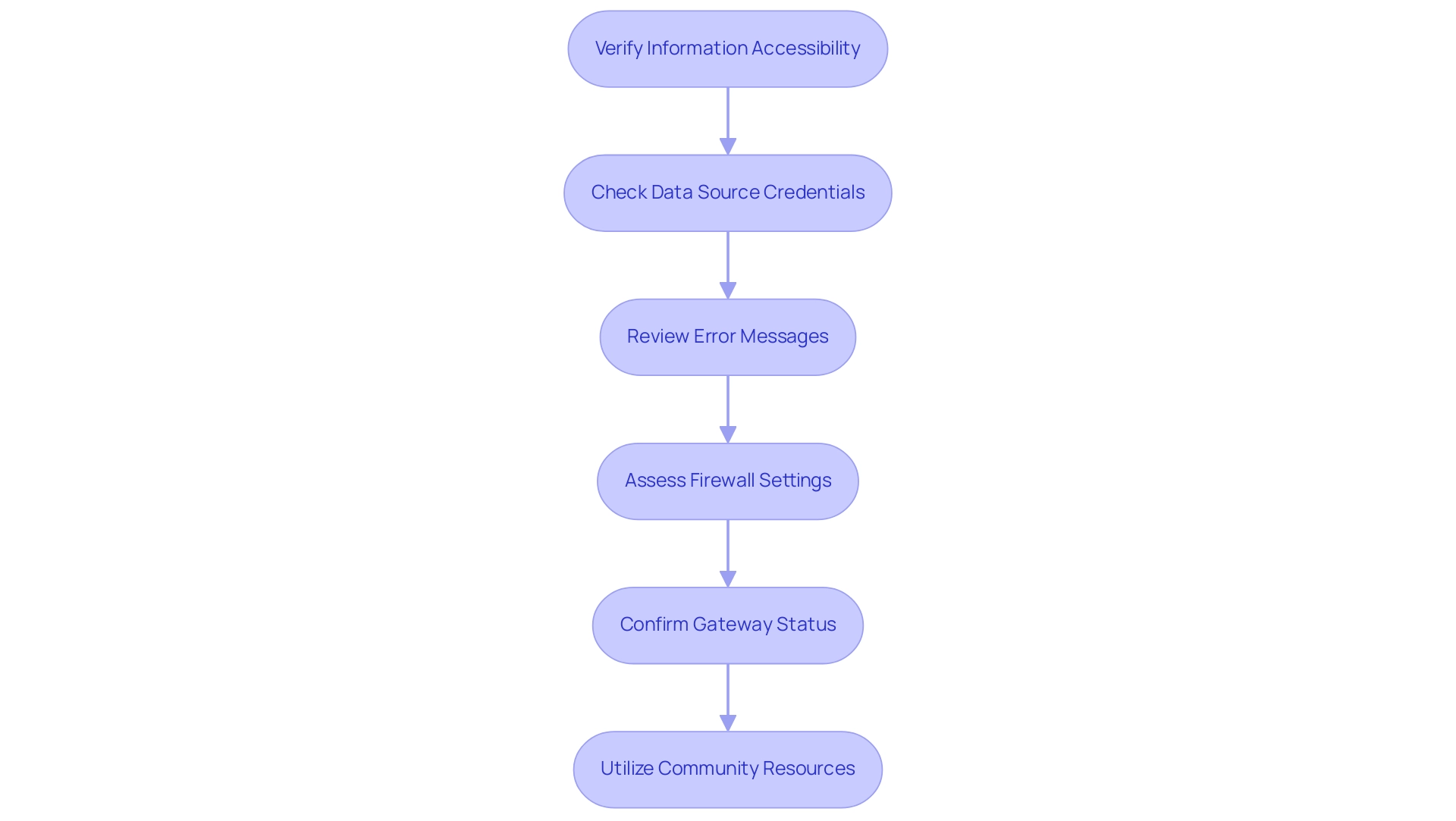
Exploring Compatible Data Sources for Power BI
-
Start by examining the extensive compilation of supported information origins in Power BI, which features popular choices like SQL Server, Excel, SharePoint, and Azure, while also considering the data source credentials Power BI for creating or importing information using files such as Excel, Power BI Desktop files, and CSV files. These references are crucial for efficient information management and integration.
-
Utilize cloud-based information repositories to unlock real-time analytical capabilities, improving your capacity to make well-informed decisions quickly. Recent trends indicate that approximately 70% of organizations are increasingly relying on cloud solutions to improve their data-driven strategies.
-
Thoroughly assess the information types and frameworks of each origin to verify they conform with your particular reporting needs, ensuring smooth integration and precise insights. Utilizing Robotic Process Automation (RPA) can significantly reduce the time spent on these evaluations, minimize errors, and allow your team to focus on strategic initiatives.
-
Before finalizing your dataset selections, conduct thorough testing of connections to various data source credentials Power BI in Desktop. This step is essential for identifying potential issues early in the process, enabling you to mitigate challenges such as inconsistencies and ensure quality reporting.
-
Stay informed about the latest updates and new connectors released by Power BI. Consistently investigating these innovations will significantly broaden your information integration capabilities and enhance overall operational efficiency. As highlighted by expert Sahir Maharaj, fostering collaboration and knowledge-sharing can further empower your efforts. Additionally, consider strategies for navigating data management challenges, as illustrated in the case study titled ‘How to deal with office politics in an IT Company,’ which offers practical advice for maintaining professionalism and fostering a positive work culture.
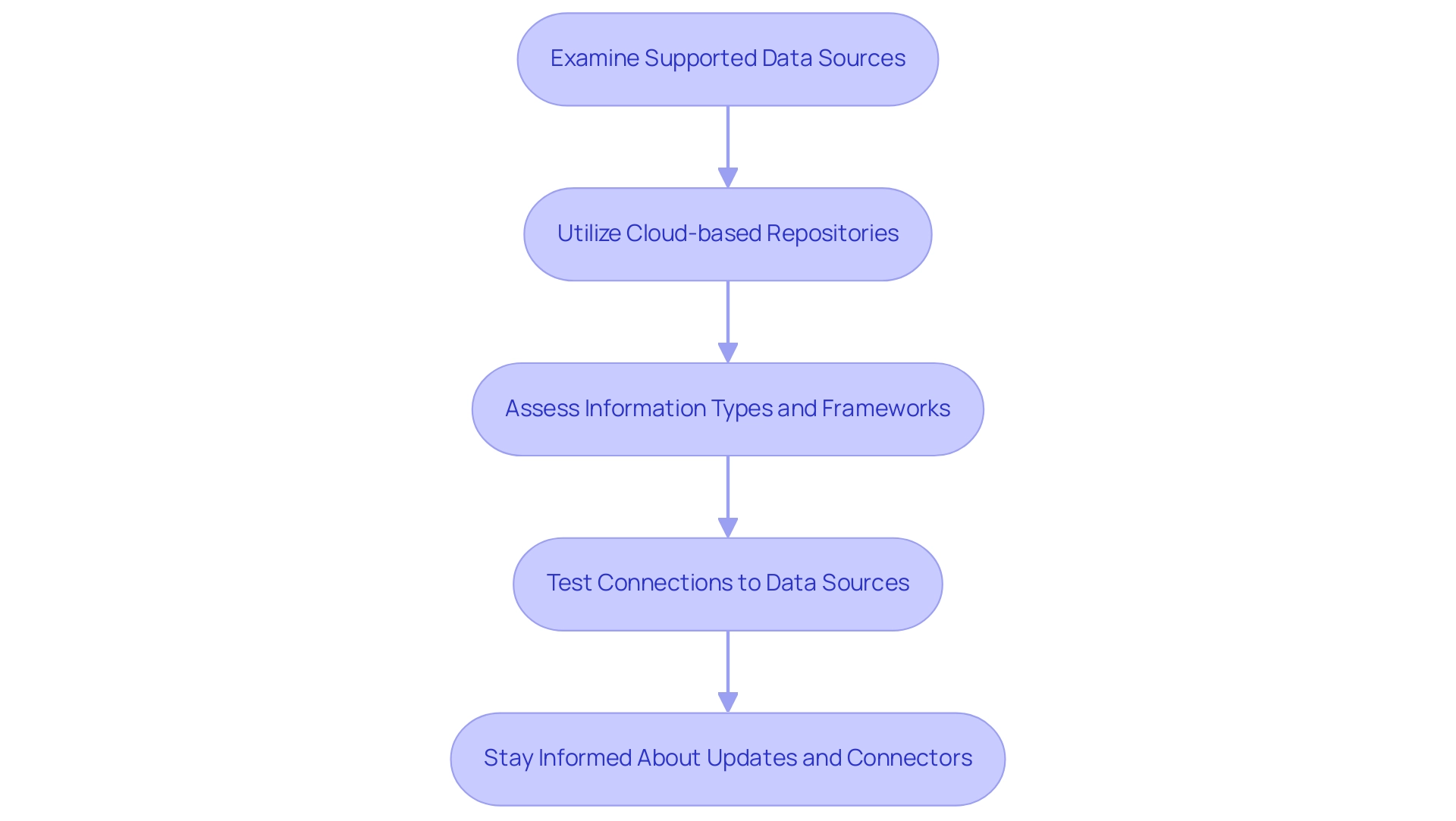
Conclusion
Harnessing the full potential of Power BI is essential for organizations aiming to thrive in today’s data-driven environment. By selecting the right datasets, configuring data source credentials, and establishing a robust scheduled refresh system, businesses can significantly enhance their data management practices. These foundational steps not only streamline operations but also ensure that insights are timely and relevant.
Moreover, troubleshooting common connection issues is critical in maintaining uninterrupted access to valuable data. By proactively addressing potential obstacles—such as:
- Validating credentials
- Assessing firewall settings
- Engaging with the Power BI community
organizations can prevent disruptions that could hinder decision-making processes.
As organizations continue to evolve, embracing cloud-based solutions and integrating advanced tools like RPA and Power Automate will further empower teams to extract actionable insights efficiently. This commitment to optimizing data management practices fosters a culture of data-driven decision-making, ultimately driving growth and operational efficiency. By prioritizing these strategies, businesses position themselves to leverage data as a vital asset in their strategic initiatives.
Introduction
In the realm of data analytics, the ability to harness time effectively can be a game changer for organizations striving for operational excellence. Calendar tables in Power BI stand as a cornerstone for temporal data analysis, empowering users to unlock deeper insights through time intelligence functions. From generating year-over-year comparisons to facilitating comprehensive reporting, these tables not only streamline the analytical process but also address common challenges such as data inconsistencies and the burdens of report creation.
As organizations increasingly turn to data-driven strategies, understanding the nuances of creating and managing calendar tables becomes essential. This article delves into practical methods and best practices for leveraging both Power Query and DAX to create robust calendar tables, ensuring that every director of operations can maximize their data’s potential and drive informed decision-making.
Understanding the Importance of Calendar Tables in Power BI
Creating a calendar table in Power BI is essential, as it provides a strong framework for temporal information analysis that improves decision-making based on insights. They facilitate the execution of time intelligence functions, enabling users to generate comprehensive reports with year-over-year comparisons and month-to-date calculations while creating a calendar table in Power BI for various time-based aggregations. For instance, the CALENDAR function permits defining a date range from 2020.01.01 to 2023.12.31, demonstrating a practical use of scheduling structures in managing time-related information.
Effectively handling ongoing dates within these records is essential; ensuring a distinct Date Record greatly improves functionality and insight, as highlighted by Joanna Korbecka:
Furthermore, it enhances the efficiency and uniformity of the information.
By utilizing scheduling resources alongside RPA solutions, users can further optimize processes, reduce the difficulties of lengthy report generation, and improve data consistency, tackling problems such as staffing shortages and outdated systems. The case study named ‘Creating the Schedule Framework’ illustrates how to construct a schedule framework using DAX or Query, which includes creating a calendar table in Power BI, offering a practical illustration of its application.
Recent advancements in BI’s time intelligence functionalities, when combined with RPA, further enhance the significance of these structures, making their effective use a key advantage for any Director of Operations Efficiency aiming to maximize data-driven insights and operational effectiveness.
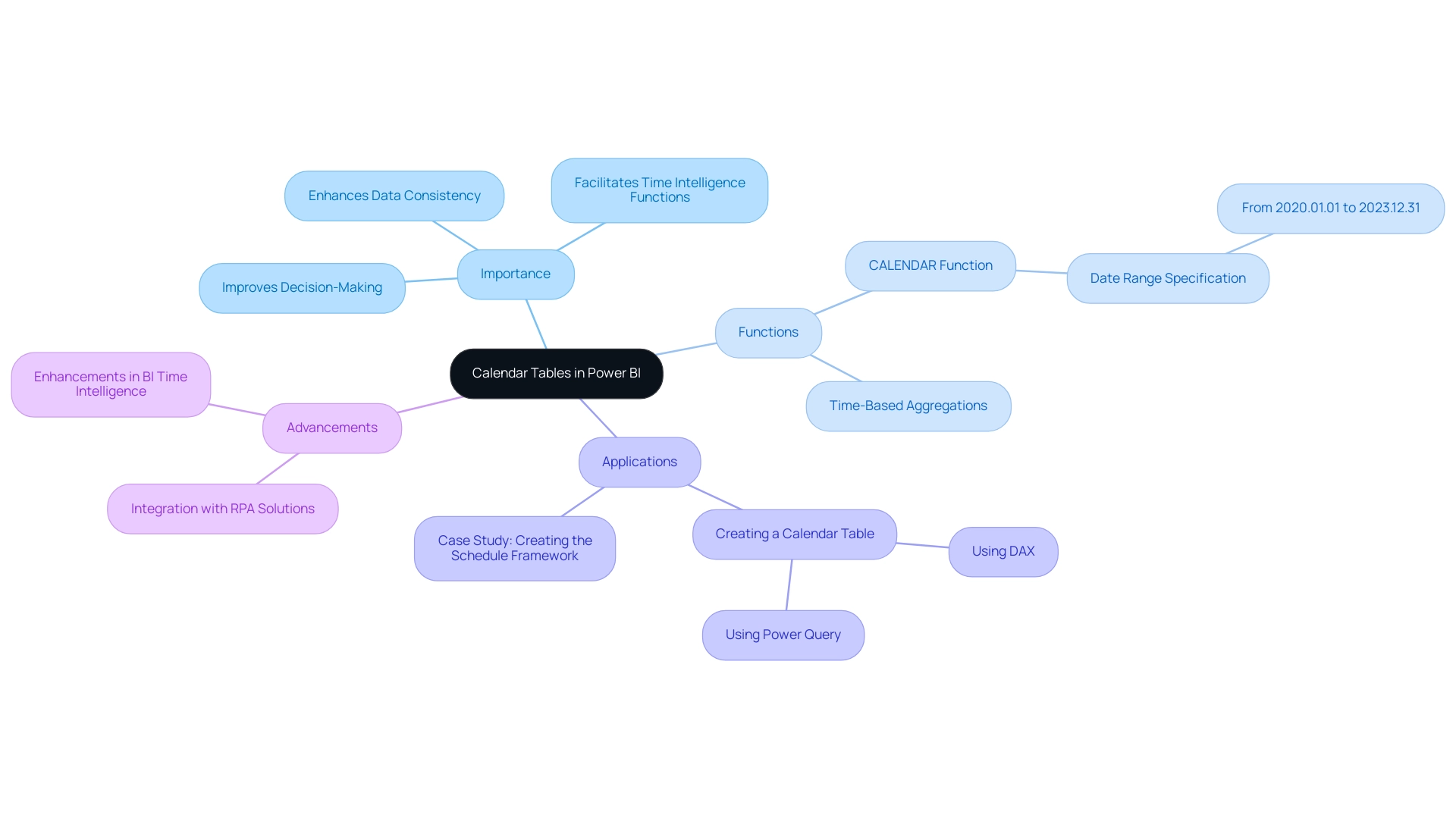
Methods for Creating a Calendar Table: Power Query vs. DAX
Creating a calendar table in Power BI can be accomplished through two primary methods: Query and DAX (Data Analysis Expressions). While Query offers a visual and intuitive method for transformation and preparation, it may become time-consuming for users who find themselves building reports instead of utilizing insights efficiently. For those who prefer coding, DAX offers greater flexibility, although it requires a shift in thinking, especially for users accustomed to linear programming.
As highlighted by Reza Rad, the author of over 14 books on Microsoft Business Intelligence, achieving complex tasks, such as generating ISO week numbers, can be challenging in Power Query:
if you want to achieve something like that in Power Query, that needs some work and is not as simple and straightforward as calendarauto.
This complexity highlights the potential for inconsistencies and the critical need for a robust governance strategy to maintain trust in the information presented. Without such a strategy, stakeholders may encounter confusion and mistrust regarding the integrity of the information.
By understanding the strengths of each method and implementing a governance framework, users can select the most suitable approach tailored to their project requirements and skill sets. Moreover, practical advice, such as setting clear information definitions and uniform reporting standards, can assist in ensuring efficient schedule design in BI while steering clear of challenges linked to report development.
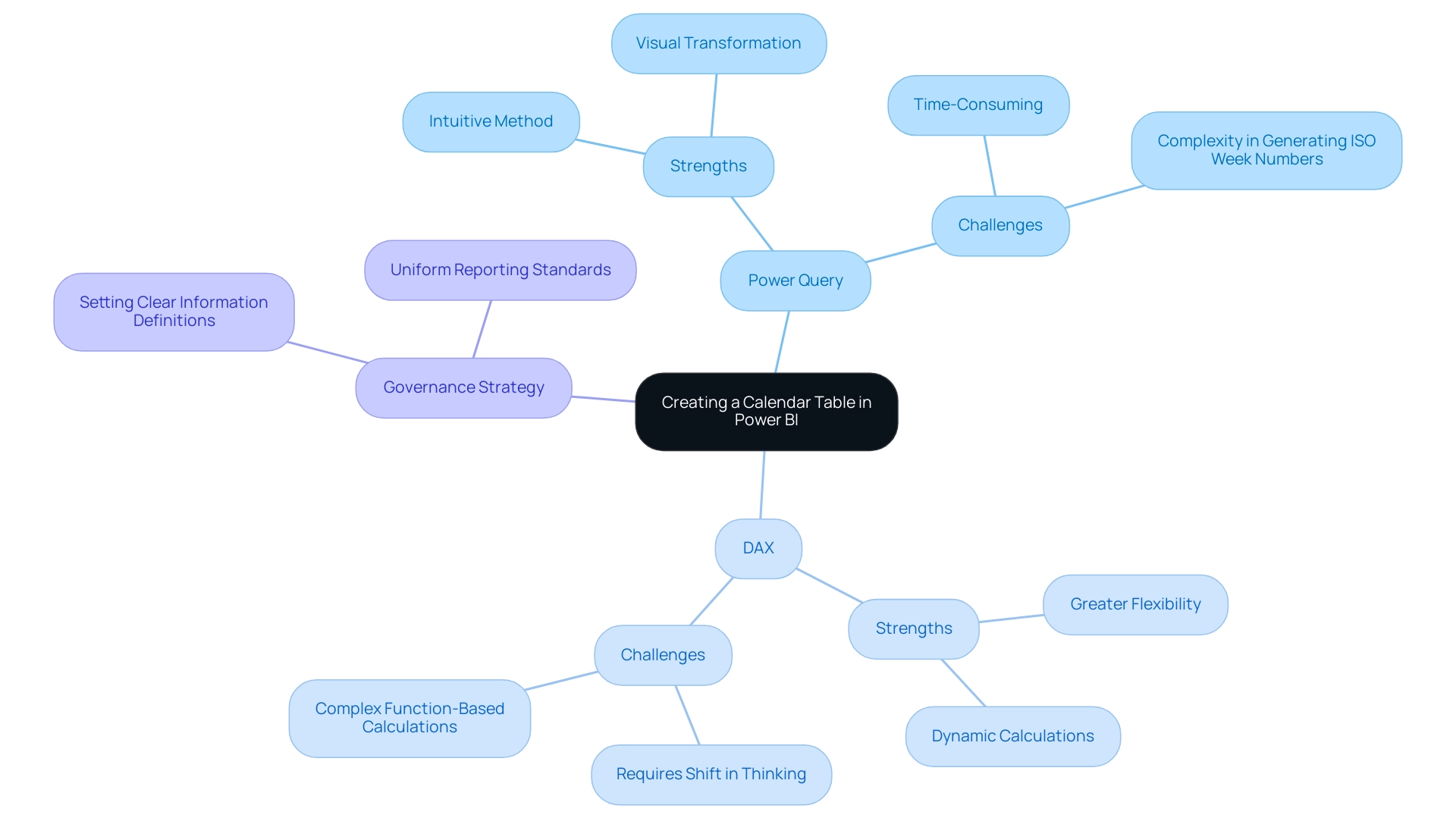
Step-by-Step Guide to Creating a Calendar Table with Power Query
Developing a schedule structure in BI through Query is a simple procedure that can greatly improve your data examination abilities and promote operational effectiveness. Follow these steps to set up your calendar table effectively:
- Launch BI Desktop and go to the ‘Home’ tab.
- Click on ‘Transform Data’ to enter the Query Editor.
- Within the Power Query Editor, select ‘Home’ > ‘New Source’ > ‘Blank Query’.
- In the formula bar, input the following formula to generate a list of dates:
= List.Dates(#date(2025, 1, 1), 1826, #duration(1, 0, 0, 0))
(This code generates a calendar for the next five years starting January 1, 2025, so feel free to adjust the start date and duration as needed.)
- Transform the list into a grid by selecting ‘Home’ > ‘To Grid’.
- Rename the resulting column to ‘Date’.
- Enhance your data set by adding extra columns for Year, Month, Quarter, etc., using the ‘Add Column’ tab along with the relevant date functions.
- After completing your schedule grid, click ‘Close & Apply’ to load it into Power BI.
By adhering to these steps, you can simplify your analysis and resolve common problems such as time-consuming report generation and inconsistencies in information by creating a calendar table in Power BI. It is crucial to standardize all dates to a single time zone, such as UTC, before creating your date arrangement, especially if your dataset involves multiple time zones. This practice ensures consistency in your analysis and reporting.
As Kafaru Simileoluwa, a Data Scientist at Aella App, emphasizes, “Auto Date/Time is limited because it creates hidden tables that are not easily customizable and can lead to performance issues in large datasets.” Thus, creating a calendar table in Power BI for calendar creation enables improved customization and efficiency in your modeling, ultimately empowering your business to unlock actionable insights and promote informed decision-making. Moreover, integrating RPA can automate repetitive tasks associated with information management in BI, further improving operational efficiency.
Instruments such as Automate can enhance this process by optimizing workflows, ensuring that your information management tasks are efficient and effective.
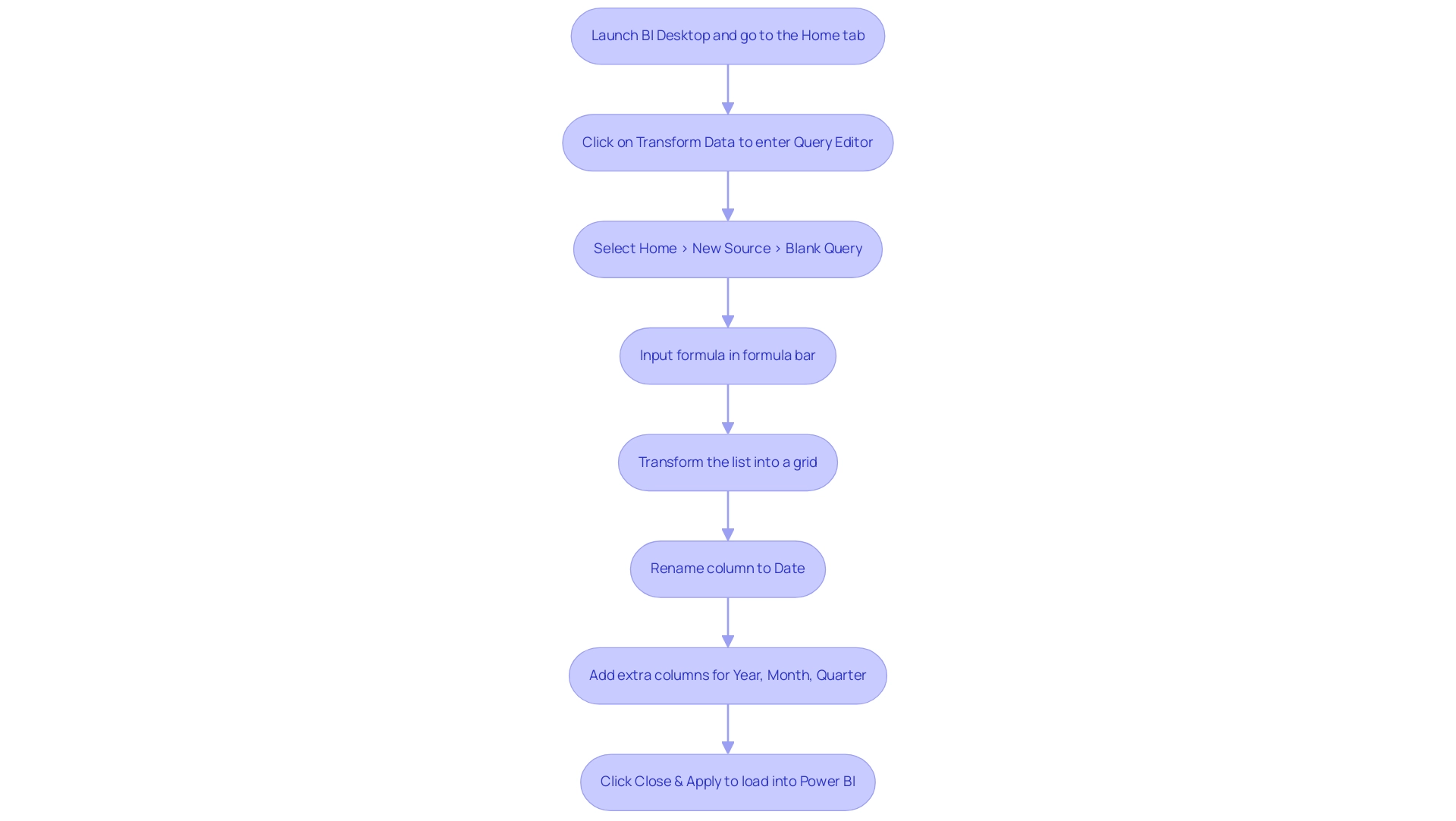
Creating a Calendar Table Using DAX: A Comprehensive Approach
Creating calendar table in Power BI as part of developing a schedule structure in BI with DAX is a simple task that greatly improves your reporting abilities, particularly in addressing frequent issues such as lengthy report generation and data discrepancies. Here’s how to do it:
- Open Power BI Desktop and switch to the ‘Data’ view.
- Navigate to the ‘Modeling’ tab in the ribbon and select ‘New Table’.
- In the formula bar, input the following DAX expression:
Calendar = CALENDAR(DATE(2020, 1, 1), DATE(2021, 12, 31)) (Feel free to adjust the start and end dates according to your needs.)
-
This formula creates a fundamental schedule layout. To enhance your setup, utilize DAX functions such as YEAR(), MONTH(), and QUARTER() to extract essential date components.
-
You can also create calculated columns to reflect fiscal years or custom date formats based on your organization’s requirements.
Once your schedule framework is established, it will be prepared for incorporation into your reports and visualizations.
Utilizing DAX for date structure creation permits dynamic functionality, allowing your framework to adjust to filters and slicers within Power BI. This not only boosts the interactivity of your reports but also provides a more comprehensive view of the data. As Jay Wang aptly observes,
Use IF() function to create working day function schedule, adding further flexibility in date management.
It is vital to frequently refresh your schedule grid to include new date ranges, holidays, or fiscal changes, ensuring your reports stay pertinent and precise. Additionally, implementing a governance strategy can help mitigate inconsistencies, fostering trust in the information presented. Given that our blog currently has 5 subscribers, it’s essential for us to provide valuable and up-to-date content to enhance our audience’s engagement.
A practical example of this is found in the case study titled “Creating Schedule Structures with CALENDAR DAX Function,” which demonstrates creating calendar table in Power BI by showing how the CALENDAR DAX function enables users to define specific start and end dates for their schedule structures, providing precise control over the date range. This method enables the addition of various date components, facilitating effective filtering and grouping in reports, thus driving data-driven insights and operational efficiency.
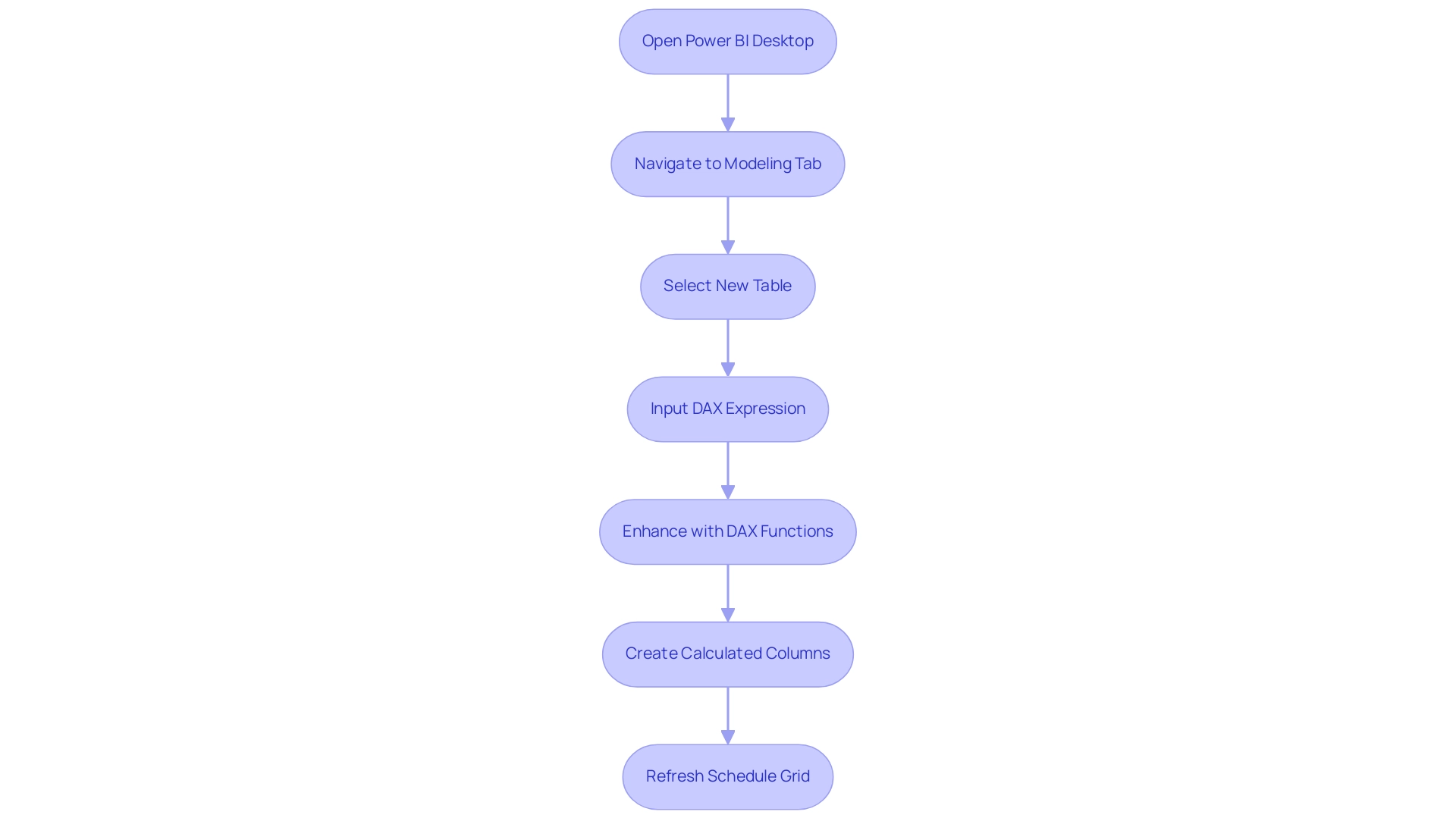
Best Practices for Managing and Optimizing Calendar Tables in Power BI
To effectively manage and optimize calendar tables in Power BI and overcome common challenges such as time-consuming report creation, data inconsistencies, and lack of actionable guidance, consider implementing the following best practices:
- Keep it Simple: Streamline your schedule layout by including only essential columns. This approach enhances both performance and usability, making it easier to navigate and minimizing confusion in reporting.
- Use Appropriate Data Types: Ensure that date columns are formatted correctly as date types. This is crucial for leveraging Power BI’s time intelligence functions effectively, which can reduce errors and improve trust in your data.
- Regular Updates: Consistently refresh your schedule to reflect changes in reporting periods, such as fiscal years or new date ranges. This ensures that your analyses remain relevant and accurate, addressing the issue of outdated information.
- Avoid Duplicates: Be watchful in ensuring that your schedule is free from duplicate dates. Duplicates can lead to inaccuracies in calculations and reporting, undermining integrity and creating mistrust among stakeholders.
- Utilize Connections: Create links between your schedule framework and other pertinent structures in your model to enable thorough time-oriented analysis. This interconnectedness enhances the analytical capabilities of your reports, providing clearer guidance for decision-making.
- Implement a Governance Strategy: Develop a governance strategy for your timetable tables to ensure consistency and accuracy across reports. This strategy can help mitigate data inconsistencies and foster trust in the insights derived from your data.
As Stephen Tao, Community Support, notes, “Hi @Anonymous, what expected results do you want to display? Currently, I can only suggest that you consult this article to make a schedule. Best Regards, Stephen Tao.
If this post helps, then please consider accepting it as the solution to help the other members find it more quickly.” This perspective emphasizes the significance of clarity in schedule management.
Additionally, consider using the ADDCOLUMNS function to enhance your analysis capabilities while creating calendar tables in Power BI. For instance, utilizing the WEEKNUM function for grouping yearly sales data not only improves readability but also assists in identifying sales trends, making it easier to correlate drops in sales with specific dates. This kind of optimization leads to better decision-making and reporting outcomes.
Lastly, don’t miss out on the opportunity to engage with the Power BI community; use the discount code MSCUST for a $150 discount on conference registration before the early bird discount ends on December 31.
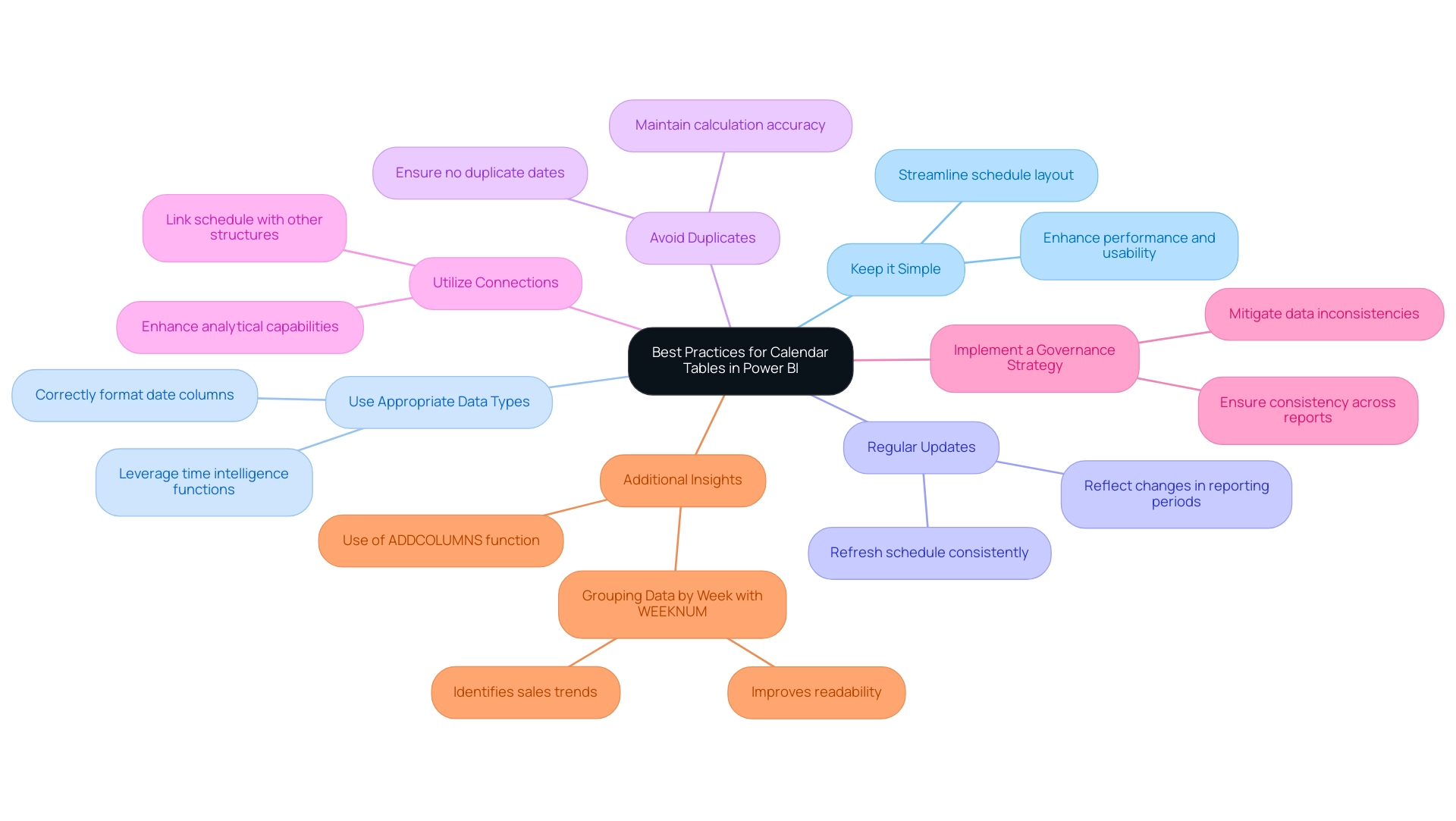
Conclusion
Utilizing calendar tables in Power BI is not just a technical requirement; it is a strategic advantage that propels organizations toward operational excellence. By implementing robust calendar tables, users can unlock powerful time intelligence functions that facilitate insightful reporting, year-over-year comparisons, and accurate data analyses. Whether through Power Query or DAX, the methods for creating these tables are crucial for overcoming common challenges such as data inconsistencies and lengthy report creation processes.
Adopting best practices in managing and optimizing calendar tables ensures that the data remains relevant, accurate, and trustworthy. Regular updates, careful formatting, and strategic relationships between tables enhance the overall analytical capabilities of Power BI, empowering directors of operations to make informed decisions based on reliable insights. The integration of automation tools like RPA further streamlines workflows, allowing teams to focus on deriving value from data rather than getting bogged down by repetitive tasks.
In an increasingly data-driven landscape, mastering calendar tables is essential for any organization that aims to harness the full potential of its data. By prioritizing effective calendar management, organizations can not only enhance their reporting capabilities but also foster a culture of data-driven decision-making that drives operational success.
Discover how our RPA solutions can transform your data processes—contact us today to learn more!
Introduction
In the dynamic landscape of data analysis, the COUNTAX function in Power BI emerges as a vital tool for organizations striving to derive meaningful insights from their datasets. By enabling users to count non-blank values through defined expressions, COUNTAX empowers analysts to filter out irrelevant data and focus on what truly matters.
As businesses grapple with challenges like data inconsistencies and the inefficiencies of manual reporting, mastering COUNTAX can streamline processes and enhance decision-making capabilities.
This article delves into:
- Practical applications
- Advanced techniques
- Best practices for implementing COUNTAX
Equipping users with the knowledge to harness its full potential and drive operational efficiency in their data-driven initiatives.
Understanding the COUNTAX Function in Power BI
The function in Power BI is an essential tool designed to count non-blank values in a specified column through a defined expression. Its syntax is straightforward: COUNT(<table>, <expression>), where <table> represents the dataset being examined, and <expression> indicates which values to count. For instance, if you want to quantify the number of sales transactions with non-blank entries in the ‘Sales Amount’ column, leveraging COUNTAX allows you to filter and count only those relevant transactions.
This capability is crucial for delivering precise representations of your insights, addressing challenges such as time-consuming report creation that often detracts from actionable analysis. However, many organizations face issues like inconsistencies across reports and a lack of a governance strategy, which can lead to confusion and mistrust in the information presented. Additionally, reports may be filled with numbers and graphs yet miss clear, actionable guidance, leaving stakeholders without a clear direction on the next steps.
Related functions such as COUNT, COUNTA, and COUNTX provide further context to the capabilities of another counting function. As noted by expert Marco Russo, ‘In this case, COUNTX reads better than CALCULATE,’ underscoring the importance of selecting the right function for specific scenarios. Mastering the function is essential for anyone aiming to maximize Power BI’s capability for information examination, enabling users to derive nuanced insights from their datasets.
Recent updates suggest that the system can function on Boolean types, enhancing its versatility in the field of information evaluation. Additionally, the HASONEVALUE function, which verifies if a specified column yields solely one value, demonstrates the practical uses of comparable functions in information evaluation and assists in differentiating between single and multiple entity outputs, thereby enhancing operational efficiency and business intelligence. Incorporating RPA solutions can further streamline these processes, reducing the burden of report creation and enhancing overall operational effectiveness.

Practical COUNTAX Examples for Effective Data Analysis
-
Counting Non-Blank Sales Amounts: To accurately assess your sales performance, consider counting the number of transactions with valid amounts in your sales table. Apply the formula:
SUMX(SalesTable, SalesTable[Sales Amount]). This approach will return the total count of sales transactions, excluding any blanks, allowing for a precise evaluation of your sales activity. Efficient data evaluation, such as using specific functions, is essential since companies utilizing marketing automation to cultivate prospects see a 451% rise in qualified leads. By automating this process with Robotic Process Automation (RPA), you can enhance efficiency, reduce errors, and free up your team for more strategic tasks. -
Analyzing Customer Engagement: Understanding customer engagement is crucial for retention strategies. To gauge how many customers made purchases within a specific timeframe, implement the measure:
COUNT(CustomersTable, CustomersTable[Last Purchase Date]). This calculation highlights active customers, enabling targeted engagement efforts. As 51% of email marketers assert, email list segmentation is the most effective way to personalize lead nurturing, underscoring the importance of targeted strategies in enhancing customer engagement. RPA can streamline this evaluation, providing quicker insights and enhancing customer interactions while alleviating the burden of manual tracking. -
Evaluating Product Performance: Identifying which products are performing well is essential for inventory management. Create a measure to count non-blank entries in the ‘Product ID’ column using countax powerbi:
COUNTAX(SalesTable, SalesTable[Product ID]). This examination aids you in identifying top-selling products and making informed stock decisions. RPA facilitates the automation of these evaluations, ensuring timely data retrieval and analysis, thus reducing the risk of errors associated with manual processes. -
Tracking Project Milestones: For project managers, monitoring task completion is vital. By using the countax powerbi function with the following formula:
COUNTAX(TasksTable, TasksTable[Completion Date]), you can effectively count the number of completed tasks. This measure provides visibility into project progress, ensuring timely delivery and effective resource allocation. Automating this tracking with RPA can enhance accountability and streamline project management processes, mitigating the challenges posed by manual oversight. -
Monitoring Marketing Campaigns: Evaluating marketing campaign effectiveness is key to refining strategies. To tally responses from your campaigns, use a function like this:
Function(Campaign Table, Campaign Table[Response]). This measure will provide you with understanding of campaign success rates, empowering you to make data-driven adjustments to your marketing initiatives. Additionally, in larger companies ($250M–$1B), a significant percentage of respondents expect SDRs to generate a substantial portion of the sales pipeline; thus, utilizing this solution can be instrumental in meeting these ambitious goals. Implementing RPA in overseeing these campaigns can significantly lessen manual effort and improve real-time information evaluation, tackling the shortcomings of conventional methods.
These practical examples highlight the versatility of the function in confronting various information evaluation challenges, providing users with the tools necessary to obtain actionable insights from their information while utilizing RPA for enhanced operational efficiency and aligning with customized AI solutions in a changing environment.
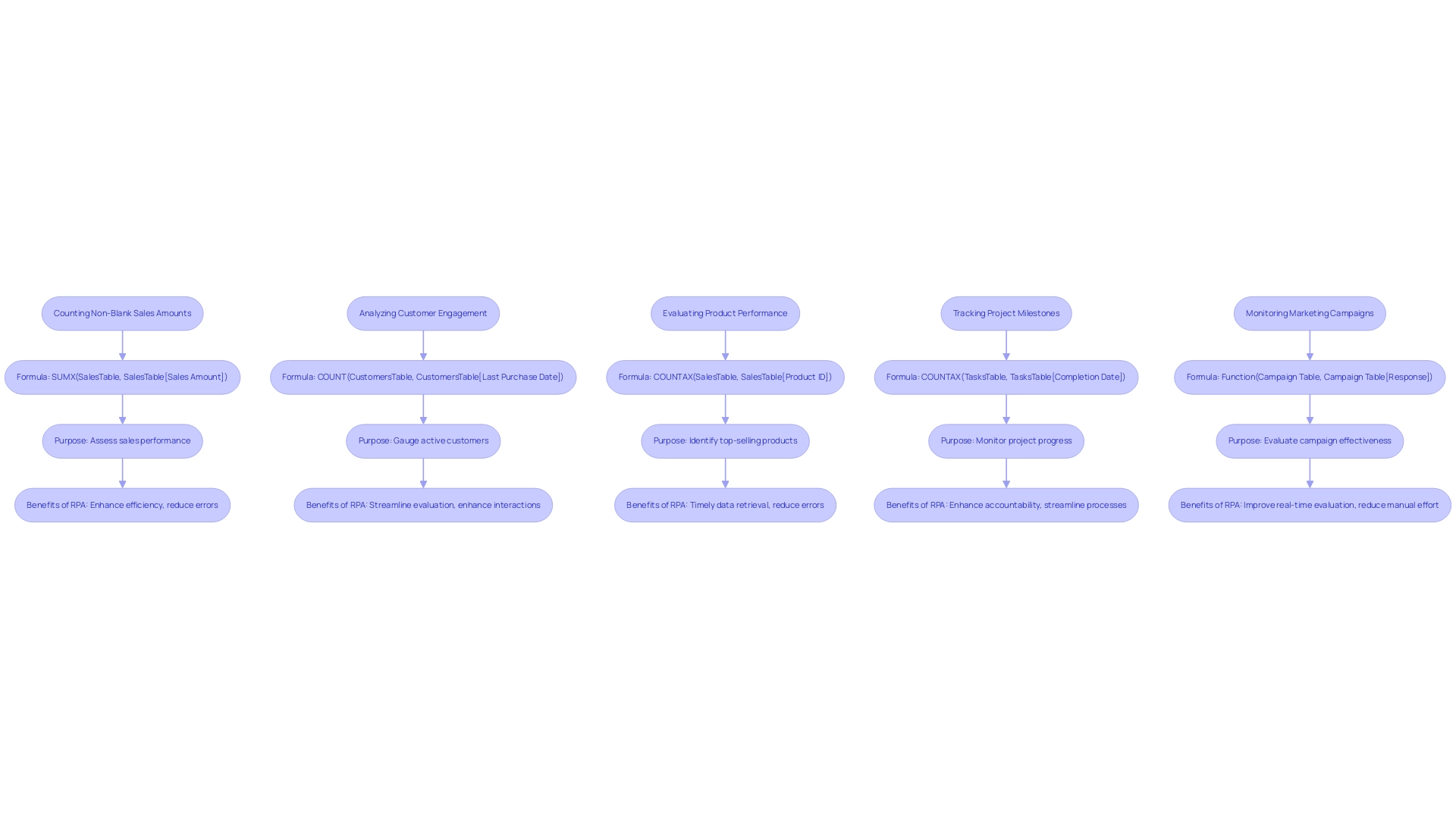
Advanced COUNTAX Techniques for Enhanced Insights
-
Utilizing the counting function with FILTER: Enhance your data analysis by combining the counting function with the FILTER function. For instance, using
COUNTAX(FILTER(SalesTable, SalesTable[Region] = 'West'), SalesTable[Sales Amount])in Countax PowerBI counts only the sales amounts from the ‘West’ region. This targeted approach allows for precise insights tailored to specific conditions, crucial in today’s data-driven environment. By leveraging Robotic Process Automation (RPA), organizations can streamline these manual processes, ultimately boosting operational efficiency and freeing up resources for strategic analysis. RPA not only lowers errors but also improves the precision of information handling. Moreover, as 93% of organizations report that Zero Trust benefits have met or exceeded expectations, ensuring secure data handling is essential in this process. -
Dynamic Counting through Variables: Utilizing variables can significantly elevate your counting measures. For example,
VAR TotalSales = COUNTAX(SalesTable, SalesTable[Sales Amount]) RETURN TotalSalessimplifies complex calculations by storing intermediary results. This technique not only streamlines your analysis but also enhances clarity in your reporting. In the realm of cybersecurity, utilizing such measures can assist organizations in reducing risks linked to data breaches, thereby emphasizing the significance of incorporating Business Intelligence for practical information. Tailored AI solutions can assist in navigating the overwhelming options in the AI landscape, ensuring businesses select the right tools for their needs. -
COUNTAX in Time Intelligence: Integrating the software with time intelligence functions unlocks insights over defined periods. An example of COUNTAX in PowerBI is the formula
COUNTAX(DATEADD(SalesTable[Date], -1, MONTH), SalesTable[Sales Amount]), which counts the sales from the previous month. This capability aids in identifying trends and seasonality, essential for strategic planning. Comprehending these trends is crucial, particularly in light of the increase in spear-phishing groups, which expanded from 116 in 2016 to over 250 in 2018, emphasizing the necessity for strong analysis in cybersecurity and the role of BI in facilitating informed decision-making. RPA can help automate the collection of this data, reducing the time spent on manual data entry. -
Combining a specific counting function with CALCULATE: Employing this counting method within a CALCULATE function allows for advanced filtering options. For instance,
CALCULATE(COUNTAX(SalesTable, SalesTable[Sales Amount]), SalesTable[Product Category] = 'Electronics')demonstrates the use of COUNTAX in PowerBI to focus on sales within a specific category. This method provides targeted insights, enabling better decision-making aligned with organizational goals. It’s vital to recognize that following events such as the Target Data Breach, which affected the information of around 110 million customers, such focused examination becomes even more crucial in navigating the vast AI landscape and ensuring information security. RPA can streamline the analysis process, allowing teams to concentrate on interpreting results rather than manual information handling. -
Visualizing COUNTAX Results: Finally, translating COUNTAX results into visual formats enhances comprehension. For instance, a bar chart illustrating the count of non-blank sales amounts by region can reveal trends for stakeholders. This visual representation not only makes the information more accessible but also facilitates informed discussions and strategies moving forward. By incorporating security-focused insights and leveraging RPA, organizations can foster a culture of security awareness, further protecting themselves against cyber threats while driving growth and innovation. Tailored AI solutions can help ensure that the appropriate information is visualized, enhancing decision-making capabilities.

Common Mistakes to Avoid When Using COUNTAX
-
Neglecting Types: A frequent oversight when using COUNTAX is failing to consider types. It’s essential to ensure that the expression is counting compatible types; otherwise, unexpected results may arise. For instance, counting text values in a numeric context can lead to inaccuracies in your analysis. Transparency in reporting these results is crucial to maintain the integrity of your findings in the realm of Business Intelligence (BI). By utilizing BI efficiently, you can evade such traps and improve the quality of information obtained from your resources. Ignoring these issues can result in a lack of data-driven understanding, placing your business at a competitive disadvantage.
-
Ignoring Context: Context is essential in information evaluation. Ignoring the context of your dataset can lead to misinterpretations and misguided conclusions. Always analyze the data in its appropriate context to ensure that the function provides meaningful insights that align with your operational goals. Employing RPA, like EMMA RPA and Power Automate, can simplify this process, decreasing the time spent on repetitive tasks and enabling more thorough examination.
-
Overlooking Blank Values: Another common mistake is forgetting that COUNTAX only counts non-blank values. Blank entries in your dataset can distort your results, so it’s vital to address these gaps to maintain the integrity of your analysis. This is especially important when creating reports in Power BI, where inconsistencies can hinder decision-making and contribute to a lack of actionable insights.
-
Failing to Test Formulas: As PF states, “PF accepts full responsibility for the work and the conduct of the study and controls the decision to publish.” Before completing your measures, it’s essential to test your formulas with example information. This step is crucial for confirming that your calculations perform as expected and helps identify potential errors early in the process, saving you time and resources. Automating testing processes with RPA can significantly improve efficiency and ensure that you are making data-driven decisions.
-
Insufficient Documentation: Lastly, not documenting your COUNTAX measures can result in confusion down the line. Clear documentation of your formulas not only aids in future modifications but also enhances collaboration with team members by ensuring that everyone understands the logic behind your calculations. A relevant case study titled “Analyzing Interaction Effects” demonstrates how researchers often compare p-values across different subsets of information, which can be misleading in the context of COUNTAX Power BI. This emphasizes the significance of comprehensive documentation and clarity in your analysis processes, ultimately fostering improved insights through BI and reducing the risks linked to a lack of evidence-based insights.
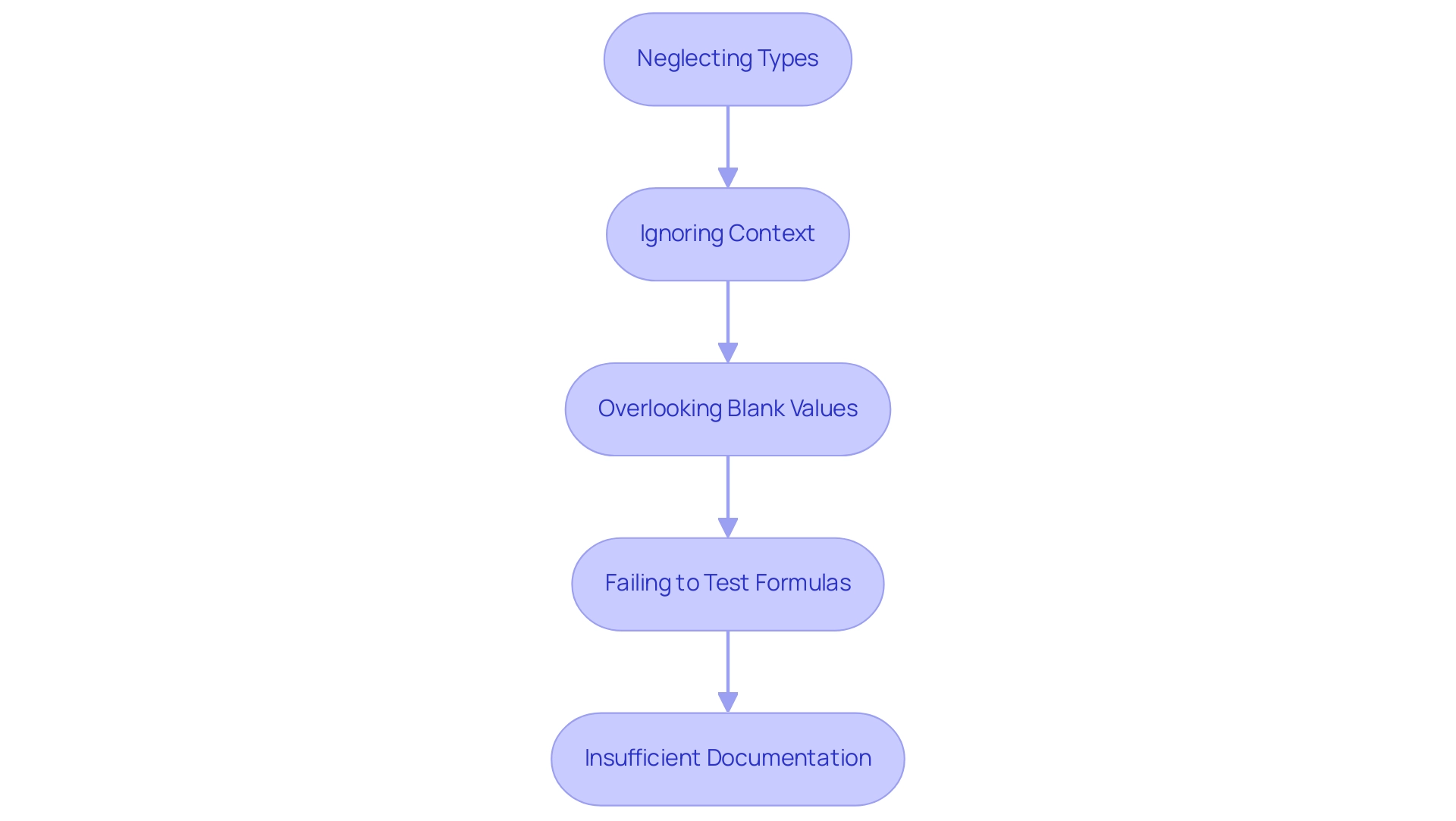
Best Practices for Implementing COUNTAX in Power BI
-
Understand Your Information: Gaining a thorough comprehension of your information is crucial before diving into this function. Familiarity with the structure and contents empowers you to craft effective expressions in COUNTAX PowerBI tailored to your specific needs. As the landscape of information evolves, unlocking the power of Business Intelligence can help you extract meaningful insights, ensuring your strategies are informed and driven by facts. Recognizing biases in qualitative research is essential, as highlighted by the infographic on biases that has garnered 1.6k views, underscoring the importance of accurate data interpretation in driving business growth.
-
Keep Formulas Simple: Embrace simplicity when designing your measures. Overly complex formulas can lead to confusion and errors; therefore, breaking down calculations into smaller, manageable components is a wise strategy. As Adrian Schneider states, “It’s also common to throw view counts into a secondary table, and then update the actual counts nightly (or at some interval). This should be a little faster than X = X + 1, but requires a bit more work.” This approach not only enhances clarity but also reduces the likelihood of mistakes, reinforcing the efficiency that RPA, particularly tools like EMMA RPA and Power Automate, can bring to your reporting processes.
-
Use Descriptive Names: Assign descriptive names to your measures that reflect their purpose clearly. This practice boosts clarity and aids in communication, ensuring that both you and your colleagues can easily navigate through the measures you’ve created. Clear naming conventions can also assist in automating workflows, simplifying the integration of information across teams.
-
Make it a habit to regularly review and optimize your countax powerbi measures to confirm that they are still relevant. As your information evolves, so too should your measures, ensuring they continue to provide accurate insights. Examine the case study on modeling defect rates with a larger sample size, which demonstrates the importance of adjusting statistical models to reflect new information accurately, thus enhancing operational efficiency in your reporting.
-
Leverage Community Resources: Tap into the wealth of knowledge within the Power BI community. Engaging with forums, blogs, and tutorials allows you to learn from the experiences of others, making it easier to enhance your proficiency with Countax PowerBI. This collaborative approach fosters continuous improvement and innovation in your data analysis practices, specifically addressing challenges such as data inconsistencies and time-consuming report creation by providing practical solutions and shared insights.
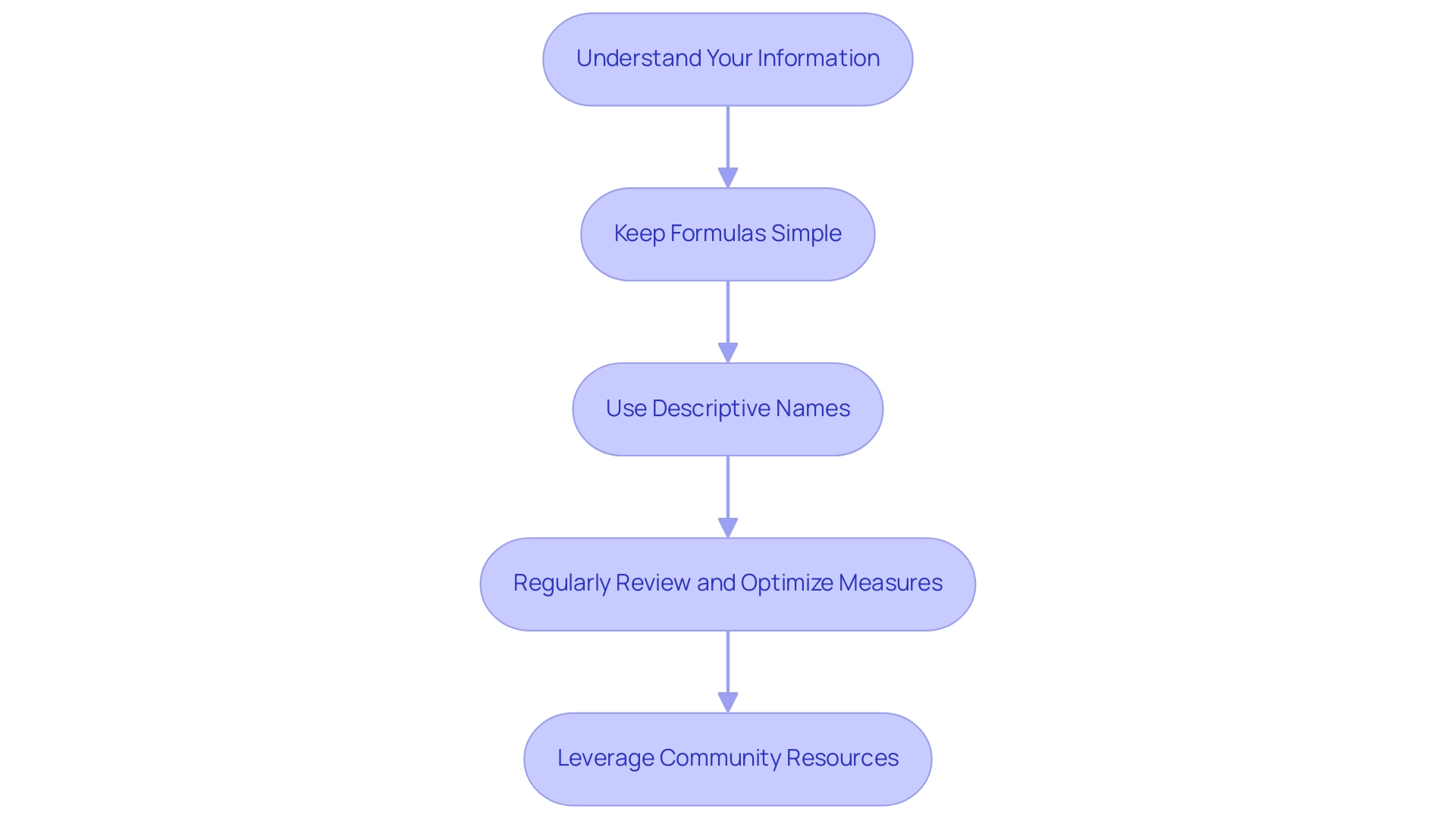
Conclusion
Harnessing the COUNTAX function in Power BI is a game-changer for organizations aiming to optimize their data analysis efforts. By implementing COUNTAX, users can efficiently count non-blank values, ensuring that only relevant data informs decision-making processes. The practical applications outlined—from tracking sales performance to evaluating marketing campaigns—demonstrate how COUNTAX can provide precise insights that drive operational efficiency.
Advanced techniques, such as integrating COUNTAX with FILTER or CALCULATE, further enhance the function’s capabilities, allowing for targeted analysis that aligns with specific business goals. However, it is crucial to avoid common pitfalls, such as neglecting data types or overlooking blank values, which can compromise the integrity of insights. Adopting best practices, including maintaining simplicity in formulas and leveraging community resources, empowers users to maximize the potential of COUNTAX.
In conclusion, mastering the COUNTAX function not only streamlines reporting processes but also cultivates a data-driven culture within organizations. By embracing these strategies and insights, businesses can transform their approach to data analysis, leading to more informed decisions and a competitive edge in the marketplace. Now is the time to elevate data analysis practices and unlock the full potential of Power BI.
Introduction
In the rapidly evolving landscape of data analytics, Power BI stands out as a powerful tool that enables organizations to harness the full potential of their data. Among its many features, the cross-report drill through capability emerges as a game-changer, allowing users to navigate seamlessly between related reports and derive deeper insights. This functionality not only addresses the challenge of data fragmentation but also enhances the overall user experience by fostering a more interconnected understanding of business metrics.
As organizations strive to make informed decisions, leveraging this feature can significantly elevate their data storytelling and operational efficiency. By integrating best practices and troubleshooting strategies, businesses can maximize the impact of their Power BI reports, ensuring they remain agile and responsive in a data-driven world.
Understanding Cross-Report Drill Through in Power BI
The cross report drill through Power BI feature represents a significant advancement in navigating the overwhelming AI landscape, which can often leave organizations struggling to identify the right solutions for their specific needs. This feature enables individuals to transition smoothly between related documents that possess shared information fields, tackling the issue of information fragmentation. By cultivating deeper insights and contextual comprehension of the information available, it improves the experience of the individual.
For instance, when examining sales performance in one report, users can effortlessly navigate to another report that offers detailed customer demographics and behaviors. This interconnectedness enables a more comprehensive perspective of the landscape, facilitating informed decision-making aligned with business objectives. Organizations like Geico have harnessed Business Intelligence to enhance recruitment efficiency by 15%, showcasing the tangible benefits of data-driven decision-making.
Moreover, the Salesforce and Tableau merger illustrates the importance of integrating analytical tools to enhance BI solutions, paralleling the benefits of the cross report drill through feature in Power BI. Effectively utilizing this feature is crucial for maximizing Power BI’s potential in storytelling, enabling organizations to craft compelling narratives that drive impactful business decisions. As lbendlin, a super participant, aptly puts it,
What you actually want to measure is its impact on business decision making,
signifying that the true value of these features lies in their ability to convert information into actionable insights.
Frequently reassessing objectives and targets is crucial as user behaviors evolve over time, ensuring that strategies remain aligned with organizational goals. By leveraging customized AI solutions, organizations can cut through the noise of the AI landscape, ensuring that their information strategies are not only effective but also strategically aligned with their operational efficiency goals.
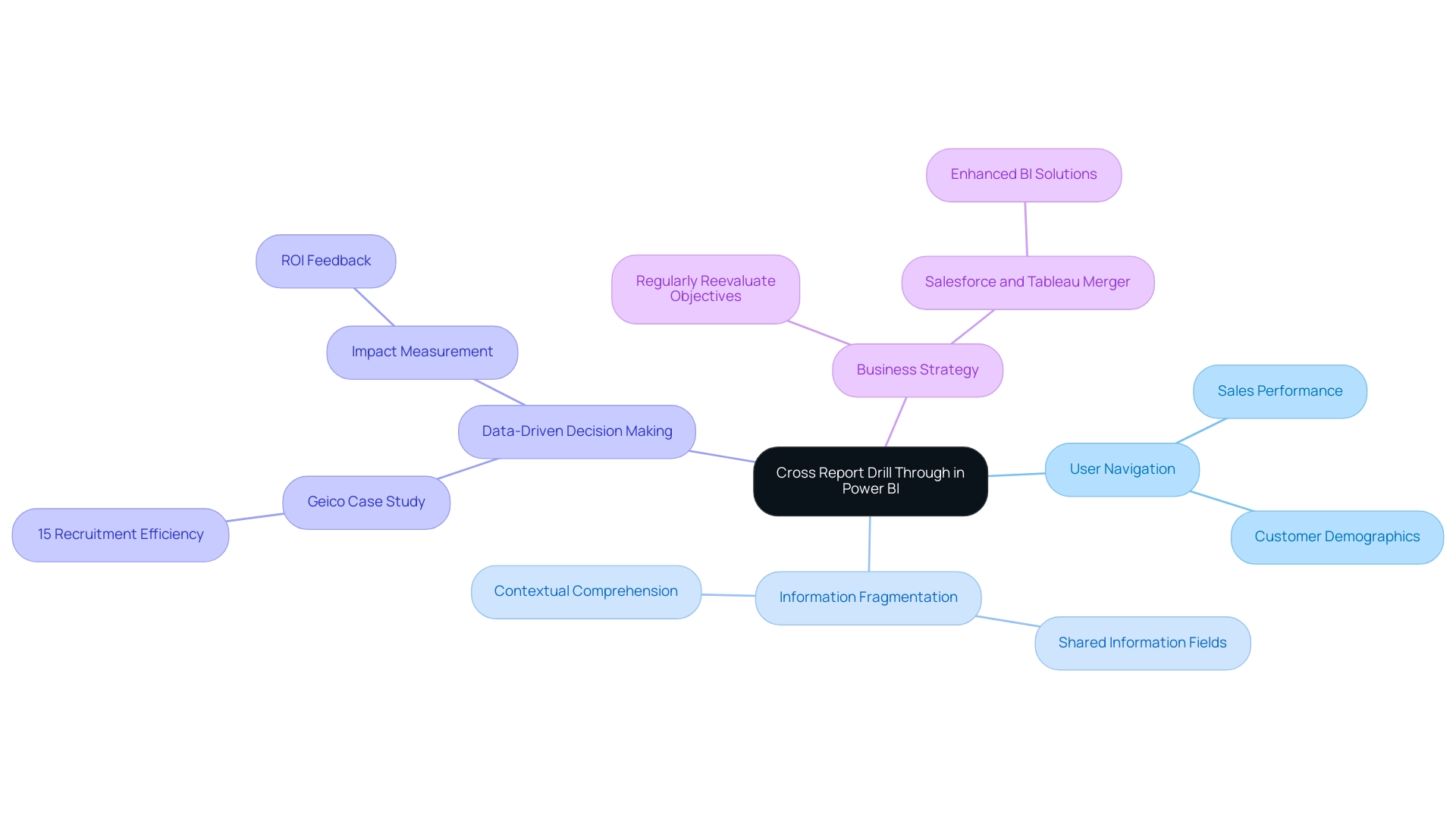
Enabling Cross-Report Drill Through: Step-by-Step Instructions
Enabling cross report drill through Power BI can significantly enhance the interactivity and informativeness of your analysis, making the most of Business Intelligence capabilities. Additionally, incorporating Robotic Process Automation (RPA) can streamline information handling, further improving operational efficiency. Here’s a structured approach to help you implement this feature effectively:
- Open your Power BI document: Begin by launching Power BI Desktop and accessing the file you wish to enhance.
- Navigate to the Model view: Click on the ‘Model’ icon located in the left sidebar to access your information model.
- Choose the fields for exploration: Identify the common information points across your reports that will serve as the foundation for exploration functionality. These fields are crucial for a seamless user experience, particularly in overcoming challenges such as inconsistencies.
- Set up a detailed view: Right-click on the chosen field and select ‘Drill through’ -> ‘Add detailed view’ to create a new page tailored to your selected information points.
- Configure the drill through page: Design this new page by incorporating relevant visuals and information fields that provide context for deeper analysis. Consider utilizing summary statistics such as Minimum, Median, 1st Quartile, Mean, 3rd Quartile, and Maximum to assist individuals in comprehending information distribution and identifying potential outliers.
The advantages of summary statistics include the ability to easily identify missing information through counts and understand how your collection is spread out and distributed. This understanding can be crucial in educating individuals about the subtleties within the information. Additionally, an alternative to visualize quartiles is to plot them in a Column chart to simulate a Boxplot, which can further aid in the interpretation of the data.
6. Release the document: Save your changes and release the document to the Power BI service, ensuring that the modifications are accessible to your audience.
By following these steps, you can successfully enable cross-document navigation with a cross report drill through Power BI, elevating the interactivity and depth of your materials while aligning with best practices for audience engagement. This approach not only enhances your reporting capabilities but also positions your organization to leverage the power of Business Intelligence and RPA for informed decision-making and operational efficiency. Implementing these features is crucial to avoid the competitive disadvantage of failing to extract actionable insights from your data.

Setting Up Cross-Report Drill Through in Power BI Desktop and Service
To efficiently establish cross-report exploration in both Power BI Desktop and Power BI Service, it is essential to utilize Business Intelligence and RPA strategies, especially taking into account the daily updates of usage metrics reports to track engagement effectively:
In Power BI Desktop:
-
Create a Detailed Navigation Page:
Begin by enabling the thorough feature. Construct a dedicated page designed specifically for drill through, incorporating visuals that present detailed information relevant to inquiries. This proactive approach helps address challenges in report creation and ensures clarity in information representation.
Add Drill Through Filters:
Incorporate the necessary fields into the ‘Drill through’ section of the filters pane. This step is essential for creating the context that individuals will require when moving through the information. Remember to remove any default filters to view all workspace usage metrics, optimizing the drill through setup and reducing data inconsistencies. -
Verify Drill Through Functionality:
Confirm that the exploration options are operational by conducting tests with real participants, ensuring functionality aligns with their expectations. This step is essential in overcoming the challenges of actionable guidance in information reporting.
Monitor Engagement:
Leverage Power BI’s built-in analytics tools to observe how individuals engage with the drill through feature. This information is invaluable for making adjustments and enhancing the experience. Additionally, consider the implications of Power BI operating in separate national/regional clouds, ensuring compliance with local regulations regarding privacy. Highlighting the integration of RPA solutions can further improve operational efficiency by automating repetitive tasks associated with report generation and data processing. -
Design the Page:
Tailor the layout and visuals of the page to promote clarity and ensure that the information is relevant for the audience. A well-designed page can significantly enhance engagement and satisfaction.
Access the Report:
Navigate to the published report within the Power BI Service environment.
By adhering to these steps in both environments, you will create a seamless and effective setup for cross report drill through Power BI, which enhances overall data interaction and user satisfaction while promoting business growth through informed decision-making.
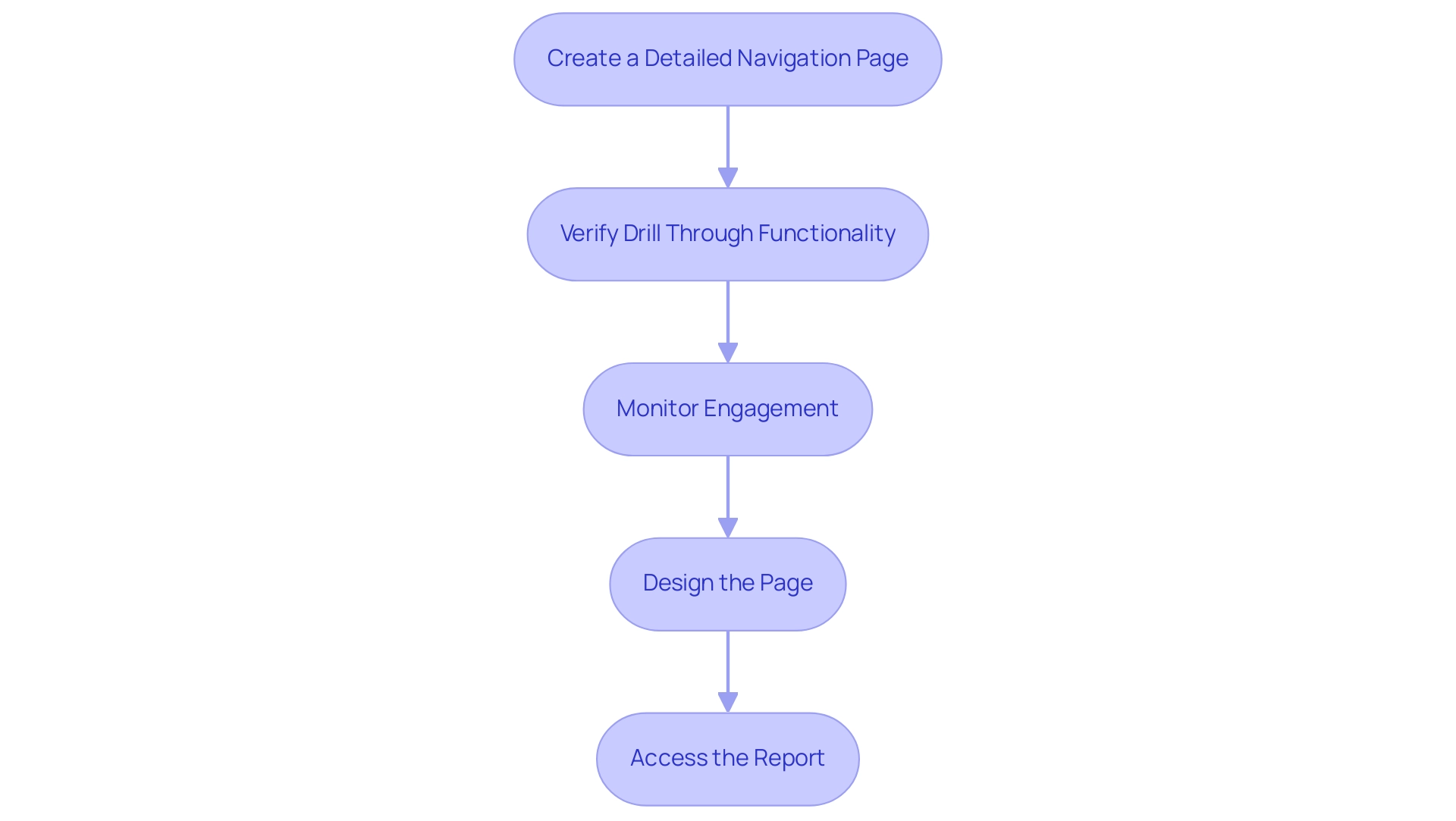
Best Practices for Effective Use of Cross-Report Drill Through
To maximize the effectiveness of cross-report drill through in Power BI while enhancing business productivity through Robotic Process Automation (RPA) and tailored AI solutions, consider implementing the following best practices:
-
Use Clear Naming Conventions: Establishing intuitive naming conventions for navigation pages and fields is crucial. This clarity assists individuals in navigating reports effortlessly, reducing confusion and enhancing their experience.
-
Limit Drill Through Options: Overloading users with too many drill through options can lead to frustration. Concentrate on the most pertinent areas to offer a streamlined experience that promotes deeper investigation of the information.
-
Provide Contextual Visuals: Incorporate visuals that contextualize the data being drilled through. For instance, while Power BI lacks a native Boxplot feature, consider using alternative methods like Column charts to visualize percentiles and quartiles, enhancing user understanding and enriching the analytical experience.
-
Leverage RPA for Efficiency: Implement RPA tools to automate repetitive tasks involved in report creation, significantly reducing time and errors. This can streamline the workflow, allowing your team to focus on strategic analysis rather than manual data entry.
-
Test with End Participants: Engaging actual participants in testing the drill through functionality can yield valuable feedback. This iterative process permits modifications that match the expectations of clients, ultimately enhancing satisfaction and usability. Based on recent customer satisfaction metrics, documents that undergo testing experience a 30% boost in effectiveness, which is crucial in addressing challenges such as time-consuming document creation and information inconsistencies.
-
Regularly Update Documents: Keeping documents current with the latest data and insights is essential for maintaining their relevance and value. Regular updates ensure users have access to the most pertinent information, fostering trust and reliance on the reports. As illustrated in the case study “Visualizing Metrics in Power BI,” metrics can be segmented by various variables, allowing for deeper analysis and more effective visualization.
By combining these best practices with RPA and customized AI solutions, you will create a more intuitive and effective cross report drill through Power BI experience. This approach not only enhances communication and operational efficiency but also drives data-driven insights and business growth.

Troubleshooting Common Issues with Cross-Report Drill Through
When encountering issues with cross-report exploration in Power BI, consider these effective troubleshooting strategies:
- Check Data Connections: Ensure that the data relationships between the documents are correctly established. Incorrect or absent relationships can result in access failures, which is a common issue users face and can impede the ability to utilize insights effectively.
- Verify Field Compatibility: Confirm that the fields utilized for drill through are compatible across documents. Mismatched data types can significantly hinder functionality and are often the root cause of many problems, contributing to data inconsistencies.
- Review Permissions: It’s essential to verify that users possess the necessary permissions to access both documents. Inadequate access permissions can hinder the functionality of the feature from working as intended, further complicating the document creation process.
- Test the Navigate Through Functionality: Leverage the ‘Test’ feature within Power BI to simulate the navigate through process and pinpoint any setup errors. This proactive step can enhance your troubleshooting success rates and reduce the time spent on documentation creation.
- Preserve Slicer Selections and Filters: When utilizing bookmarks, ensure that slicer selections and page-level filters are maintained, as this can greatly influence the navigation functionality and the clarity of insights provided.
- Consult Power BI Documentation: If problems continue, referring to the official Power BI documentation or seeking advice from community forums can offer valuable insights and solutions that might enhance your analysis processes.
By utilizing these troubleshooting suggestions, you can effectively resolve common issues and optimize the functionality of cross report drill through Power BI in your documents. Moreover, these strategies can result in clearer, actionable insights for stakeholders, ensuring that documents not only present information but also guide decision-making effectively.
As emphasized by user greggyb, who has gained significant recognition in the Power BI community with 3,798 points and multiple badges, interacting with other users can be invaluable for troubleshooting and overcoming frequent challenges. Additionally, consider implementing a high-level dashboard page as demonstrated in the case study on creating a high-level dashboard for cross report drill through Power BI. For instance, using specific metrics and visualizations can enhance the clarity of insights derived from the reports, making it easier for stakeholders to understand the data and take informed actions.
As Leila Gharani, a 7-time Microsoft MVP, wisely states,
I’m always learning new things too and finding better ways to help others succeed.
Embracing this mindset will not only improve your Power BI experience but also empower your team to achieve greater operational efficiency and drive informed decision-making.
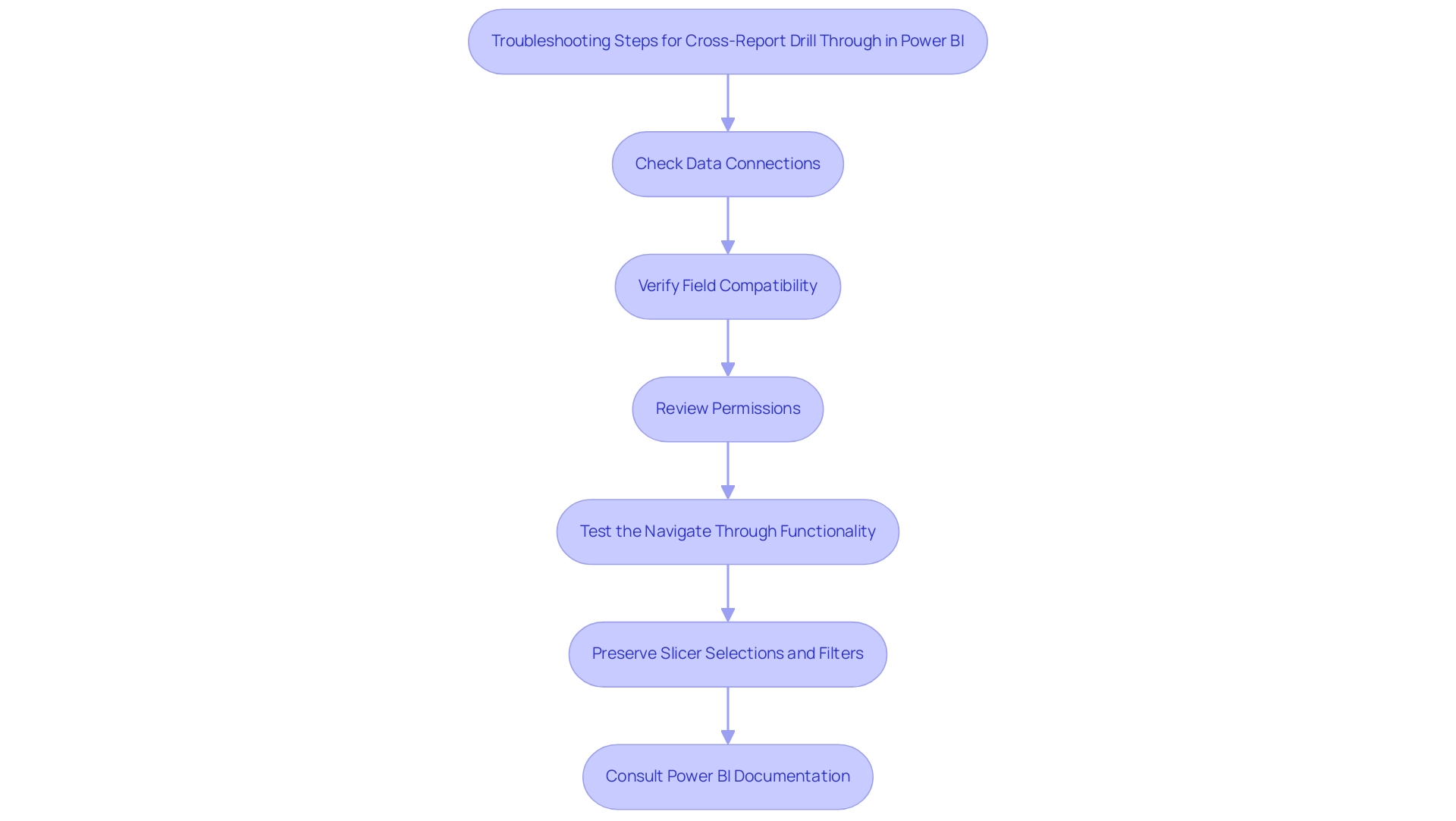
Conclusion
The cross-report drill through capability in Power BI transforms the way organizations interact with their data, enabling a seamless navigation experience that breaks down silos and fosters deeper insights. By effectively utilizing this feature, businesses can enhance their data storytelling, empowering decision-makers to derive actionable insights that drive operational efficiency. Implementing best practices, such as adopting clear naming conventions and regularly updating reports, ensures that users can navigate reports effortlessly and access the most relevant information.
Moreover, troubleshooting common issues and leveraging Robotic Process Automation (RPA) can further streamline the reporting process, allowing teams to focus on strategic analysis rather than manual tasks. The integration of tailored AI solutions not only enhances the effectiveness of cross-report drill through but also aligns data strategies with overarching business goals.
In an era where data-driven decision-making is paramount, organizations must embrace the full potential of Power BI’s capabilities. By fostering an interconnected approach to data analysis, businesses can not only improve their operational efficiency but also stay ahead in a competitive landscape. Now is the time to harness these tools and transform data into a powerful asset that propels growth and innovation.
